Surgical fastener apparatus
Shah , et al. April 6, 2
U.S. patent number 10,966,717 [Application Number 15/377,086] was granted by the patent office on 2021-04-06 for surgical fastener apparatus. This patent grant is currently assigned to Covidien LP. The grantee listed for this patent is Covidien LP. Invention is credited to Stanislaw Kostrzewski, Sachin Shah.
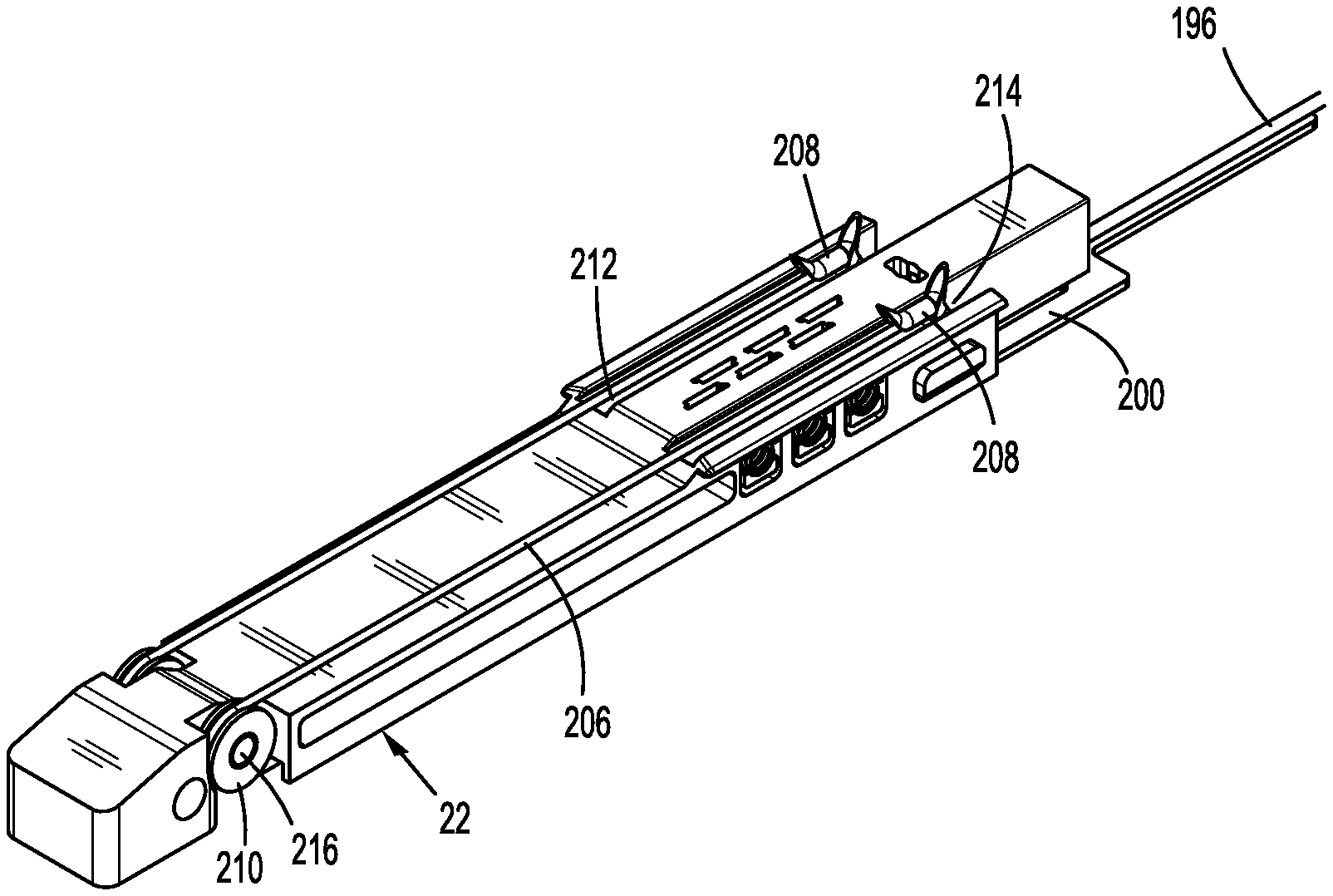
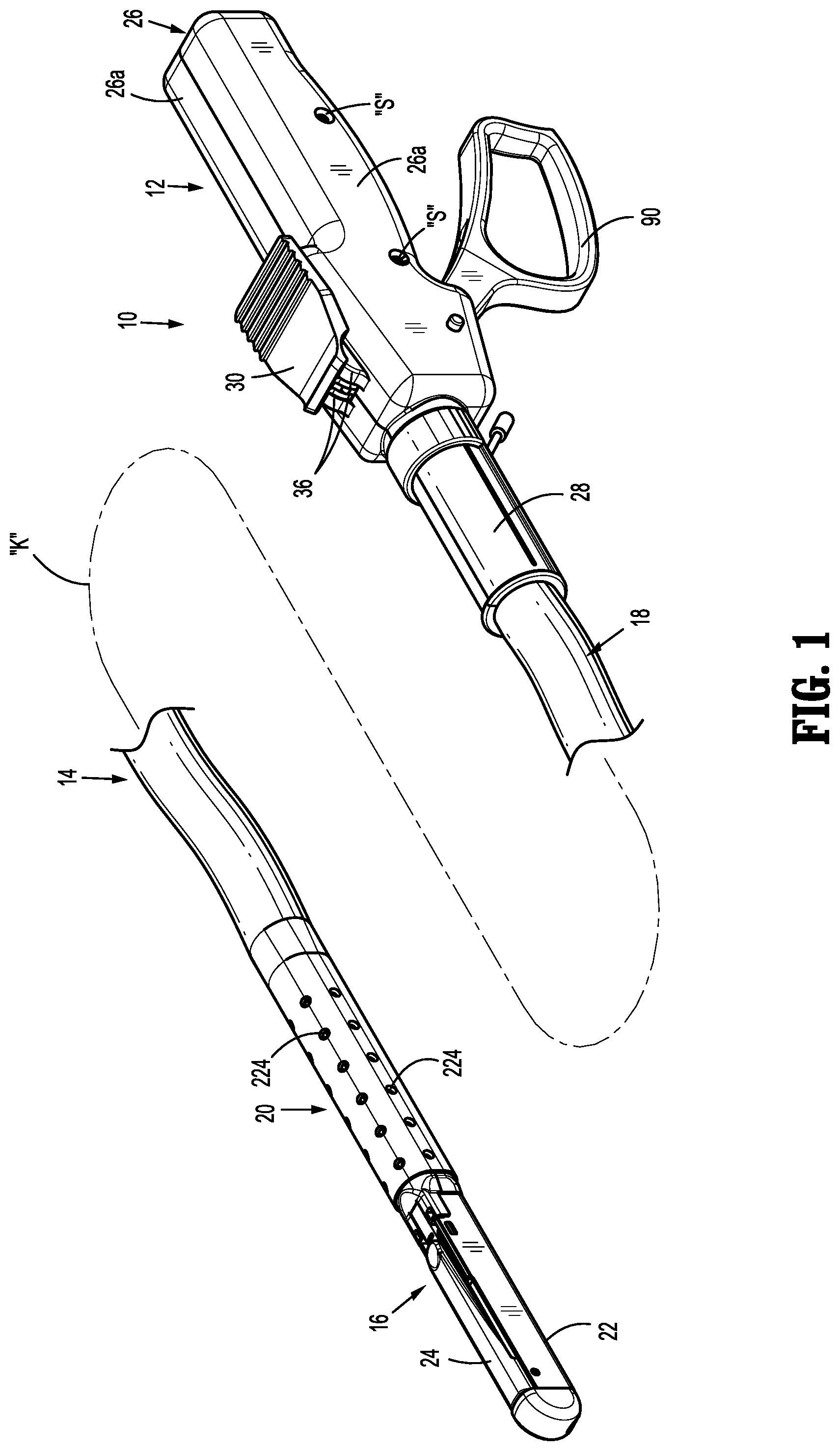
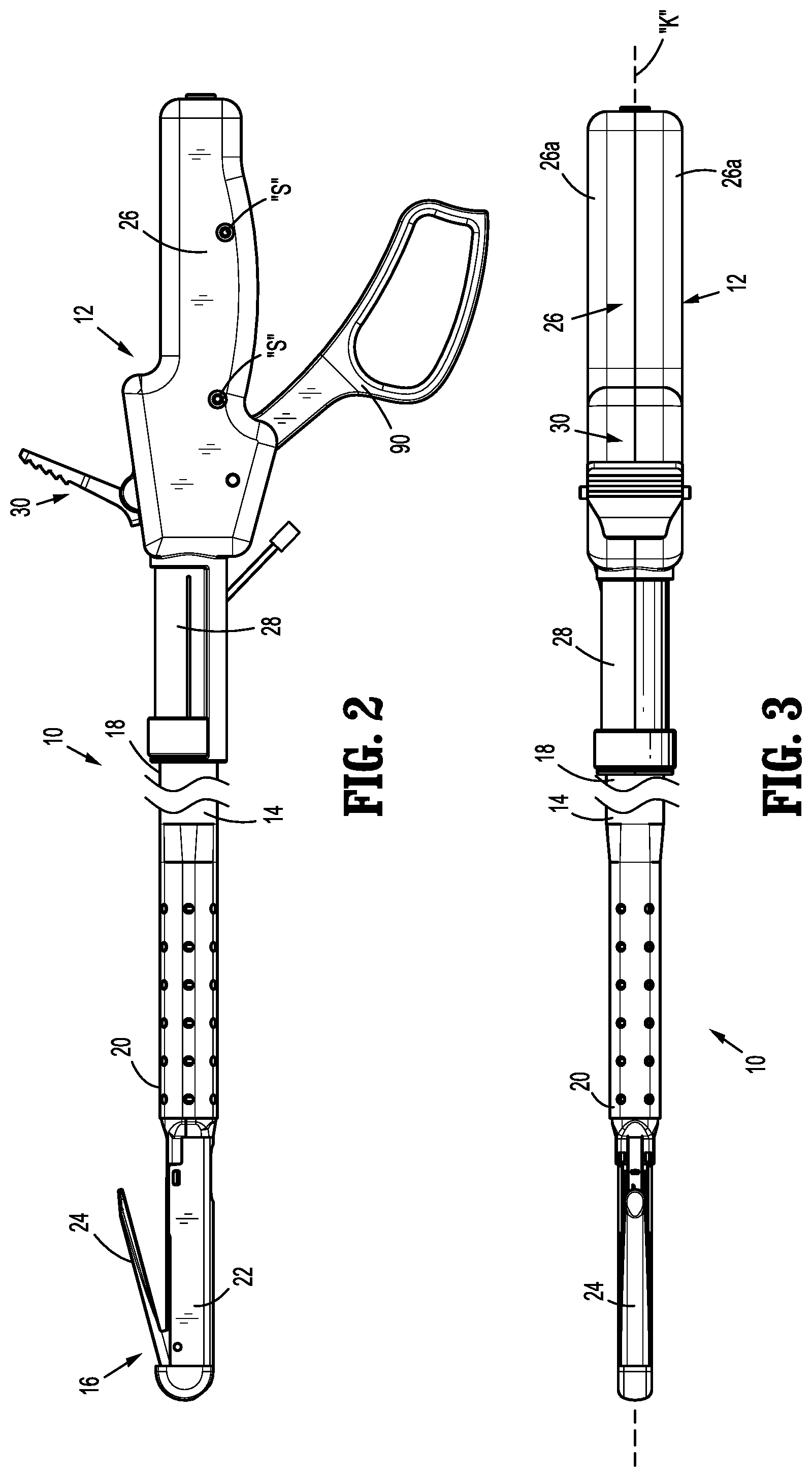
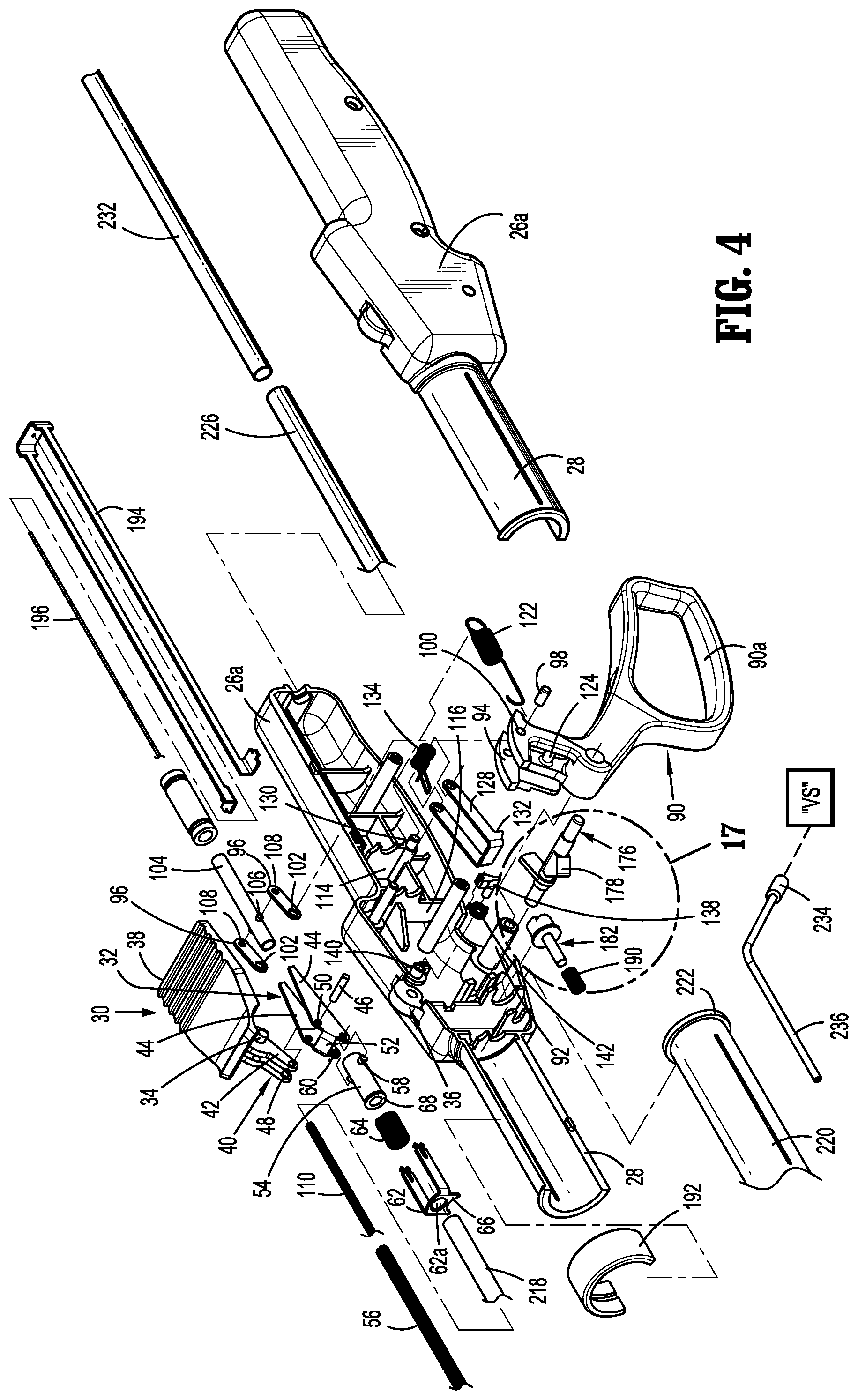
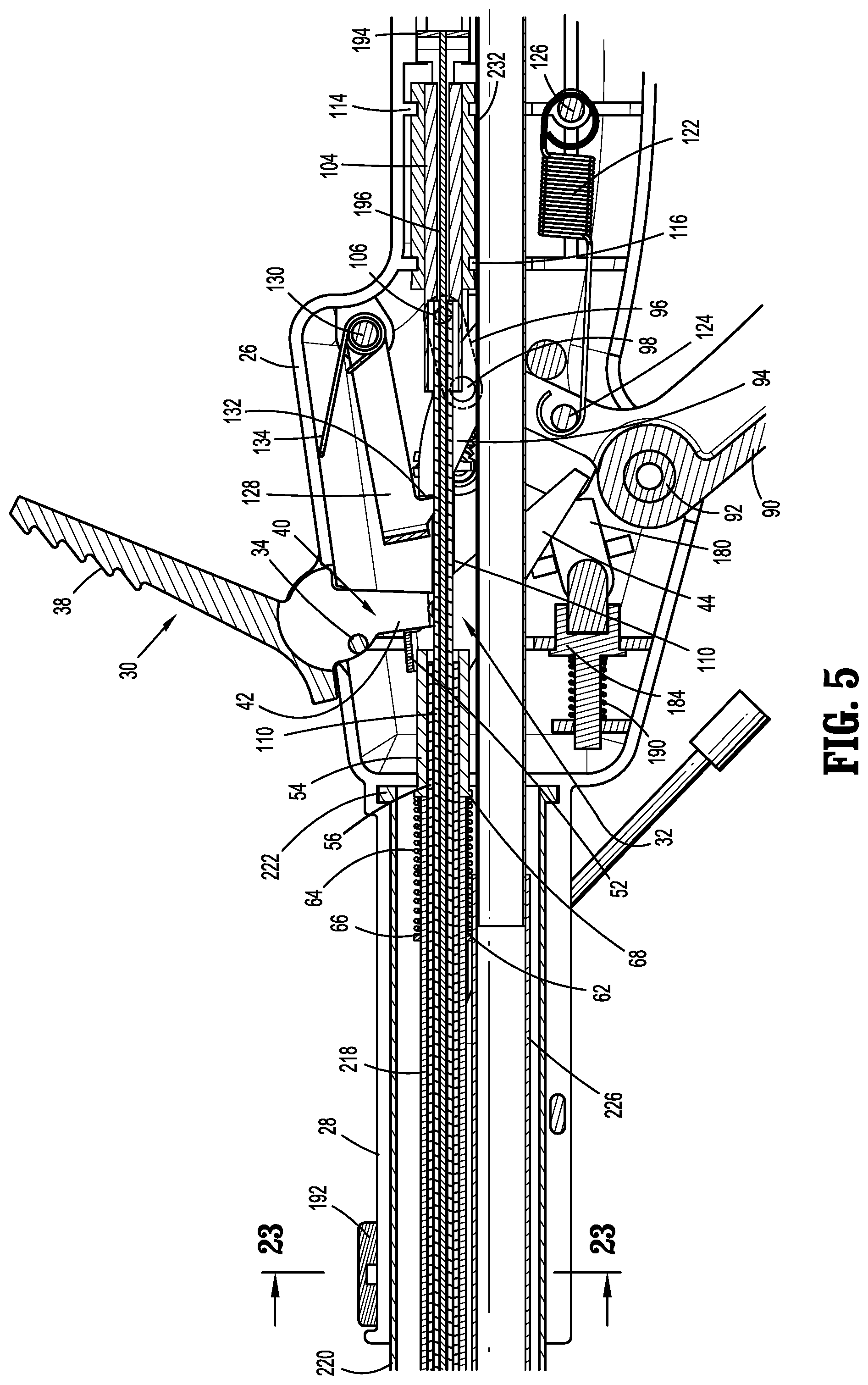
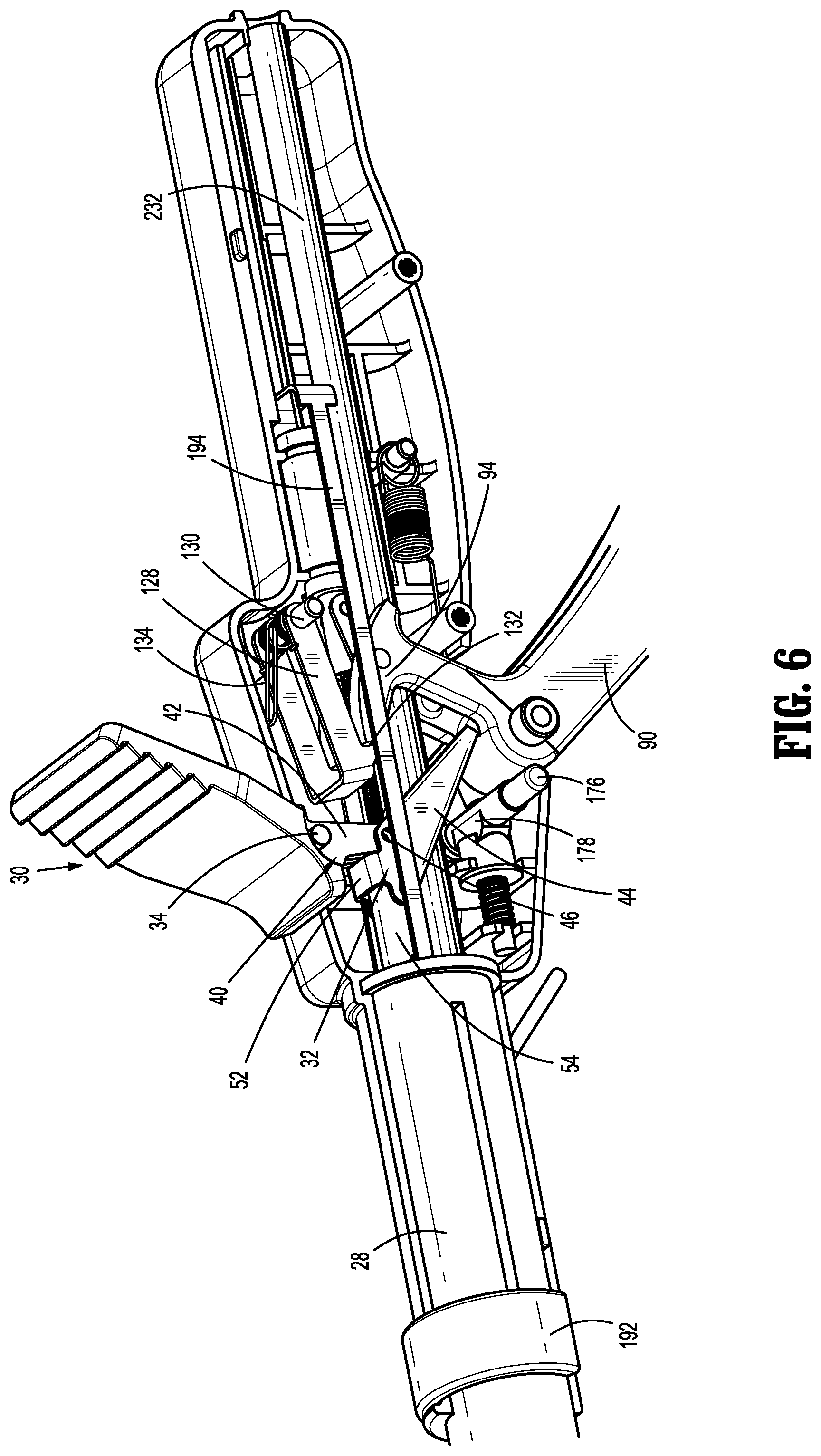
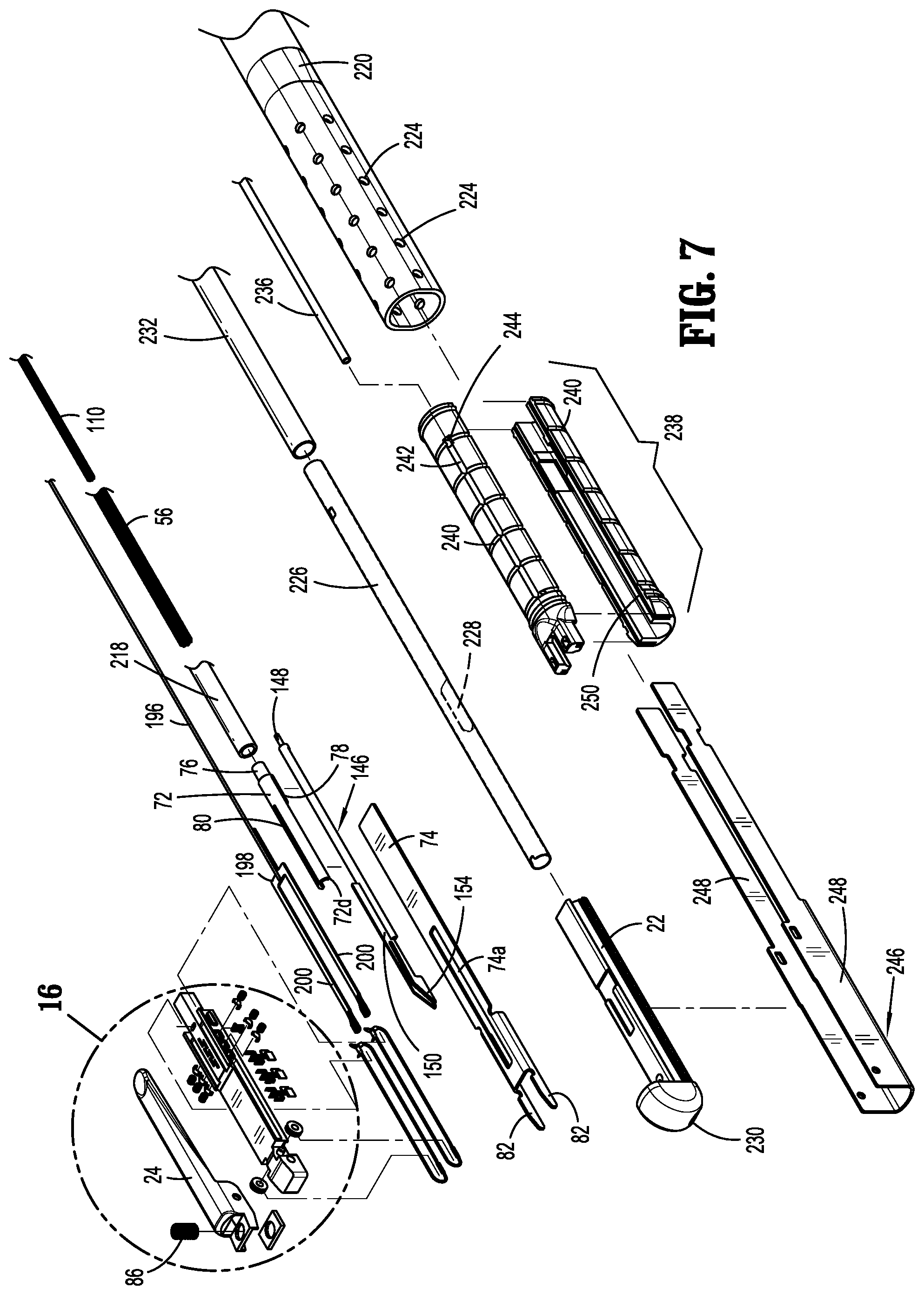
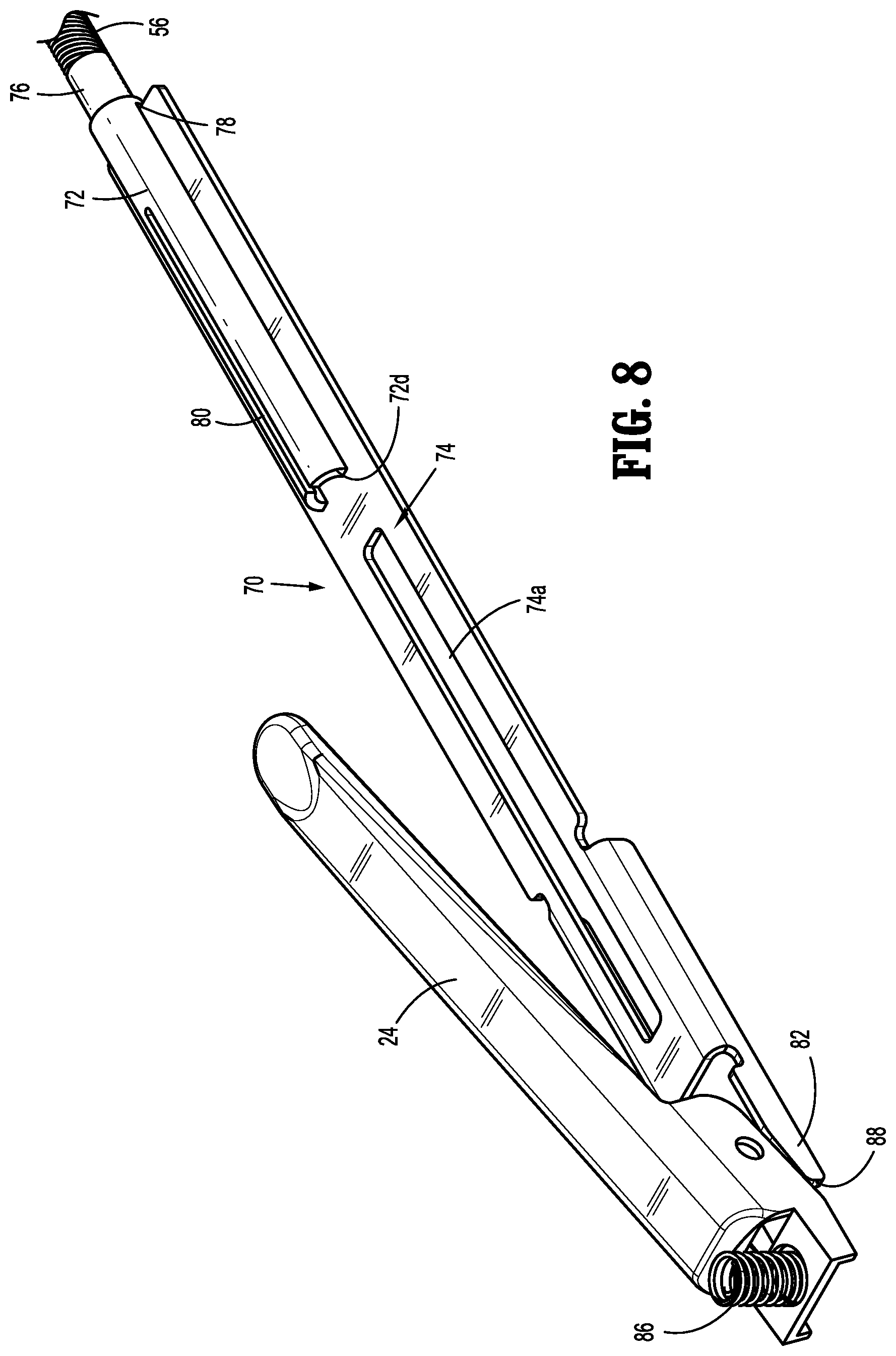
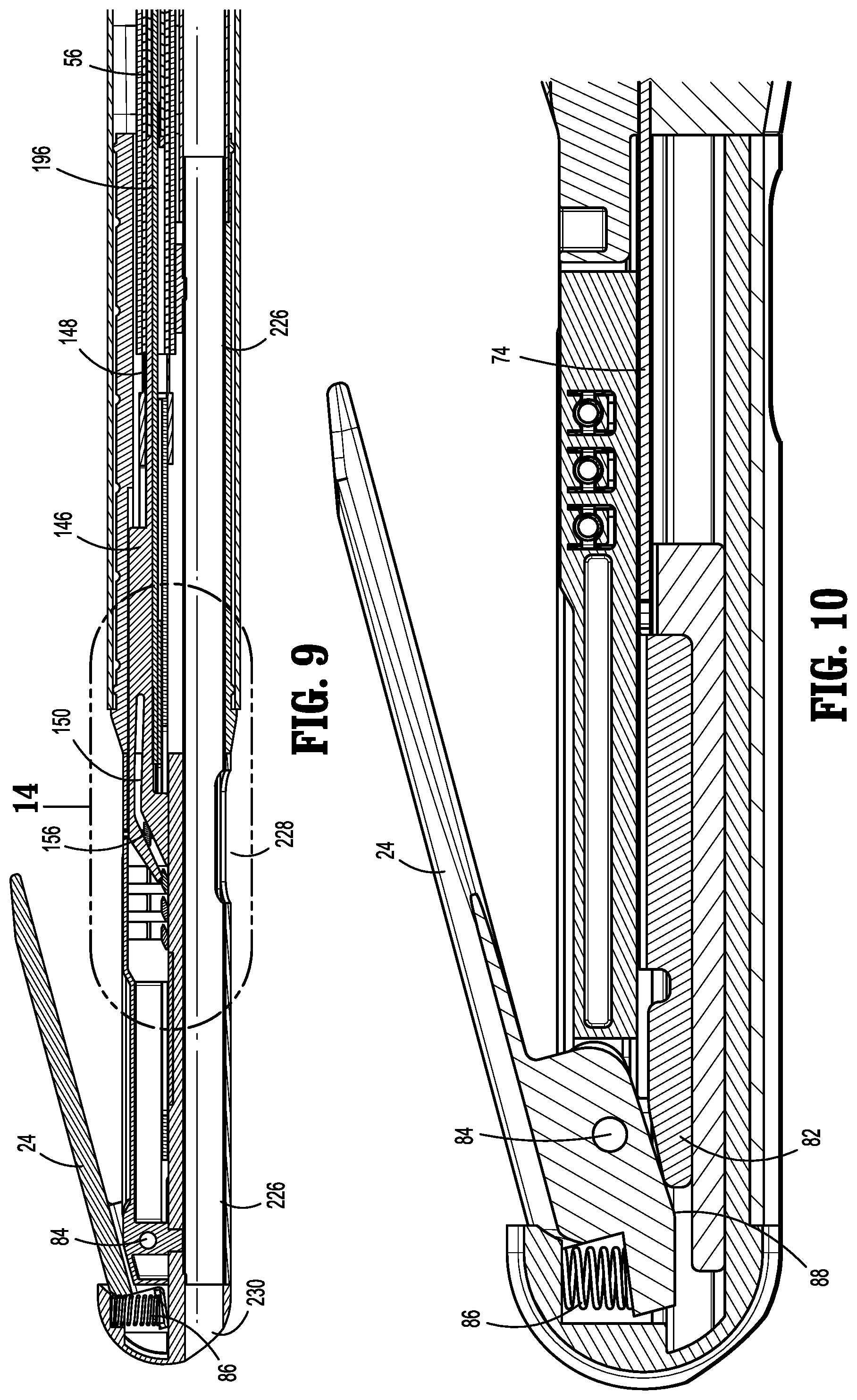
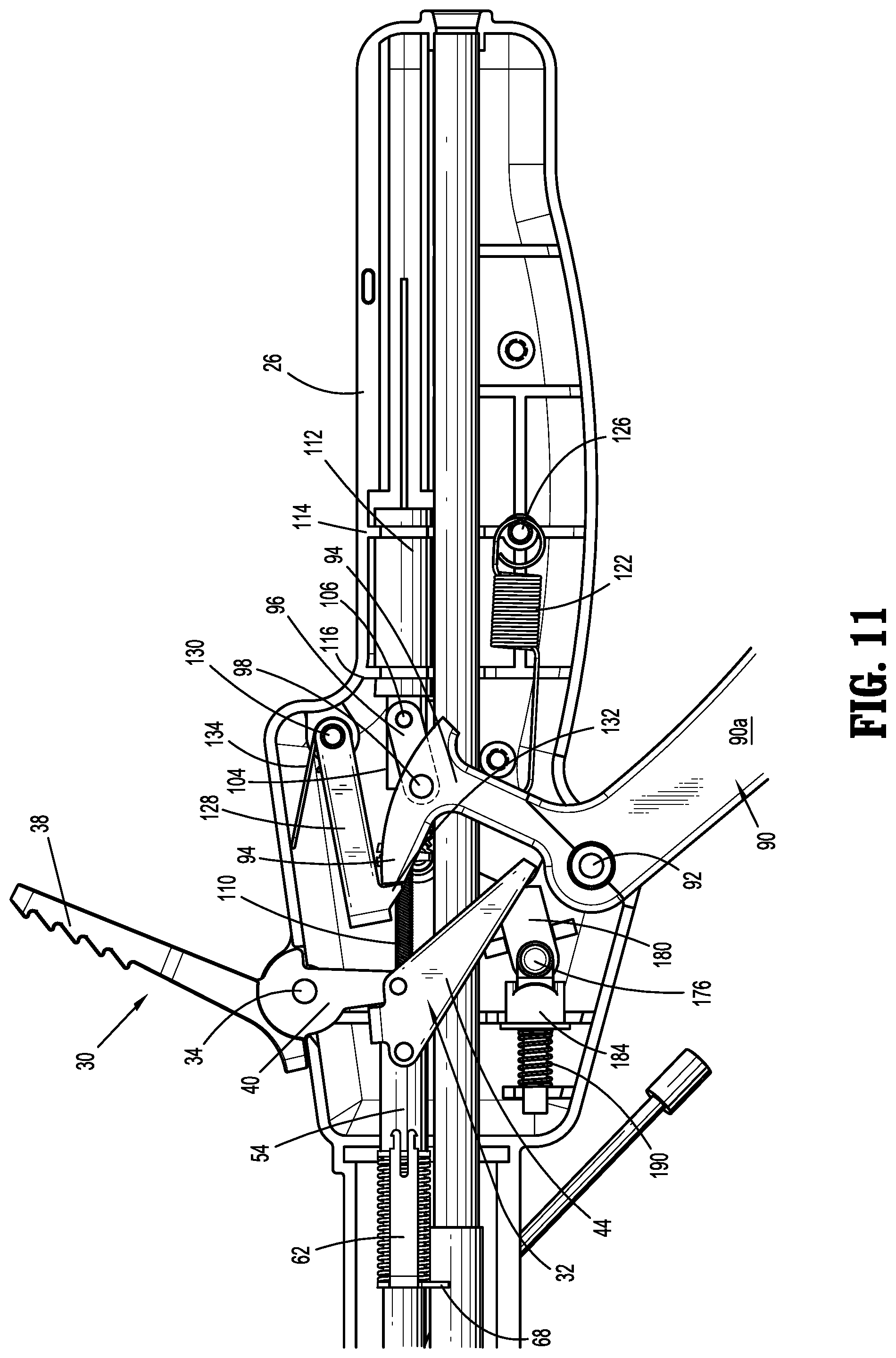
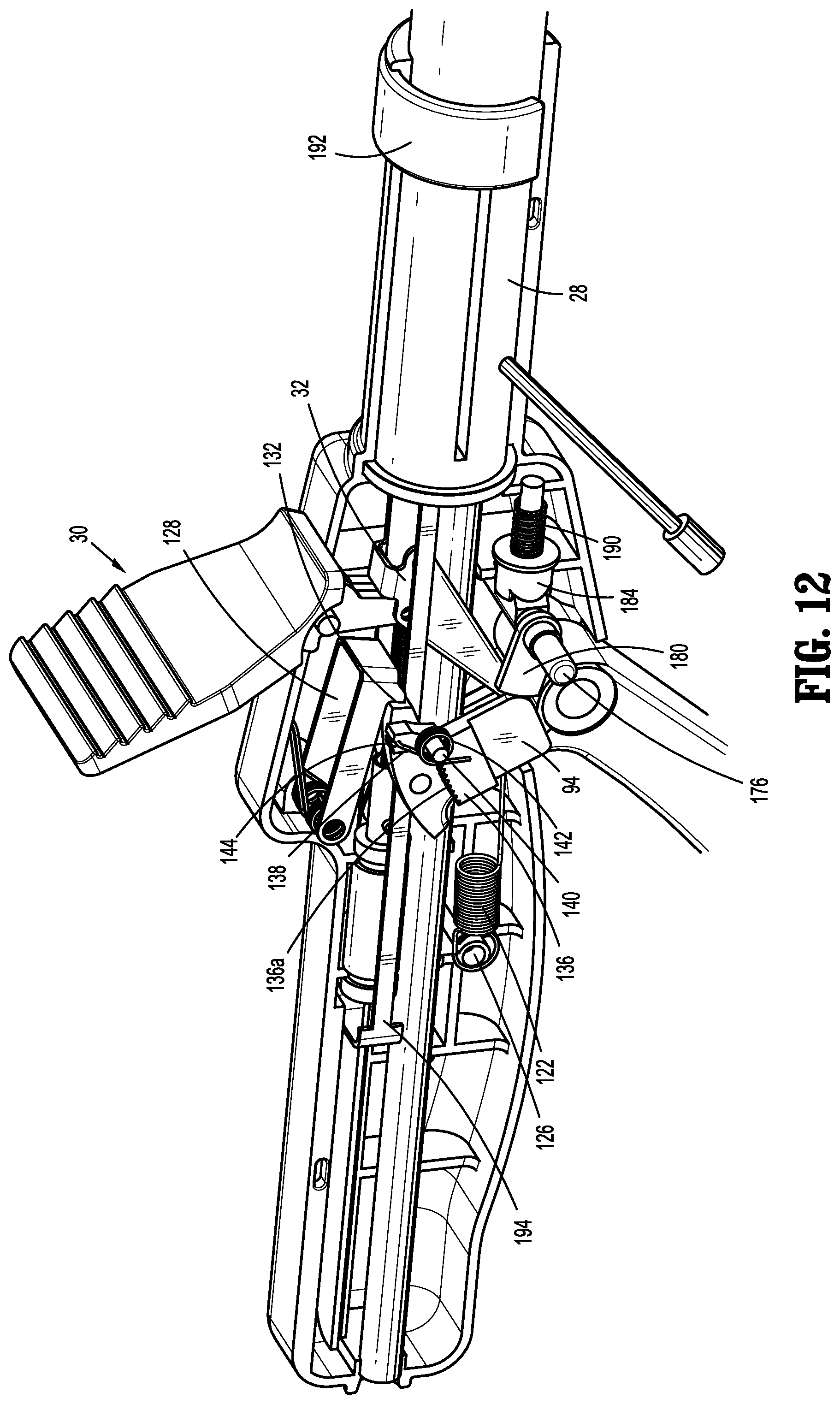
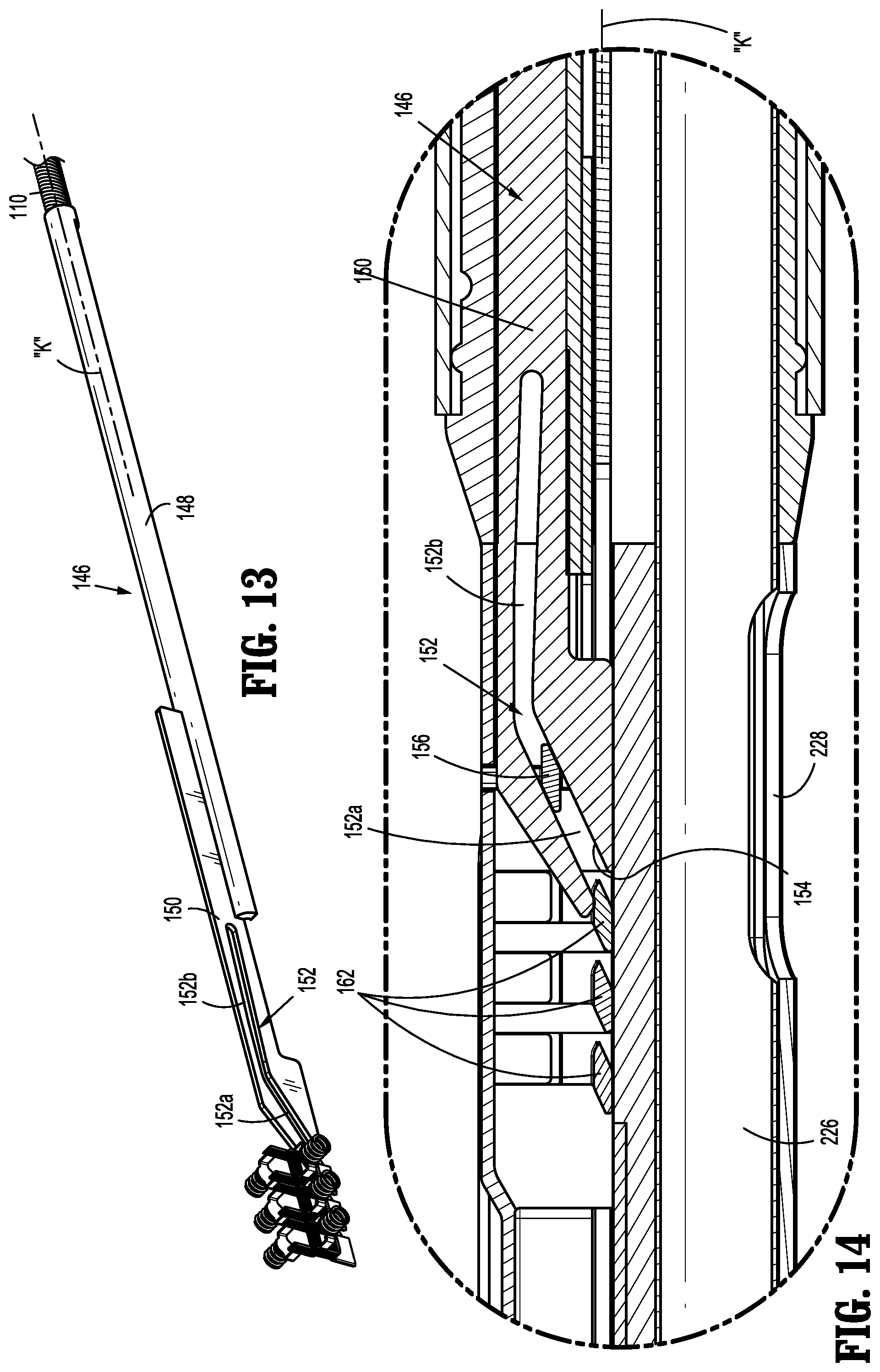
View All Diagrams
| United States Patent | 10,966,717 |
| Shah , et al. | April 6, 2021 |
Surgical fastener apparatus
Abstract
A surgical fastener apparatus includes a handle, a flexible elongate segment and an end effector having a fastener cartridge with a plurality of fasteners and an anvil, an approximator member movable relative to the longitudinal axis to cause relative movement of the fastener cartridge and the anvil between an open condition and an approximated condition, a fastener drive to deploy the fasteners from the fastener cartridge for crimping by the anvil, at least one tissue grasper at least partially extending along the end effector and movable to engage tissue and draw the tissue between the fastener cartridge and the anvil when in the open condition, and at least one manual actuator to actuate at least one of the approximator member, the fastener drive or the at least one tissue grasper.
| Inventors: | Shah; Sachin (Milford, CT), Kostrzewski; Stanislaw (Newtown, CT) | ||||||||||
|---|---|---|---|---|---|---|---|---|---|---|---|
| Applicant: |
|
||||||||||
| Assignee: | Covidien LP (Mansfield,
MA) |
||||||||||
| Family ID: | 1000005466991 | ||||||||||
| Appl. No.: | 15/377,086 | ||||||||||
| Filed: | December 13, 2016 |
Prior Publication Data
| Document Identifier | Publication Date | |
|---|---|---|
| US 20170196556 A1 | Jul 13, 2017 | |
Related U.S. Patent Documents
| Application Number | Filing Date | Patent Number | Issue Date | ||
|---|---|---|---|---|---|
| 62275993 | Jan 7, 2016 | ||||
| Current U.S. Class: | 1/1 |
| Current CPC Class: | A61B 17/072 (20130101); A61B 17/07207 (20130101); A61B 17/30 (20130101); A61B 17/00234 (20130101); A61B 17/1285 (20130101); A61B 2017/07257 (20130101); A61B 2017/07214 (20130101); A61B 2017/00827 (20130101); A61B 2017/00477 (20130101); A61B 2017/00278 (20130101); A61B 2017/07271 (20130101); A61B 2017/07228 (20130101); A61B 1/00087 (20130101); A61B 2017/00473 (20130101); A61B 90/37 (20160201); A61B 2017/308 (20130101); A61B 2017/306 (20130101); A61B 1/00154 (20130101) |
| Current International Class: | A61B 17/00 (20060101); A61B 17/30 (20060101); A61B 17/072 (20060101); A61B 17/128 (20060101); A61B 1/00 (20060101); A61B 90/00 (20160101) |
| Field of Search: | ;606/150 |
References Cited [Referenced By]
U.S. Patent Documents
| 3079606 | March 1963 | Bobrov et al. |
| 3490675 | January 1970 | Green et al. |
| 3499591 | March 1970 | Green |
| 3777538 | December 1973 | Weatherly et al. |
| 3882854 | May 1975 | Hulka et al. |
| 4027510 | June 1977 | Hiltebrandt |
| 4086926 | May 1978 | Green et al. |
| 4241861 | December 1980 | Fleischer |
| 4244372 | January 1981 | Kapitanov et al. |
| 4429695 | February 1984 | Green |
| 4459978 | July 1984 | Kotsanis |
| 4505414 | March 1985 | Filipi |
| 4506669 | March 1985 | Blake, III |
| 4520817 | June 1985 | Green |
| 4589413 | May 1986 | Malyshev et al. |
| 4591085 | May 1986 | Di Giovanni |
| 4596351 | June 1986 | Fedotov et al. |
| 4602634 | July 1986 | Barkley |
| 4605001 | August 1986 | Rothfuss et al. |
| 4606345 | August 1986 | Dorband |
| 4608981 | September 1986 | Rothfuss et al. |
| 4610383 | September 1986 | Rothfuss et al. |
| 4633861 | January 1987 | Chow et al. |
| 4633874 | January 1987 | Chow et al. |
| 4671445 | June 1987 | Barker et al. |
| 4700703 | October 1987 | Resnick et al. |
| 4703887 | November 1987 | Clanton et al. |
| 4728020 | March 1988 | Green et al. |
| 4752024 | June 1988 | Green et al. |
| 4773420 | September 1988 | Green |
| 4784137 | November 1988 | Kulik et al. |
| 4863088 | September 1989 | Redmond et al. |
| 4869415 | September 1989 | Fox |
| 4892244 | January 1990 | Fox et al. |
| 4938408 | July 1990 | Bedi |
| 4955959 | September 1990 | Tompkins et al. |
| 4978049 | December 1990 | Green |
| 4991764 | February 1991 | Mericle |
| 5014899 | May 1991 | Presty et al. |
| 5031814 | July 1991 | Tompkins et al. |
| 5040715 | August 1991 | Green et al. |
| 5065929 | November 1991 | Schulze et al. |
| 5071430 | December 1991 | de Salis et al. |
| 5074454 | December 1991 | Peters |
| 5083695 | January 1992 | Foslien et al. |
| 5084057 | January 1992 | Green et al. |
| 5106008 | April 1992 | Tompkins et al. |
| 5111987 | May 1992 | Moeinzadeh et al. |
| 5129570 | July 1992 | Schulze et al. |
| 5141144 | August 1992 | Foslien et al. |
| 5156315 | October 1992 | Green et al. |
| 5156614 | October 1992 | Green et al. |
| 5163943 | November 1992 | Mohiuddin et al. |
| 5170925 | December 1992 | Madden et al. |
| 5171247 | December 1992 | Hughett et al. |
| 5173133 | December 1992 | Morin et al. |
| 5180092 | January 1993 | Crainich |
| 5188274 | February 1993 | Moeinzadeh et al. |
| 5220928 | June 1993 | Oddsen et al. |
| 5221036 | June 1993 | Takase |
| 5242457 | September 1993 | Akopov et al. |
| 5246156 | September 1993 | Rothfuss et al. |
| 5253793 | October 1993 | Green et al. |
| 5263629 | November 1993 | Trumbull et al. |
| RE34519 | January 1994 | Fox et al. |
| 5275323 | January 1994 | Schulze et al. |
| 5282807 | February 1994 | Knoepfler |
| 5289963 | March 1994 | McGarry et al. |
| 5307976 | May 1994 | Olson et al. |
| 5308576 | May 1994 | Green et al. |
| 5312023 | May 1994 | Green et al. |
| 5318221 | June 1994 | Green et al. |
| 5326013 | July 1994 | Green et al. |
| 5328077 | July 1994 | Lou |
| 5330486 | July 1994 | Wilk |
| 5332142 | July 1994 | Robinson et al. |
| 5336221 | August 1994 | Anderson |
| 5336232 | August 1994 | Green et al. |
| 5344061 | September 1994 | Crainich |
| 5352238 | October 1994 | Green et al. |
| 5356064 | October 1994 | Green et al. |
| 5358506 | October 1994 | Green et al. |
| 5364001 | November 1994 | Bryan |
| 5364002 | November 1994 | Green et al. |
| 5364003 | November 1994 | Williamson, IV |
| 5366133 | November 1994 | Geiste |
| 5376095 | December 1994 | Ortiz |
| 5379933 | January 1995 | Green et al. |
| 5381943 | January 1995 | Allen et al. |
| 5382255 | January 1995 | Castro et al. |
| 5383880 | January 1995 | Hooven |
| 5389098 | February 1995 | Tsuruta |
| 5395033 | March 1995 | Byrne et al. |
| 5395034 | March 1995 | Allen et al. |
| 5397046 | March 1995 | Savage et al. |
| 5397324 | March 1995 | Carroll et al. |
| 5403312 | April 1995 | Yates et al. |
| 5403326 | April 1995 | Harrison |
| 5405072 | April 1995 | Zlock et al. |
| 5407293 | April 1995 | Crainich |
| 5413268 | May 1995 | Green et al. |
| 5415334 | May 1995 | Williamson et al. |
| 5415335 | May 1995 | Knodell, Jr. |
| 5417361 | May 1995 | Williamson, IV |
| 5423471 | June 1995 | Mastri et al. |
| 5425737 | June 1995 | Burbank |
| 5425745 | June 1995 | Green et al. |
| 5431322 | July 1995 | Green et al. |
| 5431323 | July 1995 | Smith et al. |
| 5433721 | July 1995 | Hooven |
| 5441193 | August 1995 | Gravener |
| 5445304 | August 1995 | Plyley et al. |
| 5447265 | September 1995 | Vidal et al. |
| 5452837 | September 1995 | Williamson, IV et al. |
| 5454822 | October 1995 | Schob |
| 5456401 | October 1995 | Green et al. |
| 5464300 | November 1995 | Crainich |
| 5464414 | November 1995 | Cziffer |
| 5465895 | November 1995 | Knodel et al. |
| 5467911 | November 1995 | Tsuruta et al. |
| 5470007 | November 1995 | Plyley et al. |
| 5470010 | November 1995 | Rothfuss et al. |
| 5472132 | December 1995 | Savage et al. |
| 5474566 | December 1995 | Alesi et al. |
| 5476206 | December 1995 | Green et al. |
| 5478003 | December 1995 | Green et al. |
| 5480089 | January 1996 | Blewett |
| 5482197 | January 1996 | Green et al. |
| 5484095 | January 1996 | Green et al. |
| 5484451 | January 1996 | Akopov et al. |
| 5485947 | January 1996 | Olson et al. |
| 5485952 | January 1996 | Fontayne |
| 5486185 | January 1996 | Freitas et al. |
| 5487499 | January 1996 | Sorrentino et al. |
| 5487500 | January 1996 | Knodel et al. |
| 5489058 | February 1996 | Plyley et al. |
| 5490856 | February 1996 | Person et al. |
| 5497933 | March 1996 | DeFonzo et al. |
| 5501689 | March 1996 | Green et al. |
| 5505363 | April 1996 | Green et al. |
| 5507426 | April 1996 | Young et al. |
| 5518163 | May 1996 | Hooven |
| 5518164 | May 1996 | Hooven |
| 5529235 | June 1996 | Boiarski et al. |
| 5531744 | July 1996 | Nardella et al. |
| 5535934 | July 1996 | Boiarski et al. |
| 5535935 | July 1996 | Vidal et al. |
| 5535937 | July 1996 | Boiarski et al. |
| 5540375 | July 1996 | Bolanos |
| 5542594 | August 1996 | McKean et al. |
| 5549628 | August 1996 | Cooper et al. |
| 5551622 | September 1996 | Yoon |
| 5553765 | September 1996 | Knodel et al. |
| 5554164 | September 1996 | Wilson et al. |
| 5554169 | September 1996 | Green et al. |
| 5560530 | October 1996 | Bolanos et al. |
| 5560532 | October 1996 | DeFonzo et al. |
| 5562239 | October 1996 | Boiarski et al. |
| 5562241 | October 1996 | Knodel et al. |
| 5562682 | October 1996 | Oberlin et al. |
| 5562701 | October 1996 | Huitema |
| 5564615 | October 1996 | Bishop et al. |
| 5571116 | November 1996 | Bolanos et al. |
| 5573169 | November 1996 | Green et al. |
| 5573543 | November 1996 | Akopov et al. |
| 5575799 | November 1996 | Bolanos et al. |
| 5575803 | November 1996 | Cooper et al. |
| 5577654 | November 1996 | Bishop |
| 5584425 | December 1996 | Savage et al. |
| 5586711 | December 1996 | Plyley et al. |
| 5588580 | December 1996 | Paul et al. |
| 5588581 | December 1996 | Conlon et al. |
| 5597107 | January 1997 | Knodel et al. |
| 5601224 | February 1997 | Bishop et al. |
| 5607095 | March 1997 | Smith et al. |
| 5615820 | April 1997 | Viola |
| 5618291 | April 1997 | Thompson et al. |
| 5624452 | April 1997 | Yates |
| 5626587 | May 1997 | Bishop et al. |
| 5628446 | May 1997 | Geiste et al. |
| 5630539 | May 1997 | Plyley et al. |
| 5630540 | May 1997 | Blewett |
| 5630541 | May 1997 | Williamson, IV et al. |
| 5632432 | May 1997 | Schulze et al. |
| 5634584 | June 1997 | Okorocha et al. |
| 5636780 | June 1997 | Green et al. |
| 5645209 | July 1997 | Green et al. |
| 5647526 | July 1997 | Green et al. |
| 5651491 | July 1997 | Heaton et al. |
| 5653373 | August 1997 | Green et al. |
| 5653374 | August 1997 | Young et al. |
| 5653721 | August 1997 | Knodel et al. |
| 5655698 | August 1997 | Yoon |
| 5657921 | August 1997 | Young et al. |
| 5658300 | August 1997 | Bito et al. |
| 5662258 | September 1997 | Knodel et al. |
| 5662259 | September 1997 | Yoon |
| 5662260 | September 1997 | Yoon |
| 5662662 | September 1997 | Bishop et al. |
| 5662666 | September 1997 | Onuki et al. |
| 5665085 | September 1997 | Nardella |
| 5665100 | September 1997 | Yoon |
| 5667517 | September 1997 | Hooven |
| 5669544 | September 1997 | Schulze et al. |
| 5673840 | October 1997 | Schulze et al. |
| 5673841 | October 1997 | Schulze et al. |
| 5673842 | October 1997 | Bittner et al. |
| 5674230 | October 1997 | Tovey |
| 5676674 | October 1997 | Bolanos et al. |
| 5680981 | October 1997 | Mililli et al. |
| 5680982 | October 1997 | Schulze et al. |
| 5680983 | October 1997 | Plyley et al. |
| 5690269 | November 1997 | Bolanos et al. |
| 5692668 | December 1997 | Schulze et al. |
| 5697542 | December 1997 | Knodel et al. |
| 5702409 | December 1997 | Raybum et al. |
| 5704534 | January 1998 | Huitema et al. |
| 5706997 | January 1998 | Green et al. |
| 5709334 | January 1998 | Sorrentino et al. |
| 5711472 | January 1998 | Bryan |
| 5713505 | February 1998 | Huitema |
| 5715988 | February 1998 | Palmer |
| 5716366 | February 1998 | Yates |
| 5718359 | February 1998 | Palmer et al. |
| 5725536 | March 1998 | Oberlin et al. |
| 5725554 | March 1998 | Simon et al. |
| 5728110 | March 1998 | Vidal et al. |
| 5732806 | March 1998 | Foshee et al. |
| 5735848 | April 1998 | Yates et al. |
| 5743456 | April 1998 | Jones et al. |
| 5749893 | May 1998 | Vidal et al. |
| 5752644 | May 1998 | Bolanos et al. |
| 5762255 | June 1998 | Chrisman et al. |
| 5762256 | June 1998 | Mastri et al. |
| 5769303 | June 1998 | Knodel et al. |
| 5769892 | June 1998 | Kingwell |
| 5772099 | June 1998 | Gravener |
| 5772673 | June 1998 | Cuny et al. |
| 5779130 | July 1998 | Alesi et al. |
| 5779131 | July 1998 | Knodel et al. |
| 5779132 | July 1998 | Knodel et al. |
| 5782396 | July 1998 | Mastri et al. |
| 5782397 | July 1998 | Koukline |
| 5782834 | July 1998 | Lucey et al. |
| 5785232 | July 1998 | Vidal et al. |
| 5797536 | August 1998 | Smith et al. |
| 5797537 | August 1998 | Oberlin et al. |
| 5797538 | August 1998 | Heaton et al. |
| 5810811 | September 1998 | Yates et al. |
| 5810855 | September 1998 | Raybum et al. |
| 5814055 | September 1998 | Knodel et al. |
| 5814057 | September 1998 | Oi et al. |
| 5816471 | October 1998 | Plyley et al. |
| 5817109 | October 1998 | McGarry et al. |
| 5820009 | October 1998 | Melling et al. |
| 5823066 | October 1998 | Huitema et al. |
| 5826776 | October 1998 | Schulze et al. |
| 5829662 | November 1998 | Allen et al. |
| 5833695 | November 1998 | Yoon |
| 5836147 | November 1998 | Schnipke |
| 5862972 | January 1999 | Green et al. |
| 5865361 | February 1999 | Milliman et al. |
| 5871135 | February 1999 | Williamson, IV et al. |
| 5873873 | February 1999 | Smith et al. |
| 5878938 | March 1999 | Bittner et al. |
| 5893506 | April 1999 | Powell |
| 5894979 | April 1999 | Powell |
| 5897562 | April 1999 | Bolanos et al. |
| 5901895 | May 1999 | Heaton et al. |
| 5911352 | June 1999 | Racenet et al. |
| 5911353 | June 1999 | Bolanos et al. |
| 5918791 | July 1999 | Sorrentino et al. |
| 5919198 | July 1999 | Graves, Jr. et al. |
| 5922001 | July 1999 | Yoon |
| 5931847 | August 1999 | Bittner et al. |
| 5941442 | August 1999 | Geiste et al. |
| 5954259 | September 1999 | Viola et al. |
| 5964774 | October 1999 | McKean et al. |
| 5980510 | November 1999 | Tsonton et al. |
| 5988479 | November 1999 | Palmer |
| 6004335 | December 1999 | Vaitekunas et al. |
| 6010054 | January 2000 | Johnson et al. |
| 6032849 | March 2000 | Mastri et al. |
| 6045560 | April 2000 | McKean et al. |
| 6063097 | May 2000 | Oi et al. |
| 6079606 | June 2000 | Milliman et al. |
| 6083241 | July 2000 | Longo |
| 6099551 | August 2000 | Gabbay |
| 6109500 | August 2000 | Alli et al. |
| 6131789 | October 2000 | Schulze et al. |
| 6131790 | October 2000 | Piraka |
| 6155473 | December 2000 | Tompkins et al. |
| 6197017 | March 2001 | Brock et al. |
| 6202914 | March 2001 | Geiste et al. |
| 6241139 | June 2001 | Milliman et al. |
| 6250532 | June 2001 | Green et al. |
| 6258107 | July 2001 | Balazs |
| 6264086 | July 2001 | McGuckin, Jr. |
| 6264087 | July 2001 | Whitman |
| 6279809 | August 2001 | Nicolo |
| 6315183 | November 2001 | Piraka |
| 6315184 | November 2001 | Whitman |
| 6325810 | December 2001 | Hamilton et al. |
| 6330965 | December 2001 | Milliman et al. |
| 6391038 | May 2002 | Vargas et al. |
| 6398797 | June 2002 | Bombard et al. |
| 6436097 | August 2002 | Nardella |
| 6439446 | August 2002 | Perry et al. |
| 6443973 | September 2002 | Whitman |
| 6478804 | November 2002 | Vargas et al. |
| 6488196 | December 2002 | Fenton, Jr. |
| 6503257 | January 2003 | Grant et al. |
| 6505768 | January 2003 | Whitman |
| 6544274 | April 2003 | Danitz et al. |
| 6554844 | April 2003 | Lee et al. |
| 6565554 | May 2003 | Niemeyer |
| 6587750 | July 2003 | Gerbi et al. |
| 6592597 | July 2003 | Grant et al. |
| 6594552 | July 2003 | Gerbi et al. |
| 6602252 | August 2003 | Mollenauer |
| 6619529 | September 2003 | Green et al. |
| D480808 | October 2003 | Wells et al. |
| 6644532 | November 2003 | Green et al. |
| 6656193 | December 2003 | Grant et al. |
| 6669073 | December 2003 | Milliman et al. |
| 6681978 | January 2004 | Geiste et al. |
| 6698643 | March 2004 | Whitman |
| 6716232 | April 2004 | Vidal et al. |
| 6722552 | April 2004 | Fenton, Jr. |
| 6755338 | June 2004 | Hahnen et al. |
| 6783524 | August 2004 | Anderson et al. |
| 6786382 | September 2004 | Hoffman |
| 6817509 | November 2004 | Geiste et al. |
| 6830174 | December 2004 | Hillstead et al. |
| 6835199 | December 2004 | McGuckin, Jr. et al. |
| 6843403 | January 2005 | Whitman |
| RE38708 | March 2005 | Bolanos et al. |
| 6877647 | April 2005 | Green et al. |
| 6889116 | May 2005 | Jinno |
| 6905057 | June 2005 | Swayze et al. |
| 6945444 | September 2005 | Gresham et al. |
| 6953138 | October 2005 | Dworak et al. |
| 6953139 | October 2005 | Milliman et al. |
| 6959852 | November 2005 | Shelton, IV et al. |
| 6962594 | November 2005 | Thevenet |
| 6964363 | November 2005 | Wales et al. |
| 6978921 | December 2005 | Shelton, IV et al. |
| 6981628 | January 2006 | Wales |
| 6986451 | January 2006 | Mastri et al. |
| 6988649 | January 2006 | Shelton, IV et al. |
| 6991627 | January 2006 | Madhani et al. |
| 6994714 | February 2006 | Vargas et al. |
| 7000818 | February 2006 | Shelton, IV et al. |
| 7000819 | February 2006 | Swayze et al. |
| 7032799 | April 2006 | Viola et al. |
| 7044352 | May 2006 | Shelton, IV et al. |
| 7044353 | May 2006 | Mastri et al. |
| 7055730 | June 2006 | Ehrenfels et al. |
| 7055731 | June 2006 | Shelton, IV et al. |
| 7059508 | June 2006 | Shelton, IV et al. |
| 7070083 | July 2006 | Jankowski |
| 7083075 | August 2006 | Swayze et al. |
| 7097089 | August 2006 | Marczyk |
| 7111769 | September 2006 | Wales et al. |
| 7114642 | October 2006 | Whitman |
| 7121446 | October 2006 | Arad et al. |
| 7128253 | October 2006 | Mastri et al. |
| 7128254 | October 2006 | Shelton, IV et al. |
| 7140527 | November 2006 | Ehrenfels et al. |
| 7140528 | November 2006 | Shelton, IV |
| 7143923 | December 2006 | Shelton, IV et al. |
| 7143924 | December 2006 | Scirica et al. |
| 7143925 | December 2006 | Shelton, IV et al. |
| 7143926 | December 2006 | Shelton, IV et al. |
| 7147138 | December 2006 | Shelton, IV |
| 7159750 | January 2007 | Racenet et al. |
| 7168604 | January 2007 | Milliman et al. |
| 7172104 | February 2007 | Scirica et al. |
| 7188758 | March 2007 | Viola et al. |
| 7207471 | April 2007 | Heinrich et al. |
| 7213736 | May 2007 | Wales et al. |
| 7225963 | June 2007 | Scirica |
| 7225964 | June 2007 | Mastri et al. |
| 7238195 | July 2007 | Viola |
| 7246734 | July 2007 | Shelton, IV |
| 7258262 | August 2007 | Mastri et al. |
| 7267682 | September 2007 | Bender et al. |
| 7278562 | October 2007 | Mastri et al. |
| 7278563 | October 2007 | Green |
| 7287682 | October 2007 | Ezzat et al. |
| 7293685 | November 2007 | Ehrenfels et al. |
| 7296722 | November 2007 | Ivanko |
| 7296724 | November 2007 | Green et al. |
| 7296772 | November 2007 | Wang |
| 7300444 | November 2007 | Nielsen et al. |
| 7303107 | December 2007 | Milliman et al. |
| 7303108 | December 2007 | Shelton, IV |
| 7308998 | December 2007 | Mastri et al. |
| 7326232 | February 2008 | Viola et al. |
| 7328828 | February 2008 | Ortiz et al. |
| 7328829 | February 2008 | Arad et al. |
| 7334717 | February 2008 | Rethy et al. |
| 7354447 | April 2008 | Shelton, IV et al. |
| 7357287 | April 2008 | Shelton, IV et al. |
| 7364061 | April 2008 | Swayze et al. |
| 7367485 | May 2008 | Shelton, IV et al. |
| 7377928 | May 2008 | Zubik et al. |
| 7380695 | June 2008 | Doll et al. |
| 7380696 | June 2008 | Shelton, IV et al. |
| 7390329 | June 2008 | Westra |
| 7396356 | July 2008 | Mollenauer |
| 7398907 | July 2008 | Racenet et al. |
| 7399310 | July 2008 | Edoga et al. |
| 7401720 | July 2008 | Durrani |
| 7401721 | July 2008 | Holsten et al. |
| 7404508 | July 2008 | Smith et al. |
| 7404509 | July 2008 | Ortiz et al. |
| 7407074 | August 2008 | Ortiz et al. |
| 7407075 | August 2008 | Holsten et al. |
| 7407077 | August 2008 | Ortiz et al. |
| 7407078 | August 2008 | Shelton, IV et al. |
| 7416101 | August 2008 | Shelton, IV et al. |
| 7419080 | September 2008 | Smith et al. |
| 7419081 | September 2008 | Ehrenfels et al. |
| 7419495 | September 2008 | Menn et al. |
| 7422139 | September 2008 | Shelton, IV et al. |
| 7424965 | September 2008 | Racenet et al. |
| 7431189 | October 2008 | Shelton, IV et al. |
| 7431730 | October 2008 | Viola |
| 7434715 | October 2008 | Shelton, IV et al. |
| 7434717 | October 2008 | Shelton, IV et al. |
| 7438208 | October 2008 | Larson |
| 7438209 | October 2008 | Hess et al. |
| 7441684 | October 2008 | Shelton, IV et al. |
| 7441685 | October 2008 | Boudreaux |
| 7448525 | November 2008 | Shelton, IV et al. |
| 7451904 | November 2008 | Shelton, IV |
| 7455208 | November 2008 | Wales et al. |
| 7455676 | November 2008 | Holsten et al. |
| 7458494 | December 2008 | Matsutani et al. |
| 7461767 | December 2008 | Viola et al. |
| 7462185 | December 2008 | Knodel |
| 7464846 | December 2008 | Shelton, IV et al. |
| 7464847 | December 2008 | Viola et al. |
| 7464848 | December 2008 | Green et al. |
| 7464849 | December 2008 | Shelton, IV et al. |
| 7467740 | December 2008 | Shelton, IV et al. |
| 7472814 | January 2009 | Mastri et al. |
| 7472815 | January 2009 | Shelton, IV et al. |
| 7472816 | January 2009 | Holsten et al. |
| 7473258 | January 2009 | Clauson et al. |
| 7481347 | January 2009 | Roy |
| 7481348 | January 2009 | Marczyk |
| 7481349 | January 2009 | Holsten et al. |
| 7481824 | January 2009 | Boudreaux et al. |
| 7487899 | February 2009 | Shelton, IV et al. |
| 7490749 | February 2009 | Schall et al. |
| 7494039 | February 2009 | Racenet et al. |
| 7500979 | March 2009 | Hueil et al. |
| 7503474 | March 2009 | Hillstead et al. |
| 7506790 | March 2009 | Shelton, IV |
| 7506791 | March 2009 | Omaits et al. |
| 7510107 | March 2009 | Timm et al. |
| 7513408 | April 2009 | Shelton, IV et al. |
| 7517356 | April 2009 | Heinrich |
| 7537602 | May 2009 | Whitman |
| 7543729 | June 2009 | Ivanko |
| 7543730 | June 2009 | Marczyk |
| 7543731 | June 2009 | Green et al. |
| 7552854 | June 2009 | Wixey et al. |
| 7556185 | July 2009 | Viola |
| 7556186 | July 2009 | Milliman |
| 7559450 | July 2009 | Wales et al. |
| 7559452 | July 2009 | Wales et al. |
| 7559453 | July 2009 | Heinrich et al. |
| 7559937 | July 2009 | de la Torre et al. |
| 7565993 | July 2009 | Milliman et al. |
| 7568603 | August 2009 | Shelton, IV et al. |
| 7568604 | August 2009 | Ehrenfels et al. |
| 7571845 | August 2009 | Viola |
| 7575144 | August 2009 | Ortiz et al. |
| 7584880 | September 2009 | Racenet et al. |
| 7588174 | September 2009 | Holsten et al. |
| 7588175 | September 2009 | Timm et al. |
| 7588176 | September 2009 | Timm et al. |
| 7588177 | September 2009 | Racenet |
| 7597229 | October 2009 | Boudreaux et al. |
| 7597230 | October 2009 | Racenet et al. |
| 7600663 | October 2009 | Green |
| 7604150 | October 2009 | Boudreaux |
| 7604151 | October 2009 | Hess et al. |
| 7607557 | October 2009 | Shelton, IV et al. |
| 7611038 | November 2009 | Racenet et al. |
| 7617961 | November 2009 | Viola |
| 7624902 | December 2009 | Marczyk et al. |
| 7624903 | December 2009 | Green et al. |
| 7631793 | December 2009 | Rethy et al. |
| 7631794 | December 2009 | Rethy et al. |
| 7635073 | December 2009 | Heinrich |
| 7635074 | December 2009 | Olson et al. |
| 7635373 | December 2009 | Ortiz |
| 7637409 | December 2009 | Marczyk |
| 7637410 | December 2009 | Marczyk |
| 7641091 | January 2010 | Olson et al. |
| 7641095 | January 2010 | Viola |
| 7644848 | January 2010 | Swayze et al. |
| 7648055 | January 2010 | Marczyk |
| 7651017 | January 2010 | Ortiz et al. |
| 7654431 | February 2010 | Hueil et al. |
| 7658311 | February 2010 | Boudreaux |
| 7658312 | February 2010 | Vidal et al. |
| 7665646 | February 2010 | Prommersberger |
| 7665647 | February 2010 | Shelton, IV et al. |
| 7669746 | March 2010 | Shelton, IV |
| 7670334 | March 2010 | Hueil et al. |
| 7673780 | March 2010 | Shelton, IV et al. |
| 7673781 | March 2010 | Swayze et al. |
| 7673782 | March 2010 | Hess et al. |
| 7673783 | March 2010 | Morgan et al. |
| 7678121 | March 2010 | Knodel |
| 7681772 | March 2010 | Green et al. |
| 7682367 | March 2010 | Shah et al. |
| 7682368 | March 2010 | Bombard et al. |
| 7690547 | April 2010 | Racenet et al. |
| 7694865 | April 2010 | Scirica |
| 7699205 | April 2010 | Ivanko |
| 7703653 | April 2010 | Shah et al. |
| 7721931 | May 2010 | Shelton, IV et al. |
| 7721933 | May 2010 | Ehrenfels et al. |
| 7721935 | May 2010 | Racenet et al. |
| 7726537 | June 2010 | Olson et al. |
| 7726538 | June 2010 | Holsten et al. |
| 7726539 | June 2010 | Holsten et al. |
| 7731072 | June 2010 | Timm et al. |
| 7735703 | June 2010 | Morgan et al. |
| 7740159 | June 2010 | Shelton, IV et al. |
| 7740160 | June 2010 | Viola |
| 7743960 | June 2010 | Whitman |
| 7744628 | June 2010 | Viola |
| 7753245 | July 2010 | Boudreaux et al. |
| 7753248 | July 2010 | Viola |
| 7757924 | July 2010 | Gerbi et al. |
| 7757925 | July 2010 | Viola et al. |
| 7762445 | July 2010 | Heinrich et al. |
| 7766209 | August 2010 | Baxter, III et al. |
| 7766210 | August 2010 | Shelton, IV et al. |
| 7766924 | August 2010 | Bombard et al. |
| 7766928 | August 2010 | Ezzat et al. |
| 7770774 | August 2010 | Mastri et al. |
| 7770775 | August 2010 | Shelton, IV et al. |
| 7776057 | August 2010 | Laufer |
| 7776060 | August 2010 | Mooradian et al. |
| 7780055 | August 2010 | Scirica et al. |
| 7784662 | August 2010 | Wales et al. |
| 7789283 | September 2010 | Shah |
| 7789889 | September 2010 | Zubik et al. |
| 7793812 | September 2010 | Moore et al. |
| 7793814 | September 2010 | Racenet et al. |
| 7794475 | September 2010 | Hess et al. |
| 7798385 | September 2010 | Boyden et al. |
| 7798386 | September 2010 | Schall et al. |
| 7799039 | September 2010 | Shelton, IV et al. |
| 7810690 | October 2010 | Bilotti et al. |
| 7810692 | October 2010 | Hall et al. |
| 7810693 | October 2010 | Broehl et al. |
| 7815090 | October 2010 | Marczyk |
| 7815091 | October 2010 | Marczyk |
| 7815092 | October 2010 | Whitman et al. |
| 7819296 | October 2010 | Hueil et al. |
| 7819297 | October 2010 | Doll et al. |
| 7819298 | October 2010 | Hall et al. |
| 7819299 | October 2010 | Shelton, IV et al. |
| 7819796 | October 2010 | Blake et al. |
| 7823760 | November 2010 | Zemlok et al. |
| 7823761 | November 2010 | Boyden et al. |
| 7824426 | November 2010 | Racenet et al. |
| 7828186 | November 2010 | Wales |
| 7828187 | November 2010 | Green et al. |
| 7828188 | November 2010 | Jankowski |
| 7828189 | November 2010 | Holsten et al. |
| 7832408 | November 2010 | Shelton, IV et al. |
| 7832611 | November 2010 | Boyden et al. |
| 7832612 | November 2010 | Baxter, III et al. |
| 7834630 | November 2010 | Damadian et al. |
| 7837079 | November 2010 | Holsten et al. |
| 7837081 | November 2010 | Holsten et al. |
| 7841503 | November 2010 | Sonnenschein et al. |
| 7845533 | December 2010 | Marczyk et al. |
| 7845534 | December 2010 | Viola et al. |
| 7845535 | December 2010 | Scircia |
| 7845537 | December 2010 | Shelton, IV et al. |
| 7845538 | December 2010 | Whitman |
| 7850703 | December 2010 | Bombard et al. |
| 7857183 | December 2010 | Shelton, IV |
| 7857184 | December 2010 | Viola |
| 7857185 | December 2010 | Swayze et al. |
| 7857186 | December 2010 | Baxter, III et al. |
| 7861906 | January 2011 | Doll et al. |
| 7861907 | January 2011 | Green et al. |
| 7866524 | January 2011 | Krehel |
| 7866525 | January 2011 | Scirica |
| 7866526 | January 2011 | Green et al. |
| 7866527 | January 2011 | Hall et al. |
| 7866528 | January 2011 | Olson et al. |
| 7870989 | January 2011 | Viola et al. |
| 7886952 | February 2011 | Scirica et al. |
| 7891532 | February 2011 | Mastri et al. |
| 7891533 | February 2011 | Green et al. |
| 7891534 | February 2011 | Wenchell et al. |
| 7896214 | March 2011 | Farascioni |
| 7900805 | March 2011 | Shelton, IV et al. |
| 7901416 | March 2011 | Nolan et al. |
| 7905380 | March 2011 | Shelton, IV et al. |
| 7905381 | March 2011 | Baxter, III et al. |
| 7909039 | March 2011 | Hur |
| 7909220 | March 2011 | Viola |
| 7909221 | March 2011 | Viola et al. |
| 7909224 | March 2011 | Prommersberger |
| 7913891 | March 2011 | Doll et al. |
| 7913893 | March 2011 | Mastri et al. |
| 7914543 | March 2011 | Roth et al. |
| 7918230 | April 2011 | Whitman et al. |
| 7922061 | April 2011 | Shelton, IV et al. |
| 7922063 | April 2011 | Zemlok et al. |
| 7922064 | April 2011 | Boyden et al. |
| 7926691 | April 2011 | Viola et al. |
| 7926692 | April 2011 | Racenet et al. |
| 7934628 | May 2011 | Wenchell et al. |
| 7934630 | May 2011 | Shelton, IV et al. |
| 7934631 | May 2011 | Balbierz et al. |
| 7942300 | May 2011 | Rethy et al. |
| 7942303 | May 2011 | Shah |
| 7950560 | May 2011 | Zemlok et al. |
| 7950561 | May 2011 | Aranyi |
| 7950562 | May 2011 | Beardsley et al. |
| 7954682 | June 2011 | Giordano et al. |
| 7954683 | June 2011 | Knodel et al. |
| 7954684 | June 2011 | Boudreaux |
| 7954685 | June 2011 | Viola |
| 7954686 | June 2011 | Baxter, III et al. |
| 7954687 | June 2011 | Zemlok et al. |
| 7959051 | June 2011 | Smith et al. |
| 7963431 | June 2011 | Scirica |
| 7963432 | June 2011 | Knodel et al. |
| 7963433 | June 2011 | Whitman et al. |
| 7967178 | June 2011 | Scirica et al. |
| 7967179 | June 2011 | Olson et al. |
| 7967180 | June 2011 | Scirica |
| 7975894 | July 2011 | Boyden et al. |
| 7980443 | July 2011 | Scheib et al. |
| 7988026 | August 2011 | Knodel et al. |
| 7988027 | August 2011 | Olson et al. |
| 7988028 | August 2011 | Farascioni et al. |
| 7992758 | August 2011 | Whitman et al. |
| 7997468 | August 2011 | Farascioni |
| 7997469 | August 2011 | Olson et al. |
| 8002795 | August 2011 | Beetel |
| 8006885 | August 2011 | Marczyk |
| 8006887 | August 2011 | Marczyk |
| 8007505 | August 2011 | Weller et al. |
| 8007513 | August 2011 | Nalagatla et al. |
| 8011550 | September 2011 | Aranyi et al. |
| 8011551 | September 2011 | Marczyk |
| 8011552 | September 2011 | Ivanko |
| 8011553 | September 2011 | Mastri et al. |
| 8011555 | September 2011 | Tarinelli et al. |
| 8012170 | September 2011 | Whitman et al. |
| 8015976 | September 2011 | Shah |
| 8016177 | September 2011 | Bettuchi et al. |
| 8016178 | September 2011 | Olson et al. |
| 8020742 | September 2011 | Marczyk |
| 8020743 | September 2011 | Shelton, IV |
| 8028882 | October 2011 | Viola |
| 8028883 | October 2011 | Stopek |
| 8028884 | October 2011 | Sniffin et al. |
| 8033438 | October 2011 | Scirica |
| 8033440 | October 2011 | Wenchell et al. |
| 8033441 | October 2011 | Marczyk |
| 8033442 | October 2011 | Racenet et al. |
| 8034077 | October 2011 | Smith et al. |
| 8038044 | October 2011 | Viola |
| 8038045 | October 2011 | Bettuchi et al. |
| 8052024 | November 2011 | Viola et al. |
| 8056787 | November 2011 | Boudreaux et al. |
| 8056788 | November 2011 | Mastri et al. |
| 8056791 | November 2011 | Whitman |
| 8061577 | November 2011 | Racenet et al. |
| 8066166 | November 2011 | Demmy et al. |
| 8070033 | December 2011 | Milliman et al. |
| 8070034 | December 2011 | Knodel |
| 8070035 | December 2011 | Holsten et al. |
| 8074858 | December 2011 | Marczyk |
| 8074859 | December 2011 | Kostrzewski |
| 8074862 | December 2011 | Shah |
| 8083118 | December 2011 | Milliman et al. |
| 8083119 | December 2011 | Prommersberger |
| 8083120 | December 2011 | Shelton, IV et al. |
| 8087563 | January 2012 | Milliman et al. |
| 8091753 | January 2012 | Viola |
| 8091754 | January 2012 | Ehrenfels et al. |
| 8091756 | January 2012 | Viola |
| 8092493 | January 2012 | Marczyk |
| 8096459 | January 2012 | Ortiz et al. |
| 8096460 | January 2012 | Blier et al. |
| 8100309 | January 2012 | Marczyk |
| 8100310 | January 2012 | Zemlok |
| 8102008 | January 2012 | Wells |
| 8113406 | February 2012 | Holsten et al. |
| 8113407 | February 2012 | Holsten et al. |
| 8113408 | February 2012 | Wenchell et al. |
| 8113409 | February 2012 | Cohen et al. |
| 8113410 | February 2012 | Hall et al. |
| 8123101 | February 2012 | Racenet et al. |
| 8127975 | March 2012 | Olson et al. |
| 8127976 | March 2012 | Scirica et al. |
| 8132703 | March 2012 | Milliman et al. |
| 8132705 | March 2012 | Viola et al. |
| 8132706 | March 2012 | Marczyk et al. |
| 8136713 | March 2012 | Hathaway et al. |
| 8141762 | March 2012 | Bedi et al. |
| 8152041 | April 2012 | Kostrzewski |
| 8157148 | April 2012 | Scirica |
| 8157150 | April 2012 | Viola et al. |
| 8157151 | April 2012 | Ingmanson et al. |
| 8157152 | April 2012 | Holsten et al. |
| 8162197 | April 2012 | Mastri et al. |
| 8167185 | May 2012 | Shelton, IV et al. |
| 8167186 | May 2012 | Racenet et al. |
| 8172121 | May 2012 | Krehel |
| 8172124 | May 2012 | Shelton, IV et al. |
| 8181837 | May 2012 | Roy |
| 8186555 | May 2012 | Shelton, IV et al. |
| 8186557 | May 2012 | Cohen et al. |
| 8186558 | May 2012 | Sapienza |
| 8186559 | May 2012 | Whitman |
| 8186560 | May 2012 | Hess et al. |
| 8193044 | June 2012 | Kenneth |
| 8196795 | June 2012 | Moore et al. |
| 8196796 | June 2012 | Shelton, IV et al. |
| 8201721 | June 2012 | Zemlok et al. |
| 8205619 | June 2012 | Shah et al. |
| 8205780 | June 2012 | Sorrentino et al. |
| 8205781 | June 2012 | Baxter, III et al. |
| 8210412 | July 2012 | Marczyk |
| 8210416 | July 2012 | Milliman et al. |
| 8215532 | July 2012 | Marczyk |
| 8216236 | July 2012 | Heinrich et al. |
| 8220688 | July 2012 | Laurent et al. |
| 8220690 | July 2012 | Hess et al. |
| 8225979 | July 2012 | Farascioni et al. |
| 8231040 | July 2012 | Zemlok et al. |
| 8231041 | July 2012 | Marczyk et al. |
| 8235272 | August 2012 | Nicholas et al. |
| 8235273 | August 2012 | Olson et al. |
| 8235274 | August 2012 | Cappola |
| 8236010 | August 2012 | Ortiz et al. |
| 8240536 | August 2012 | Marczyk |
| 8240537 | August 2012 | Marczyk |
| 8241322 | August 2012 | Whitman et al. |
| 8245897 | August 2012 | Tzakis et al. |
| 8245898 | August 2012 | Smith et al. |
| 8245899 | August 2012 | Swensgard et al. |
| 8245931 | August 2012 | Shigeta |
| 8252009 | August 2012 | Weller et al. |
| 8256653 | September 2012 | Farascioni |
| 8256654 | September 2012 | Bettuchi et al. |
| 8256655 | September 2012 | Sniffin et al. |
| 8256656 | September 2012 | Milliman et al. |
| 8267300 | September 2012 | Boudreaux |
| 8272551 | September 2012 | Knodel et al. |
| 8272553 | September 2012 | Mastri et al. |
| 8272554 | September 2012 | Whitman et al. |
| 8276594 | October 2012 | Shah |
| 8276801 | October 2012 | Zemlok et al. |
| 8281973 | October 2012 | Wenchell et al. |
| 8286847 | October 2012 | Taylor |
| 8286848 | October 2012 | Wenchell et al. |
| 8286850 | October 2012 | Viola |
| 8292146 | October 2012 | Holsten et al. |
| 8292147 | October 2012 | Viola |
| 8292148 | October 2012 | Viola |
| 8292149 | October 2012 | Ivanko |
| 8292150 | October 2012 | Bryant |
| 8292151 | October 2012 | Viola |
| 8292152 | October 2012 | Milliman et al. |
| 8292153 | October 2012 | Jankowski |
| 8292154 | October 2012 | Marczyk |
| 8292155 | October 2012 | Shelton, IV et al. |
| 8292156 | October 2012 | Kostrzewski |
| 8292158 | October 2012 | Sapienza |
| 8308040 | November 2012 | Huang et al. |
| 8308041 | November 2012 | Kostrzewski |
| 8308042 | November 2012 | Aranyi |
| 8308043 | November 2012 | Bindra et al. |
| 8308044 | November 2012 | Viola |
| 8308046 | November 2012 | Prommersberger |
| 8308757 | November 2012 | Hillstead et al. |
| 8317070 | November 2012 | Hueil et al. |
| 8317071 | November 2012 | Knodel |
| 8322455 | December 2012 | Shelton, IV et al. |
| 8322589 | December 2012 | Boudreaux |
| 8328061 | December 2012 | Kasvikis |
| 8328065 | December 2012 | Shah |
| 8333313 | December 2012 | Boudreaux et al. |
| 8336751 | December 2012 | Scirica |
| 8336753 | December 2012 | Olson et al. |
| 8336754 | December 2012 | Cappola et al. |
| 8342377 | January 2013 | Milliman et al. |
| 8342378 | January 2013 | Marczyk et al. |
| 8342379 | January 2013 | Whitman et al. |
| 8342380 | January 2013 | Viola |
| 8348123 | January 2013 | Scirica et al. |
| 8348124 | January 2013 | Scirica |
| 8348125 | January 2013 | Viola et al. |
| 8348126 | January 2013 | Olson et al. |
| 8348127 | January 2013 | Marczyk |
| 8348129 | January 2013 | Bedi et al. |
| 8348130 | January 2013 | Shah et al. |
| 8348131 | January 2013 | Omaits et al. |
| 8353437 | January 2013 | Boudreaux |
| 8353440 | January 2013 | Whitman et al. |
| 8356740 | January 2013 | Knodel |
| 8357174 | January 2013 | Roth et al. |
| 8360294 | January 2013 | Scirica |
| 8360297 | January 2013 | Shelton, IV et al. |
| 8360298 | January 2013 | Farascioni et al. |
| 8360299 | January 2013 | Zemlok et al. |
| 8365971 | February 2013 | Knodel |
| 8365972 | February 2013 | Aranyi et al. |
| 8365973 | February 2013 | White et al. |
| 8365976 | February 2013 | Hess et al. |
| 8371491 | February 2013 | Huitema et al. |
| 8371492 | February 2013 | Aranyi et al. |
| 8371493 | February 2013 | Aranyi et al. |
| 8381828 | February 2013 | Whitman et al. |
| 8381961 | February 2013 | Holsten et al. |
| 8387848 | March 2013 | Johnson et al. |
| 8387849 | March 2013 | Buesseler et al. |
| 8387850 | March 2013 | Hathaway et al. |
| 8388652 | March 2013 | Viola |
| 8393513 | March 2013 | Jankowski |
| 8393514 | March 2013 | Shelton, IV et al. |
| 8393516 | March 2013 | Kostrzewski |
| 8397971 | March 2013 | Yates et al. |
| 8397972 | March 2013 | Kostrzewski |
| 8403195 | March 2013 | Beardsley et al. |
| 8403196 | March 2013 | Beardsley et al. |
| 8403197 | March 2013 | Vidal et al. |
| 8403198 | March 2013 | Sorrentino et al. |
| 8403956 | March 2013 | Thompson et al. |
| 8408439 | April 2013 | Huang et al. |
| 8408440 | April 2013 | Olson et al. |
| 8408442 | April 2013 | Racenet et al. |
| 8413868 | April 2013 | Cappola |
| 8413869 | April 2013 | Heinrich |
| 8413871 | April 2013 | Racenet et al. |
| 8418904 | April 2013 | Wenchell et al. |
| 8418905 | April 2013 | Milliman |
| 8418906 | April 2013 | Farascioni et al. |
| 8418907 | April 2013 | Johnson et al. |
| 8418908 | April 2013 | Beardsley |
| 8419768 | April 2013 | Marczyk |
| 8424735 | April 2013 | Viola et al. |
| 8424736 | April 2013 | Scirica et al. |
| 8424737 | April 2013 | Scirica |
| 8424739 | April 2013 | Racenet et al. |
| 8424740 | April 2013 | Shelton, IV et al. |
| 8439244 | May 2013 | Holcomb et al. |
| 8439245 | May 2013 | Knodel et al. |
| 8439246 | May 2013 | Knodel |
| 8444036 | May 2013 | Shelton, IV |
| 8444037 | May 2013 | Nicholas et al. |
| 8444038 | May 2013 | Farascioni et al. |
| 8448832 | May 2013 | Viola et al. |
| 8453652 | June 2013 | Stopek |
| 8453905 | June 2013 | Holcomb et al. |
| 8453906 | June 2013 | Huang et al. |
| 8453907 | June 2013 | Laurent et al. |
| 8453908 | June 2013 | Bedi et al. |
| 8453909 | June 2013 | Olson et al. |
| 8453910 | June 2013 | Bettuchi et al. |
| 8453912 | June 2013 | Mastri et al. |
| 8453913 | June 2013 | Milliman |
| 8453914 | June 2013 | Laurent et al. |
| 8454628 | June 2013 | Smith et al. |
| 8459520 | June 2013 | Giordano et al. |
| 8459521 | June 2013 | Zemlok et al. |
| 8459522 | June 2013 | Marczyk |
| 8459523 | June 2013 | Whitman |
| 8459524 | June 2013 | Pribanic et al. |
| 8459525 | June 2013 | Yates et al. |
| 8464922 | June 2013 | Marczyk |
| 8464923 | June 2013 | Shelton, IV |
| 8469252 | June 2013 | Holcomb et al. |
| 8469254 | June 2013 | Czernik et al. |
| 8474677 | July 2013 | Woodard, Jr. et al. |
| 8479967 | July 2013 | Marczyk |
| 8479968 | July 2013 | Hodgkinson et al. |
| 8479969 | July 2013 | Shelton, IV |
| 8485412 | July 2013 | Shelton, IV et al. |
| 8490852 | July 2013 | Viola |
| 8496152 | July 2013 | Viola |
| 8496154 | July 2013 | Marczyk et al. |
| 8496156 | July 2013 | Sniftin et al. |
| 8496683 | July 2013 | Prommersberger et al. |
| 8499993 | August 2013 | Shelton, IV et al. |
| 8505799 | August 2013 | Viola et al. |
| 8505802 | August 2013 | Viola et al. |
| 8511575 | August 2013 | Cok |
| 8512359 | August 2013 | Whitman et al. |
| 8512402 | August 2013 | Marczyk et al. |
| 8517240 | August 2013 | Mata et al. |
| 8517241 | August 2013 | Nicholas et al. |
| 8517243 | August 2013 | Giordano et al. |
| 8517244 | August 2013 | Shelton, IV et al. |
| 8523041 | September 2013 | Ishitsuki et al. |
| 8523042 | September 2013 | Masiakos et al. |
| 8523043 | September 2013 | Ullrich et al. |
| 8534528 | September 2013 | Shelton, IV |
| 8540128 | September 2013 | Shelton, IV et al. |
| 8540129 | September 2013 | Baxter, III et al. |
| 8540130 | September 2013 | Moore et al. |
| 8540131 | September 2013 | Swayze |
| 8540733 | September 2013 | Whitman et al. |
| 8544711 | October 2013 | Ma et al. |
| 8550325 | October 2013 | Cohen et al. |
| 8556151 | October 2013 | Viola |
| 8561870 | October 2013 | Baxter, III et al. |
| 8561873 | October 2013 | Ingmanson et al. |
| 8561874 | October 2013 | Scirica |
| 8567656 | October 2013 | Shelton, IV et al. |
| 8573461 | November 2013 | Shelton, IV et al. |
| 8573463 | November 2013 | Scirica et al. |
| 8573465 | November 2013 | Shelton, IV |
| 8579176 | November 2013 | Smith et al. |
| 8579177 | November 2013 | Beetel |
| 8584919 | November 2013 | Hueil et al. |
| 8584920 | November 2013 | Hodgkinson |
| 8590762 | November 2013 | Hess et al. |
| 8596515 | December 2013 | Okoniewski |
| 8602288 | December 2013 | Shelton, IV et al. |
| 8608045 | December 2013 | Smith et al. |
| 8608046 | December 2013 | Laurent et al. |
| 8608047 | December 2013 | Holsten et al. |
| 8613383 | December 2013 | Beckman et al. |
| 8613384 | December 2013 | Pastorelli et al. |
| 8616427 | December 2013 | Viola |
| 8616430 | December 2013 | Stopek et al. |
| 8627994 | January 2014 | Zemlok et al. |
| 8628544 | January 2014 | Farascioni |
| 8631988 | January 2014 | Viola |
| 8631989 | January 2014 | Aranyi et al. |
| 8631991 | January 2014 | Cropper et al. |
| 8632525 | January 2014 | Kerr et al. |
| 8632535 | January 2014 | Shelton, IV et al. |
| 8636187 | January 2014 | Hueil et al. |
| 8636190 | January 2014 | Zemlok et al. |
| 8636192 | January 2014 | Farascioni et al. |
| 8636762 | January 2014 | Whitman et al. |
| 8636766 | January 2014 | Milliman et al. |
| 8640940 | February 2014 | Ohdaira |
| 8657174 | February 2014 | Yates et al. |
| 8657177 | February 2014 | Scirica et al. |
| 8657178 | February 2014 | Hueil et al. |
| 8662371 | March 2014 | Viola |
| 8668129 | March 2014 | Olson |
| 8672206 | March 2014 | Aranyi et al. |
| 8672208 | March 2014 | Hess et al. |
| 8672209 | March 2014 | Crainich |
| 8678263 | March 2014 | Viola |
| 8678990 | March 2014 | Wazer et al. |
| 8679155 | March 2014 | Knodel et al. |
| 8684247 | April 2014 | Scirica et al. |
| 8684249 | April 2014 | Racenet et al. |
| 8684253 | April 2014 | Giordano et al. |
| 8690039 | April 2014 | Beardsley et al. |
| 8695865 | April 2014 | Smith et al. |
| 8695866 | April 2014 | Leimbach et al. |
| 8701958 | April 2014 | Shelton, IV et al. |
| 8701959 | April 2014 | Shah |
| 8701961 | April 2014 | Ivanko |
| 8708213 | April 2014 | Shelton, IV et al. |
| 8714429 | May 2014 | Demmy |
| 8715277 | May 2014 | Weizman |
| 8720766 | May 2014 | Hess et al. |
| 8721630 | May 2014 | Ortiz et al. |
| 8727197 | May 2014 | Hess et al. |
| 8727200 | May 2014 | Roy |
| 8733612 | May 2014 | Ma |
| 8740034 | June 2014 | Morgan et al. |
| 8740039 | June 2014 | Farascioni |
| 8746529 | June 2014 | Shelton, IV et al. |
| 8746530 | June 2014 | Giordano et al. |
| 8746535 | June 2014 | Shelton, IV et al. |
| 8752748 | June 2014 | Whitman et al. |
| 8752749 | June 2014 | Moore et al. |
| 8757465 | June 2014 | Woodard, Jr. et al. |
| 8758391 | June 2014 | Swayze et al. |
| 8763877 | July 2014 | Schall et al. |
| 8763879 | July 2014 | Shelton, IV et al. |
| 8770458 | July 2014 | Scirica |
| 8777082 | July 2014 | Scirica |
| 8783541 | July 2014 | Shelton, IV et al. |
| 8783542 | July 2014 | Riestenberg et al. |
| 8789737 | July 2014 | Hodgkinson et al. |
| 8789738 | July 2014 | Knodel et al. |
| 8789739 | July 2014 | Swensgard |
| 8800838 | August 2014 | Shelton, IV |
| 8800840 | August 2014 | Jankowski |
| 8800841 | August 2014 | Ellerhorst et al. |
| 8808311 | August 2014 | Heinrich et al. |
| 8814024 | August 2014 | Woodard, Jr. et al. |
| 8814025 | August 2014 | Miller et al. |
| 8820603 | September 2014 | Shelton, IV et al. |
| 8820605 | September 2014 | Shelton, IV |
| 8820607 | September 2014 | Marczyk |
| 8827133 | September 2014 | Shelton, IV et al. |
| 8827134 | September 2014 | Viola et al. |
| 8833631 | September 2014 | Munro, III et al. |
| 8833632 | September 2014 | Swensgard |
| 8840003 | September 2014 | Morgan et al. |
| 8840603 | September 2014 | Shelton, IV et al. |
| 8844788 | September 2014 | Knodel |
| 8851354 | October 2014 | Swensgard et al. |
| 8851355 | October 2014 | Aranyi et al. |
| 8857693 | October 2014 | Schuckmann et al. |
| 8864007 | October 2014 | Widenhouse et al. |
| 8864009 | October 2014 | Shelton, IV et al. |
| 8875971 | November 2014 | Hall et al. |
| 8875972 | November 2014 | Weisenburgh, II et al. |
| 8893949 | November 2014 | Shelton, IV et al. |
| 8893950 | November 2014 | Marczyk |
| 8899461 | December 2014 | Farascioni |
| 8899463 | December 2014 | Schall et al. |
| 8899464 | December 2014 | Hueil et al. |
| 8900616 | December 2014 | Belcheva et al. |
| 8920435 | December 2014 | Smith et al. |
| 8925782 | January 2015 | Shelton, IV |
| 8926598 | January 2015 | Mollere et al. |
| 8931682 | January 2015 | Timm et al. |
| 8931693 | January 2015 | Kumar et al. |
| 8955732 | February 2015 | Zemlok et al. |
| 8958429 | February 2015 | Shukla et al. |
| 8960517 | February 2015 | Lee |
| 8967443 | March 2015 | McCuen |
| 8973803 | March 2015 | Hall et al. |
| 8978954 | March 2015 | Shelton, IV et al. |
| 8978956 | March 2015 | Schall et al. |
| 8998060 | April 2015 | Bruewer et al. |
| 9005230 | April 2015 | Yates et al. |
| 9010607 | April 2015 | Kostrzewski |
| 9016539 | April 2015 | Kostrzewski et al. |
| 9016541 | April 2015 | Viola et al. |
| 9016542 | April 2015 | Shelton, IV et al. |
| 9016546 | April 2015 | Demmy et al. |
| 9022271 | May 2015 | Scirica |
| 9027817 | May 2015 | Milliman et al. |
| 9033203 | May 2015 | Woodard, Jr. et al. |
| 9044228 | June 2015 | Woodard, Jr. et al. |
| 9044229 | June 2015 | Scheib et al. |
| 9050084 | June 2015 | Schmid et al. |
| 9055941 | June 2015 | Schmid et al. |
| 9060770 | June 2015 | Shelton, IV et al. |
| 9072535 | July 2015 | Shelton, IV et al. |
| 9089326 | July 2015 | Krumanaker et al. |
| 9101359 | August 2015 | Smith et al. |
| 9107663 | August 2015 | Swensgard |
| 9107664 | August 2015 | Marczyk |
| 9113862 | August 2015 | Morgan et al. |
| 9113864 | August 2015 | Morgan et al. |
| 9113870 | August 2015 | Viola |
| 9113872 | August 2015 | Viola |
| 9113880 | August 2015 | Zemlok et al. |
| 9125649 | September 2015 | Bruewer et al. |
| 9138225 | September 2015 | Huang et al. |
| 9155537 | October 2015 | Katre et al. |
| 9179912 | November 2015 | Yates et al. |
| 9192378 | November 2015 | Aranyi et al. |
| 9192379 | November 2015 | Aranyi et al. |
| 9192384 | November 2015 | Bettuchi |
| 9198644 | December 2015 | Balek et al. |
| 9198661 | December 2015 | Swensgard |
| 9204876 | December 2015 | Cappola et al. |
| 9216019 | December 2015 | Schmid et al. |
| 9216020 | December 2015 | Zhang et al. |
| 9220500 | December 2015 | Swayze et al. |
| 9220501 | December 2015 | Baxter, III et al. |
| 9220502 | December 2015 | Zemlok et al. |
| 9232941 | January 2016 | Mandakolathur Vasudevan et al. |
| 9232944 | January 2016 | Cappola et al. |
| 9237891 | January 2016 | Shelton, IV |
| 9254180 | February 2016 | Huitema et al. |
| 9265585 | February 2016 | Wingardner et al. |
| 9271728 | March 2016 | Gupta et al. |
| 9277919 | March 2016 | Timmer et al. |
| 9282962 | March 2016 | Schmid et al. |
| 9283054 | March 2016 | Morgan et al. |
| 9289209 | March 2016 | Gurumurthy et al. |
| 9289210 | March 2016 | Baxter, III et al. |
| 9289225 | March 2016 | Shelton, IV et al. |
| 9295464 | March 2016 | Shelton, IV et al. |
| 9295465 | March 2016 | Farascioni |
| 9301752 | April 2016 | Mandakolathur Vasudevan et al. |
| 9301753 | April 2016 | Aldridge et al. |
| 9301757 | April 2016 | Williams |
| 9307965 | April 2016 | Ming et al. |
| 9307986 | April 2016 | Hall et al. |
| 9307989 | April 2016 | Shelton, IV et al. |
| 9314246 | April 2016 | Shelton, IV et al. |
| 9320518 | April 2016 | Henderson et al. |
| 9320521 | April 2016 | Shelton, IV et al. |
| 9326767 | May 2016 | Koch, Jr. et al. |
| 9332987 | May 2016 | Leimbach et al. |
| 9345477 | May 2016 | Anim et al. |
| 9345478 | May 2016 | Knodel |
| 9345481 | May 2016 | Hall et al. |
| 9345780 | May 2016 | Manoharan et al. |
| 9351727 | May 2016 | Leimbach et al. |
| 9351732 | May 2016 | Hodgkinson |
| 9358003 | June 2016 | Hall et al. |
| 9364217 | June 2016 | Kostrzewski et al. |
| 9364218 | June 2016 | Scirica |
| 9364219 | June 2016 | Olson et al. |
| 9364220 | June 2016 | Williams |
| 9364233 | June 2016 | Alexander, III et al. |
| 9370358 | June 2016 | Shelton, IV et al. |
| 9370362 | June 2016 | Petty et al. |
| 9386983 | July 2016 | Swensgard et al. |
| 9386988 | July 2016 | Baxter, III et al. |
| 9393018 | July 2016 | Wang et al. |
| 9398911 | July 2016 | Auld |
| 9402604 | August 2016 | Williams et al. |
| 9421014 | August 2016 | Ingmanson et al. |
| 9433419 | September 2016 | Gonzalez et al. |
| 9433420 | September 2016 | Hodgkinson |
| 9445810 | September 2016 | Cappola |
| 9445813 | September 2016 | Shelton, IV et al. |
| 9451959 | September 2016 | Patankar et al. |
| 9468438 | October 2016 | Baber et al. |
| 9468439 | October 2016 | Cappola et al. |
| 9480476 | November 2016 | Aldridge et al. |
| 9480492 | November 2016 | Aranyi et al. |
| 9492171 | November 2016 | Patenaude |
| 9498212 | November 2016 | Racenet et al. |
| 9510827 | December 2016 | Kostrzewski |
| 9517065 | December 2016 | Simms et al. |
| 9517066 | December 2016 | Racenet et al. |
| 9539007 | January 2017 | Dhakad et al. |
| 9549735 | January 2017 | Shelton, IV et al. |
| 9937626 | April 2018 | Rockrohr |
| 10159425 | December 2018 | Marczyk |
| 2002/0042620 | April 2002 | Julian |
| 2003/0015203 | January 2003 | Makower |
| 2003/0120285 | June 2003 | Kortenbach |
| 2003/0167055 | September 2003 | Kolata |
| 2003/0216754 | November 2003 | Kraemer |
| 2004/0082963 | April 2004 | Gannoe |
| 2004/0108357 | June 2004 | Milliman et al. |
| 2004/0199180 | October 2004 | Knodel et al. |
| 2004/0199181 | October 2004 | Knodel et al. |
| 2004/0243151 | December 2004 | Demmy et al. |
| 2004/0267310 | December 2004 | Racenet et al. |
| 2005/0023325 | February 2005 | Gresham |
| 2005/0119524 | June 2005 | Sekine et al. |
| 2005/0149072 | July 2005 | DeVries |
| 2005/0216055 | September 2005 | Scirica et al. |
| 2006/0020271 | January 2006 | Stewart |
| 2006/0049229 | March 2006 | Milliman et al. |
| 2006/0180634 | August 2006 | Shelton et al. |
| 2006/0289602 | December 2006 | Wales et al. |
| 2007/0038232 | February 2007 | Kraemer |
| 2007/0073341 | March 2007 | Smith et al. |
| 2007/0084897 | April 2007 | Shelton et al. |
| 2007/0088373 | April 2007 | Baker |
| 2007/0102472 | May 2007 | Shelton |
| 2007/0106317 | May 2007 | Shelton et al. |
| 2007/0112359 | May 2007 | Kimura |
| 2007/0114261 | May 2007 | Ortiz |
| 2007/0119901 | May 2007 | Ehrenfels et al. |
| 2007/0145096 | June 2007 | Viola et al. |
| 2007/0170225 | July 2007 | Shelton et al. |
| 2007/0175950 | August 2007 | Shelton et al. |
| 2007/0175951 | August 2007 | Shelton et al. |
| 2007/0175955 | August 2007 | Shelton et al. |
| 2007/0179528 | August 2007 | Soltz et al. |
| 2007/0194079 | August 2007 | Hueil et al. |
| 2007/0194082 | August 2007 | Morgan et al. |
| 2007/0246508 | October 2007 | Green |
| 2007/0282356 | December 2007 | Sonnenschein |
| 2008/0029570 | February 2008 | Shelton et al. |
| 2008/0029573 | February 2008 | Shelton et al. |
| 2008/0029574 | February 2008 | Shelton et al. |
| 2008/0029575 | February 2008 | Shelton et al. |
| 2008/0078802 | April 2008 | Hess et al. |
| 2008/0110961 | May 2008 | Voegele et al. |
| 2008/0169328 | July 2008 | Shelton |
| 2008/0169332 | July 2008 | Shelton et al. |
| 2008/0169333 | July 2008 | Shelton et al. |
| 2008/0287987 | November 2008 | Boyden et al. |
| 2008/0294179 | November 2008 | Balbierz |
| 2008/0296346 | December 2008 | Shelton, IV et al. |
| 2008/0308602 | December 2008 | Timm et al. |
| 2008/0308603 | December 2008 | Shelton et al. |
| 2008/0308607 | December 2008 | Timm |
| 2008/0314958 | December 2008 | Scirica |
| 2009/0001121 | January 2009 | Hess et al. |
| 2009/0001130 | January 2009 | Hess et al. |
| 2009/0090763 | April 2009 | Zemlok et al. |
| 2009/0090766 | April 2009 | Knodel |
| 2009/0125040 | May 2009 | Hambly |
| 2009/0242610 | October 2009 | Shelton, IV et al. |
| 2009/0250501 | October 2009 | Sonnenschein |
| 2009/0255974 | October 2009 | Viola |
| 2009/0308907 | December 2009 | Nalagatla et al. |
| 2010/0012703 | January 2010 | Calabrese et al. |
| 2010/0036197 | February 2010 | Mesallum |
| 2010/0038403 | February 2010 | D'Arcangelo |
| 2010/0048988 | February 2010 | Pastorelli |
| 2010/0069942 | March 2010 | Shelton, IV |
| 2010/0106185 | April 2010 | Kassab |
| 2010/0127041 | May 2010 | Morgan et al. |
| 2010/0133317 | June 2010 | Shelton, IV et al. |
| 2010/0147921 | June 2010 | Olson |
| 2010/0147922 | June 2010 | Olson |
| 2010/0155453 | June 2010 | Bombard et al. |
| 2010/0193566 | August 2010 | Scheib et al. |
| 2010/0224668 | September 2010 | Fontayne et al. |
| 2010/0249802 | September 2010 | May et al. |
| 2010/0252611 | October 2010 | Ezzat et al. |
| 2011/0006101 | January 2011 | Hall et al. |
| 2011/0024477 | February 2011 | Hall |
| 2011/0024478 | February 2011 | Shelton, IV |
| 2011/0036891 | February 2011 | Zemlok et al. |
| 2011/0082456 | April 2011 | Welt |
| 2011/0087276 | April 2011 | Bedi et al. |
| 2011/0101069 | May 2011 | Bombard et al. |
| 2011/0114702 | May 2011 | Farascioni |
| 2011/0121049 | May 2011 | Malinouskas et al. |
| 2011/0147433 | June 2011 | Shelton, IV et al. |
| 2011/0155787 | June 2011 | Baxter, III et al. |
| 2011/0163146 | July 2011 | Ortiz et al. |
| 2011/0163149 | July 2011 | Viola |
| 2011/0192881 | August 2011 | Balbierz et al. |
| 2011/0192882 | August 2011 | Hess et al. |
| 2011/0192883 | August 2011 | Whitman |
| 2011/0204119 | August 2011 | McCuen |
| 2011/0278343 | November 2011 | Knodel et al. |
| 2011/0290856 | December 2011 | Shelton, IV et al. |
| 2012/0016362 | January 2012 | Heinrich et al. |
| 2012/0024934 | February 2012 | Shelton, IV |
| 2012/0024935 | February 2012 | Shelton, IV |
| 2012/0053406 | March 2012 | Conlon et al. |
| 2012/0061446 | March 2012 | Knodel et al. |
| 2012/0074200 | March 2012 | Schmid et al. |
| 2012/0080478 | April 2012 | Morgan et al. |
| 2012/0080495 | April 2012 | Holcomb et al. |
| 2012/0080498 | April 2012 | Shelton, IV et al. |
| 2012/0091183 | April 2012 | Manoux et al. |
| 2012/0138659 | June 2012 | Marczyk et al. |
| 2012/0175399 | July 2012 | Shelton et al. |
| 2012/0181322 | July 2012 | Whitman et al. |
| 2012/0187179 | July 2012 | Gleiman |
| 2012/0193394 | August 2012 | Holcomb et al. |
| 2012/0193399 | August 2012 | Holcomb et al. |
| 2012/0199632 | August 2012 | Spivey et al. |
| 2012/0211542 | August 2012 | Racenet |
| 2012/0223121 | September 2012 | Viola et al. |
| 2012/0234895 | September 2012 | O'Connor et al. |
| 2012/0234897 | September 2012 | Shelton, IV et al. |
| 2012/0241492 | September 2012 | Shelton, IV et al. |
| 2012/0241493 | September 2012 | Baxter, III et al. |
| 2012/0241504 | September 2012 | Soltz et al. |
| 2012/0248169 | October 2012 | Widenhouse et al. |
| 2012/0286021 | November 2012 | Kostrzewski |
| 2012/0286022 | November 2012 | Olson et al. |
| 2012/0298722 | November 2012 | Hess et al. |
| 2013/0008937 | January 2013 | Viola |
| 2013/0012983 | January 2013 | Kleyman |
| 2013/0015231 | January 2013 | Kostrzewski |
| 2013/0020375 | January 2013 | Shelton, IV et al. |
| 2013/0020376 | January 2013 | Shelton, IV et al. |
| 2013/0026208 | January 2013 | Shelton, IV et al. |
| 2013/0026210 | January 2013 | Shelton, IV et al. |
| 2013/0032626 | February 2013 | Smith et al. |
| 2013/0037595 | February 2013 | Gupta et al. |
| 2013/0041406 | February 2013 | Bear et al. |
| 2013/0060264 | March 2013 | Schurr |
| 2013/0068815 | March 2013 | Bruewer et al. |
| 2013/0068816 | March 2013 | Mandakolathur Vasudevan et al. |
| 2013/0068818 | March 2013 | Kasvikis |
| 2013/0075447 | March 2013 | Weisenburgh, II et al. |
| 2013/0092717 | April 2013 | Marczyk et al. |
| 2013/0098964 | April 2013 | Smith et al. |
| 2013/0098966 | April 2013 | Kostrzewski et al. |
| 2013/0098970 | April 2013 | Racenet et al. |
| 2013/0105545 | May 2013 | Burbank |
| 2013/0105548 | May 2013 | Hodgkinson et al. |
| 2013/0105552 | May 2013 | Weir et al. |
| 2013/0105553 | May 2013 | Racenet et al. |
| 2013/0112730 | May 2013 | Whitman et al. |
| 2013/0119109 | May 2013 | Farascioni et al. |
| 2013/0146641 | June 2013 | Shelton, IV et al. |
| 2013/0146642 | June 2013 | Shelton, IV et al. |
| 2013/0153626 | June 2013 | Felder et al. |
| 2013/0153636 | June 2013 | Shelton, IV et al. |
| 2013/0153641 | June 2013 | Shelton, IV et al. |
| 2013/0153642 | June 2013 | Felder |
| 2013/0161374 | June 2013 | Swayze et al. |
| 2013/0175316 | July 2013 | Thompson et al. |
| 2013/0193188 | August 2013 | Shelton, IV et al. |
| 2013/0231697 | September 2013 | Viola |
| 2013/0256380 | October 2013 | Schmid et al. |
| 2013/0277410 | October 2013 | Fernandez et al. |
| 2013/0334280 | December 2013 | Krehel |
| 2014/0005479 | January 2014 | Loske |
| 2014/0005663 | January 2014 | Heard |
| 2014/0014704 | January 2014 | Onukuri et al. |
| 2014/0014707 | January 2014 | Onukuri et al. |
| 2014/0021242 | January 2014 | Hodgkinson et al. |
| 2014/0048580 | February 2014 | Merchant et al. |
| 2014/0058418 | February 2014 | Romley |
| 2014/0061280 | March 2014 | Ingmanson et al. |
| 2014/0076955 | March 2014 | Lorenz |
| 2014/0131419 | May 2014 | Bettuchi |
| 2014/0138423 | May 2014 | Whitfield et al. |
| 2014/0151431 | June 2014 | Hodgkinson et al. |
| 2014/0166720 | June 2014 | Chowaniec et al. |
| 2014/0166721 | June 2014 | Stevenson et al. |
| 2014/0166724 | June 2014 | Schellin et al. |
| 2014/0166725 | June 2014 | Schellin et al. |
| 2014/0166726 | June 2014 | Schellin et al. |
| 2014/0175146 | June 2014 | Knodel |
| 2014/0175150 | June 2014 | Shelton, IV et al. |
| 2014/0203062 | July 2014 | Viola |
| 2014/0222051 | August 2014 | Miyamoto et al. |
| 2014/0239036 | August 2014 | Zerkle et al. |
| 2014/0239037 | August 2014 | Boudreaux et al. |
| 2014/0239038 | August 2014 | Leimbach et al. |
| 2014/0239040 | August 2014 | Fanelli et al. |
| 2014/0239041 | August 2014 | Zerkle et al. |
| 2014/0239043 | August 2014 | Simms et al. |
| 2014/0239044 | August 2014 | Hoffman |
| 2014/0239047 | August 2014 | Hodgkinson et al. |
| 2014/0246471 | September 2014 | Jaworek et al. |
| 2014/0246472 | September 2014 | Kimsey et al. |
| 2014/0246475 | September 2014 | Hall et al. |
| 2014/0246478 | September 2014 | Baber et al. |
| 2014/0252062 | September 2014 | Mozdzierz |
| 2014/0252064 | September 2014 | Mozdzierz et al. |
| 2014/0252065 | September 2014 | Hessler et al. |
| 2014/0263539 | September 2014 | Leimbach et al. |
| 2014/0263540 | September 2014 | Covach et al. |
| 2014/0263541 | September 2014 | Leimbach et al. |
| 2014/0263542 | September 2014 | Leimbach et al. |
| 2014/0263544 | September 2014 | Ranucci et al. |
| 2014/0263546 | September 2014 | Aranyi |
| 2014/0263550 | September 2014 | Aranyi et al. |
| 2014/0263552 | September 2014 | Hall et al. |
| 2014/0263553 | September 2014 | Leimbach et al. |
| 2014/0263554 | September 2014 | Leimbach et al. |
| 2014/0263555 | September 2014 | Hufnagel et al. |
| 2014/0263557 | September 2014 | Schaller |
| 2014/0263558 | September 2014 | Hausen et al. |
| 2014/0263562 | September 2014 | Patel et al. |
| 2014/0263564 | September 2014 | Leimbach et al. |
| 2014/0263565 | September 2014 | Lytle, IV et al. |
| 2014/0263566 | September 2014 | Williams et al. |
| 2014/0263570 | September 2014 | Hopkins et al. |
| 2014/0263573 | September 2014 | Jankowski |
| 2014/0284371 | September 2014 | Morgan et al. |
| 2014/0291379 | October 2014 | Schellin et al. |
| 2014/0291380 | October 2014 | Weaner et al. |
| 2014/0291383 | October 2014 | Spivey et al. |
| 2014/0303668 | October 2014 | Nicholas et al. |
| 2014/0309665 | October 2014 | Parihar et al. |
| 2014/0332578 | November 2014 | Fernandez et al. |
| 2014/0339286 | November 2014 | Motooka et al. |
| 2014/0353358 | December 2014 | Shelton, IV et al. |
| 2014/0367445 | December 2014 | Ingmanson et al. |
| 2014/0367446 | December 2014 | Ingmanson et al. |
| 2015/0032119 | January 2015 | Kuroda |
| 2015/0048143 | February 2015 | Scheib et al. |
| 2015/0053737 | February 2015 | Leimbach |
| 2015/0053740 | February 2015 | Shelton, IV |
| 2015/0053742 | February 2015 | Shelton, IV et al. |
| 2015/0053744 | February 2015 | Swayze et al. |
| 2015/0060517 | March 2015 | Williams |
| 2015/0076205 | March 2015 | Zergiebel |
| 2015/0076211 | March 2015 | Irka et al. |
| 2015/0080912 | March 2015 | Sapre |
| 2015/0133996 | May 2015 | Shelton, IV et al. |
| 2015/0134076 | May 2015 | Shelton, IV et al. |
| 2015/0150556 | June 2015 | McCuen |
| 2015/0157321 | June 2015 | Zergiebel et al. |
| 2015/0173744 | June 2015 | Shelton, IV et al. |
| 2015/0173745 | June 2015 | Baxter, III et al. |
| 2015/0173746 | June 2015 | Baxter, III et al. |
| 2015/0173747 | June 2015 | Baxter, III et al. |
| 2015/0173748 | June 2015 | Marczyk et al. |
| 2015/0173749 | June 2015 | Shelton, IV et al. |
| 2015/0173750 | June 2015 | Shelton, IV et al. |
| 2015/0173755 | June 2015 | Baxter, III et al. |
| 2015/0173756 | June 2015 | Baxter, III et al. |
| 2015/0173760 | June 2015 | Shelton, IV et al. |
| 2015/0173761 | June 2015 | Shelton, IV et al. |
| 2015/0182220 | July 2015 | Yates et al. |
| 2015/0209040 | July 2015 | Whitman et al. |
| 2015/0223809 | August 2015 | Scheib |
| 2015/0250474 | September 2015 | Abbott et al. |
| 2015/0297225 | October 2015 | Huitema et al. |
| 2015/0313676 | November 2015 | Deodhar |
| 2015/0316431 | November 2015 | Collins et al. |
| 2015/0351765 | December 2015 | Valentine et al. |
| 2015/0359534 | December 2015 | Gibbons, Jr. |
| 2015/0366560 | December 2015 | Chen et al. |
| 2015/0374371 | December 2015 | Richard et al. |
| 2015/0374372 | December 2015 | Zergiebel et al. |
| 2015/0374376 | December 2015 | Shelton, IV |
| 2016/0030040 | February 2016 | Calderoni et al. |
| 2016/0051259 | February 2016 | Hopkins et al. |
| 2016/0058439 | March 2016 | Shelton, IV |
| 2016/0058440 | March 2016 | Dinardo |
| 2016/0058443 | March 2016 | Yates et al. |
| 2016/0066907 | March 2016 | Cheney et al. |
| 2016/0067074 | March 2016 | Thompson et al. |
| 2016/0089137 | March 2016 | Hess et al. |
| 2016/0095585 | April 2016 | Zergiebel et al. |
| 2016/0100835 | April 2016 | Linder et al. |
| 2016/0106406 | April 2016 | Cabrera et al. |
| 2016/0113647 | April 2016 | Hodgkinson |
| 2016/0113648 | April 2016 | Zergiebel et al. |
| 2016/0113649 | April 2016 | Zergiebel et al. |
| 2016/0120542 | May 2016 | Westling et al. |
| 2016/0166249 | June 2016 | Knodel |
| 2016/0166253 | June 2016 | Knodel |
| 2016/0199064 | July 2016 | Shelton, IV et al. |
| 2016/0199084 | July 2016 | Takei |
| 2016/0206315 | July 2016 | Olson |
| 2016/0206336 | July 2016 | Frushour |
| 2016/0235494 | August 2016 | Shelton, IV et al. |
| 2016/0242773 | August 2016 | Sadowski et al. |
| 2016/0242774 | August 2016 | Ebner |
| 2016/0242779 | August 2016 | Aranyi et al. |
| 2016/0249915 | September 2016 | Beckman et al. |
| 2016/0249916 | September 2016 | Shelton, IV et al. |
| 2016/0249918 | September 2016 | Shelton, IV et al. |
| 2016/0249927 | September 2016 | Beckman et al. |
| 2016/0249929 | September 2016 | Cappola et al. |
| 2016/0249945 | September 2016 | Shelton, IV et al. |
| 2016/0256071 | September 2016 | Shelton, IV et al. |
| 2016/0256152 | September 2016 | Kostrzewski |
| 2016/0256154 | September 2016 | Shelton, IV et al. |
| 2016/0256160 | September 2016 | Shelton, IV et al. |
| 2016/0256161 | September 2016 | Overmyer et al. |
| 2016/0256162 | September 2016 | Shelton, IV et al. |
| 2016/0256163 | September 2016 | Shelton, IV et al. |
| 2016/0256184 | September 2016 | Shelton, IV et al. |
| 2016/0256185 | September 2016 | Shelton, IV et al. |
| 2016/0256187 | September 2016 | Shelton, IV et al. |
| 2016/0262750 | September 2016 | Hausen et al. |
| 2016/0270783 | September 2016 | Yigit et al. |
| 2016/0270788 | September 2016 | Czernik |
| 2016/0278764 | September 2016 | Shelton, IV et al. |
| 2016/0278765 | September 2016 | Shelton, IV et al. |
| 2016/0278771 | September 2016 | Shelton, IV et al. |
| 2016/0278774 | September 2016 | Shelton, IV et al. |
| 2016/0278775 | September 2016 | Shelton, IV et al. |
| 2016/0278777 | September 2016 | Shelton, IV et al. |
| 2016/0278848 | September 2016 | Boudreaux et al. |
| 2016/0287250 | October 2016 | Shelton, IV et al. |
| 2016/0287251 | October 2016 | Shelton, IV et al. |
| 2016/0296216 | October 2016 | Nicholas et al. |
| 2016/0296226 | October 2016 | Kostrzewski |
| 2016/0302791 | October 2016 | Schmitt |
| 2016/0310134 | October 2016 | Contini et al. |
| 2016/0324514 | November 2016 | Srinivas et al. |
| 2016/0324518 | November 2016 | Nicholas et al. |
| 2016/0338703 | November 2016 | Scirica et al. |
| 2016/0345971 | December 2016 | Bucciaglia et al. |
| 2016/0345973 | December 2016 | Marczyk et al. |
| 2016/0354176 | December 2016 | Schmitt |
| 2016/0374678 | December 2016 | Becerra et al. |
| 2017/0000483 | January 2017 | Motai et al. |
| 2017/0020525 | January 2017 | Shah |
| 2017/0086822 | March 2017 | Scheib |
| 2018/0199941 | July 2018 | Thompson |
| 198654765 | Sep 1986 | AU | |||
| 2773414 | Nov 2012 | CA | |||
| 2884962 | Nov 2015 | CA | |||
| 2744824 | Apr 1978 | DE | |||
| 3114135 | Oct 1982 | DE | |||
| 4213426 | Oct 1992 | DE | |||
| 4300307 | Jul 1994 | DE | |||
| 0041022 | Dec 1981 | EP | |||
| 0136950 | Apr 1985 | EP | |||
| 0140552 | May 1985 | EP | |||
| 0156774 | Oct 1985 | EP | |||
| 0213817 | Mar 1987 | EP | |||
| 0216532 | Apr 1987 | EP | |||
| 0220029 | Apr 1987 | EP | |||
| 0273468 | Jul 1988 | EP | |||
| 0324166 | Jul 1989 | EP | |||
| 0324635 | Jul 1989 | EP | |||
| 0324637 | Jul 1989 | EP | |||
| 0324638 | Jul 1989 | EP | |||
| 0365153 | Apr 1990 | EP | |||
| 0369324 | May 1990 | EP | |||
| 0373762 | Jun 1990 | EP | |||
| 0380025 | Aug 1990 | EP | |||
| 0399701 | Nov 1990 | EP | |||
| 0449394 | Oct 1991 | EP | |||
| 0484677 | May 1992 | EP | |||
| 0489436 | Jun 1992 | EP | |||
| 0503662 | Sep 1992 | EP | |||
| 0514139 | Nov 1992 | EP | |||
| 0536903 | Apr 1993 | EP | |||
| 0537572 | Apr 1993 | EP | |||
| 0539762 | May 1993 | EP | |||
| 0545029 | Jun 1993 | EP | |||
| 0552050 | Jul 1993 | EP | |||
| 0552423 | Jul 1993 | EP | |||
| 0579038 | Jan 1994 | EP | |||
| 0589306 | Mar 1994 | EP | |||
| 0591946 | Apr 1994 | EP | |||
| 0592243 | Apr 1994 | EP | |||
| 0593920 | Apr 1994 | EP | |||
| 0598202 | May 1994 | EP | |||
| 0598579 | May 1994 | EP | |||
| 0600182 | Jun 1994 | EP | |||
| 0621006 | Oct 1994 | EP | |||
| 0621009 | Oct 1994 | EP | |||
| 0656188 | Jun 1995 | EP | |||
| 0666057 | Aug 1995 | EP | |||
| 0705571 | Apr 1996 | EP | |||
| 0 760 230 | Mar 1997 | EP | |||
| 1531739 | May 2005 | EP | |||
| 1952769 | Aug 2008 | EP | |||
| 2090253 | Aug 2009 | EP | |||
| 2090254 | Aug 2009 | EP | |||
| 2583630 | Apr 2013 | EP | |||
| 2586382 | May 2013 | EP | |||
| 2907456 | Aug 2015 | EP | |||
| 391239 | Oct 1908 | FR | |||
| 2542188 | Sep 1984 | FR | |||
| 2660851 | Oct 1991 | FR | |||
| 2681775 | Apr 1993 | FR | |||
| 1352554 | May 1974 | GB | |||
| 1452185 | Oct 1976 | GB | |||
| 1555455 | Nov 1979 | GB | |||
| 2048685 | Dec 1980 | GB | |||
| 2070499 | Sep 1981 | GB | |||
| 2141066 | Dec 1984 | GB | |||
| 2165559 | Apr 1986 | GB | |||
| 2903159 | Jul 1980 | JE | |||
| 51-149985 | Dec 1976 | JP | |||
| 2001-87272 | Apr 2001 | JP | |||
| 2005537093 | Dec 2005 | JP | |||
| 2015173729 | Oct 2015 | JP | |||
| 659146 | Apr 1979 | SU | |||
| 728848 | Apr 1980 | SU | |||
| 980703 | Dec 1982 | SU | |||
| 990220 | Jan 1983 | SU | |||
| 08302247 | Jul 1983 | WO | |||
| 89/10094 | Nov 1989 | WO | |||
| 9210976 | Jul 1992 | WO | |||
| 9308754 | May 1993 | WO | |||
| 9314706 | Aug 1993 | WO | |||
| 2004/032760 | Apr 2004 | WO | |||
| 2007078988 | Jul 2007 | WO | |||
| 2008141288 | Nov 2008 | WO | |||
| 2009071070 | Jun 2009 | WO | |||
| 2013073523 | May 2013 | WO | |||
| 2014080862 | May 2014 | WO | |||
| 20150191887 | Dec 2015 | WO | |||
Other References
|
European Search Report dated May 30, 2017, issued in EP Application No. 17150572. cited by applicant . European Office Action dated Oct. 25, 2019, issued in EP Appln. No. 17150572. cited by applicant . Chinese Office Action dated Jul. 27, 2020, issued in Chinese Appln. No. 201710011092, 10 pages. cited by applicant . Japanese Office Action dated Oct. 16, 2020, issued in corresponding Japanese Appln. No. 2017000344, 7 pages. cited by applicant. |
Primary Examiner: Long; Robert F
Assistant Examiner: Ferrero; Eduardo R
Attorney, Agent or Firm: Carter, DeLuca & Farrell LLP
Parent Case Text
CROSS-REFERENCE TO RELATED APPLICATIONS
This application claims the benefit of and priority to U.S. Provisional Patent Application No. 62/275,993 filed Jan. 7, 2016, the entire disclosure of which is incorporated by reference herein.
Claims
What is claimed is:
1. A surgical fastener apparatus, which comprises: a handle; a flexible elongate segment extending from the handle, the elongate segment having proximal and distal ends; an end effector defining a longitudinal axis mounted to the distal end of the elongate segment, the end effector including a fastener cartridge having an inner tissue engaging surface and an anvil, the fastener cartridge including a plurality of fasteners, the fastener cartridge and the anvil configured for relative movement between an open condition and an approximated condition of the end effector; an approximator member coupled to the end effector, the approximator member movable relative to the longitudinal axis to cause relative movement of the fastener cartridge and the anvil between the open condition and the approximated condition; a fastener drive operatively coupled to the fastener cartridge, the fastener drive movable to deploy the fasteners from the fastener cartridge for forming by the anvil; at least one tissue grasper secured to the fastener cartridge for longitudinal movement along the inner tissue engaging surface of the fastener cartridge along a fixed path between ends of the fastener cartridge, the at least one tissue grasper extending inwardly from the inner tissue engaging surface to engage tissue portions and draw the tissue portions between the fastener cartridge and the anvil when in the open condition; and at least one manual actuator mounted relative to the handle to actuate at least one of the approximator member, the fastener drive or the at least one tissue grasper.
2. The surgical fastener apparatus according to claim 1, wherein the at least one tissue grasper includes first and second tissue graspers, the first and second tissue graspers radially spaced relative to the longitudinal axis.
3. The surgical fastener apparatus according to claim 2 including a grasper actuator mounted relative to the handle and operatively coupled to the first and second tissue graspers, the grasper actuator movable to cause corresponding longitudinal movement of the first and second tissue graspers to draw the tissue portions between the fastener cartridge and the anvil.
4. The surgical fastener apparatus according to claim 3 including: a grasper drive operatively coupled to the grasper actuator and movable upon movement of the grasper actuator; and first and second pulley mechanisms coupled to respective first and second tissue graspers and to the grasper drive, and being actuable upon corresponding movement of the grasper actuator and the grasper drive.
5. The surgical fastener apparatus according to claim 4 wherein the first and second pulley mechanisms each includes a closed loop to which the respective first and second tissue graspers are secured, the closed loops movable to distally advance the first and second tissue graspers to draw the tissue portions between the fastener cartridge and the anvil.
6. The surgical fastener apparatus according to claim 1 including a manually operable firing trigger mounted relative to the handle and coupled to the fastener drive, the firing trigger movable to cause corresponding movement of the fastener drive to deploy the fasteners from the fastener cartridge.
7. The surgical fastener apparatus according to claim 6 including an approximator actuator mounted relative to the handle and operatively coupled to the approximator member, the approximator actuator movable relative to the handle between a first position and a second position to cause corresponding movement of the fastener cartridge and the anvil between the open condition and the approximated condition.
8. The surgical fastener apparatus according to claim 7 including a trigger lock couplable to the firing trigger, the trigger lock configured to prevent actuation of the firing trigger when the fastener cartridge and the anvil are in the open condition and permit actuation of the firing trigger when the fastener cartridge and the anvil are in the approximated condition.
9. The surgical fastener apparatus according to claim 8 wherein the trigger lock includes a lock member, the lock member movable between a lock position and a release position relative to the firing trigger.
10. The surgical fastener apparatus according to claim 9 wherein the approximator actuator is operatively couplable to the lock member whereby, upon movement of the approximator actuator to the second position, the lock member is moved to the release position.
11. The surgical fastener apparatus according to claim 10 wherein the lock member is normally biased to the lock position.
12. The surgical fastener apparatus according to claim 11 wherein the approximator actuator is normally biased to the first position.
13. The surgical fastener apparatus according to claim 6 including a manually operable safety button mounted to the handle and operably couplable with the firing trigger, the safety button movable between a secured position relative to the firing trigger to prevent movement of the firing trigger and an unsecured position to release the firing trigger.
14. The surgical fastener apparatus according to claim 13 including a safety biasing member mounted to the handle and engageable with the safety button, the safety biasing member selectively retaining the safety button in the secured position.
15. The surgical fastener apparatus according to claim 1 including a vacuum conduit extending along the elongate segment and having at least one fluid port adjacent the distal end of the elongate segment, the vacuum conduit couplable to a vacuum source to subject tissue surrounding the elongate segment to negative pressure.
16. The surgical fastener apparatus according to claim 15 wherein the elongate segment includes a vacuum distributor mounted adjacent the distal end of the elongate segment, the vacuum distributor including a plurality of vacuum grooves in fluid communication with the at least one fluid port for conveying the negative pressure.
17. The surgical fastener apparatus according to claim 16 wherein the elongate segment includes an outer sleeve, the outer sleeve coaxially mounted about the vacuum distributor and having a plurality of vacuum apertures in fluid communication with the vacuum grooves of the vacuum distributor for conveying the negative pressure.
18. The surgical fastener apparatus according to claim 1 wherein the handle and the elongate segment define an endoscope channel therethrough for reception of an endoscope.
19. The surgical fastener apparatus according to claim 18 wherein the elongate segment defines a lateral visualization window in visual communication with the endoscope channel to permit lateral viewing with the endoscope.
20. A surgical fastener apparatus comprising: a handle; a flexible elongate segment extending from the handle, the elongate segment having proximal and distal ends; an end effector defining a longitudinal axis mounted to the distal end of the elongate segment, the end effector including a fastener cartridge and an anvil, the fastener cartridge having an inner tissue engaging surface including a plurality of fasteners, the fastener cartridge and the anvil configured for relative movement between an open condition and an approximated condition of the end effector; an approximator member coupled to the end effector, the approximator member movable relative to the longitudinal axis to cause relative movement of the fastener cartridge and the anvil between the open condition and the approximated condition; a fastener drive operatively coupled to the fastener cartridge, the fastener drive movable to deploy the fasteners from the fastener cartridge for forming by the anvil; at least one tissue grasper secured to the fastener cartridge for longitudinal movement along the inner tissue engaging surface of the fastener cartridge along a fixed path between ends of the fastener cartridge, the at least one tissue grasper mounted for movement relative to the fastener cartridge and extending inwardly from the tissue engaging surface to engage tissue portions and draw the tissue portions between the fastener cartridge and the anvil when in the open condition, the at least one tissue grasper including first and second tissue graspers, the first and second tissue graspers radially spaced relative to the longitudinal axis; and at least one manual actuator mounted relative to the handle to actuate at least one of the approximator member, the fastener drive or the at least one tissue grasper; a grasper actuator mounted relative to the handle and operatively coupled to the first and second tissue graspers, the grasper actuator movable to cause corresponding longitudinal movement of the first and second tissue graspers to draw the tissue portions between the fastener cartridge and the anvil; a grasper drive operatively coupled to the grasper actuator and movable upon movement of the grasper actuator; first and second pulley mechanisms coupled to respective first and second tissue graspers and to the grasper drive, and being actuable upon corresponding movement of the grasper actuator and the grasper drive, the first and second pulley mechanisms each including a closed loop to which the respective first and second tissue graspers are secured, the closed loops movable to distally advance the first and second tissue graspers to draw the tissue portions between the fastener cartridge and the anvil, a manually operable firing trigger mounted relative to the handle and coupled to the fastener drive, the firing trigger movable to cause corresponding movement of the fastener drive to deploy the fasteners from the fastener cartridge; an approximator actuator mounted relative to the handle and operatively coupled to the approximator member, the approximator actuator movable relative to the handle between a first position and a second position to cause corresponding movement of the fastener cartridge and the anvil between the open condition and the approximated condition; a trigger lock couplable to the firing trigger, the trigger lock configured to prevent actuation of the firing trigger when the fastener cartridge and the anvil are in the open condition and permit actuation of the firing trigger when the fastener cartridge and the anvil are in the approximated condition, the trigger lock including a lock member, the lock member movable between a lock position and a release position relative to the firing trigger, the approximator actuator being operatively couplable to the lock member whereby, upon movement of the approximator actuator to the second position, the lock member is moved to the release position, wherein the lock member is normally biased to the lock position and the approximator actuator is normally biased to the first position, a vacuum conduit extending along the elongate segment and having at least one fluid port adjacent the distal end of the elongate segment, the vacuum conduit couplable to a vacuum source to subject tissue surrounding the elongate segment to negative pressure, the elongate segment including a vacuum distributor mounted adjacent the distal end of the elongate segment, the vacuum distributor including a plurality of vacuum grooves in fluid communication with the at least one fluid port for conveying the negative pressure, wherein the elongate segment includes an outer sleeve, the outer sleeve coaxially mounted about the vacuum distributor and having a plurality of vacuum apertures in fluid communication with the vacuum grooves of the vacuum distributor for conveying the negative pressure; a manually operable safety button mounted to the handle and operably couplable with the firing trigger, the safety button movable between a secured position relative to the firing trigger to prevent movement of the firing trigger and an unsecured position to release the firing trigger; and a safety biasing member mounted to the handle and engageable with the safety button, the safety biasing member selectively retaining the safety button in the secured position, wherein the handle and the elongate segment define an endoscope channel therethrough for reception of an endo scope, the elongate segment defining a lateral visualization window in visual communication with the endoscope channel to permit lateral viewing with the endoscope.
Description
BACKGROUND
1. Technical Field
The present disclosure relates to a surgical fastener apparatus, and, in particular, relates to a surgical fastener apparatus for performing an incisionless fundoplication (TIF) procedure for treatment of gastroesophageal reflux disease.
2. Description of Related Art
Gastroesophageal reflux disease (GERD) is a common gastroesophageal disorder in which stomach contents leak into the lower esophagus due to a dysfunction of the lower esophageal sphincter. As a result, patients suffer numerous symptoms including heartburn, pulmonary disorders, and chest pain. Chronic GERD subjects the esophagus to ulcer formation, esophagitis, and numerous other complications. Advances in drug therapy for GERD include histamine receptor blockers (PEPCID.TM., ZANTAC', etc.) which reduce stomach acid secretion and OMEPRAZOLE.TM. which may completely shut off stomach acid (achlorhydria). Although drugs may provide short term relief, drugs do not address the underlying problem of lower esophageal sphincter dysfunction.
Invasive and minimally invasive fundoplication procedures for the treatment of GERD involve gathering, wrapping and suturing the fundus of the stomach around the lower end of the esophagus and the lower esophageal sphincter to reconstruct the anti-reflux valve. Although these procedures have been relatively successful in preventing acid reflux and reducing symptoms associated therewith, drawbacks include concerns of abdominal surgery and intraoperative risk of perforation of the esophagus and/or of the cardia. More recent transoral incisionless fundoplication (TIF) procedures involve introducing an instrument into the esophageal tract through the mouth and reconstructing the lower esophogeal sphincter or anti-reflux valve entirely within the stomach with the instrument. The TIF procedures have proven to be highly effective in treating acid reflux and provide the benefits of eliminating abdominal incisions, preventing scarring and reducing recovery time.
SUMMARY
Accordingly, the present disclosure is directed to further improvements in apparatuses and associated methods for performing transoral incisionless fundoplication (TIF). In one aspect, a surgical fastener apparatus includes a handle, a flexible elongate segment extending from the handle, an end effector mounted to the elongate segment and having a fastener cartridge with a plurality of fasteners and an anvil, an approximator member coupled to the end effector and movable relative to the longitudinal axis to cause relative movement of the fastener cartridge and the anvil between an open condition and an approximated condition, a fastener drive operatively coupled to the fastener cartridge and movable to deploy the fasteners from the fastener cartridge for forming by the anvil, at least one tissue grasper at least partially extending along the end effector and movable relative to the longitudinal axis and configured to engage and draw tissue portions between the fastener cartridge and the anvil when in the open condition, and at least one manual actuator mounted relative to the handle to actuate at least one of the approximator member, the fastener drive or the at least one tissue grasper.
In embodiments, the at least one tissue grasper is mounted for movement to the fastener cartridge. In certain embodiments, first and second tissue graspers are provided. The first and second tissue graspers are radially or laterally spaced relative to the longitudinal axis. In some embodiments, a grasper actuator is mounted relative to the handle and operatively coupled to the first and second tissue graspers. The grasper actuator is movable to cause corresponding longitudinal movement of the first and second tissue graspers to draw the tissue portions between the fastener cartridge and the anvil.
In certain aspects, the fastener apparatus includes a grasper drive operatively coupled to the grasper actuator and movable upon movement of the grasper actuator, and first and second pulley mechanisms coupled to respective first and second tissue graspers and to the grasper drive, and being actuable upon corresponding movement of the grasper actuator and the grasper drive. In embodiments, the first and second pulley mechanisms each include a closed loop to which the respective first and second tissue graspers are secured. The closed loops are movable to distally advance the first and second tissue graspers to draw the tissue portions between the fastener cartridge and the anvil.
In some embodiments, a manually operable firing trigger is mounted relative to the handle and coupled to the fastener drive. The firing trigger is movable to cause corresponding movement of the fastener drive to deploy the fasteners from the fastener cartridge. In embodiments, an approximator actuator is mounted relative to the handle and operatively coupled to the approximator member. The approximator actuator is movable relative to the handle between a first position and a second position to cause corresponding movement of the fastener cartridge and the anvil between the open condition and the approximated condition. In certain embodiments, a trigger lock is couplable to the firing trigger. The trigger lock is configured to prevent actuation of the firing trigger when the fastener cartridge and the anvil are in the open condition and permit actuation of the firing trigger when the fastener cartridge and the anvil are in the approximated condition. In some embodiments, the trigger lock includes a lock member, which is movable between a lock position and a release position relative to the firing trigger. In certain aspects, the approximator actuator is operatively couplable to the lock member whereby, upon movement of the approximator actuator to the second position, the lock member is moved to the release position. In some embodiments, the lock member is normally biased to the lock position and the approximator actuator is normally biased to the first position.
In certain embodiments, the fastener apparatus includes a vacuum conduit extending along the elongate segment and having at least one fluid port adjacent the distal end of the elongate segment. The vacuum conduit is couplable to a vacuum source to subject tissue surrounding the elongate segment to negative pressure. In embodiments, the elongate segment includes a vacuum distributor mounted adjacent the distal end of the elongate segment, and has a plurality of vacuum grooves in fluid communication with the at least one fluid port for conveying the negative pressure. In some embodiments, the elongate segment includes an outer sleeve coaxially mounted about the vacuum distributor and has a plurality of vacuum apertures in fluid communication with the vacuum grooves of the vacuum distributor for conveying the negative pressure.
In embodiments, a manually operable safety button is mounted to the handle and operably couplable with the firing trigger. The safety button is movable between a secured position relative to the firing trigger to prevent movement of the firing trigger and an unsecured position to release the firing trigger. In aspects, a safety biasing member is mounted to the handle and engageable with the safety button with the safety biasing member selectively retaining the safety button in the secured position.
In other embodiments, the handle and the elongate segment define an endoscope channel therethrough for reception of an endoscope. In embodiments, the elongate segment defines a lateral visualization window in visual communication with the endoscope channel to permit lateral viewing with the endoscope.
The fastener apparatus of the present disclosure may be utilized to create or reconstruct a reflux valve through a transoral approach, without removal of the apparatus during the fundoplication procedure and under complete visualization. The valve created or reconstructed by the fastener apparatus possesses sufficient length and circumference to substantially return the normal functioning of the reflux valve. The various mechanisms incorporated within the fastener apparatus enhance usability and effectiveness, and also eliminate potential of inadvertent activation until the components are properly positioned relative to the tissue and the clinician is prepared to initiate the procedure.
Other advantages of the present disclosure will be appreciated from the following description.
BRIEF DESCRIPTION OF THE DRAWINGS
Embodiments of the present disclosure will be appreciated by reference to the accompanying drawings wherein:
FIG. 1 is a perspective view of the surgical fastener apparatus in accordance with the principles of the present disclosure illustrating the handle, the flexible elongate segment depending from the handle and the end effector;
FIG. 2 is a side elevation view of the surgical fastener apparatus of FIG. 1 illustrating the end effector in the open condition;
FIG. 3 is a top plan view of the surgical fastener apparatus of FIG. 1;
FIG. 4 is an exploded perspective view of the handle of the surgical fastener apparatus of FIG. 1;
FIG. 5 is a side cross-sectional view of the handle of the surgical fastener apparatus prior to activation of the approximator mechanism, the tissue grasping mechanism and the fastener firing mechanism;
FIG. 6 is a perspective view of the handle of the surgical fastener apparatus with portions removed illustrating the handle prior to activation of the mechanisms;
FIG. 7 is an exploded perspective view of the elongate segment of the surgical fastener apparatus;
FIG. 8 is a perspective view of components of the approximator mechanism within the elongate segment for moving the end effector between the open and approximated conditions;
FIG. 9 is a side cross-sectional view of the distal end of the elongate segment of the surgical fastener apparatus;
FIG. 10 is an enlarged side cross-sectional view illustrating the anvil of the end effector in the open condition and the cam drive in a retracted position;
FIG. 11 is a side elevation view of the handle with portions of the handle frame removed illustrating components of the approximator mechanism and the fastener firing mechanism;
FIG. 12 is a perspective view of the handle with portions of the handle frame removed illustrating the ratchet mechanism of the approximator mechanism;
FIG. 13 is a perspective view of some of the components of the fastener firing mechanism within the flexible elongate segment;
FIG. 14 is an enlarged view of the area of detail identified in FIG. 9 illustrating the firing cam and pushers of the fastener firing mechanism;
FIG. 15 is an enlarged perspective view with portions removed illustrating the components of the fastener firing mechanism within the fastener cartridge;
FIG. 16 is an exploded perspective view of the area of detail identified in FIG. 7 illustrating the components of the fastener firing mechanism within the fastener cartridge;
FIG. 17 is an exploded perspective view of the components of the safety mechanism for preventing firing of the firing mechanism;
FIG. 18 is a perspective view illustrating components of the tissue grasping mechanism within the handle;
FIG. 19 is a perspective view illustrating components of the tissue grasping mechanism within the elongate segment and within the end effector;
FIG. 20 is a perspective view illustrating components of the approximator mechanism, the fastener firing mechanism and the tissue grasping mechanism within the elongate segment and within the end effector;
FIG. 21 is a perspective view illustrating components of the tissue grasping mechanism within the end effector;
FIG. 22 is an enlarged view of the area of detail depicted in FIG. 19 illustrating the tissue grasper of the tissue grasping mechanism;
FIG. 23 is a cross-sectional view taken along the lines 23-23 of FIG. 5;
FIG. 24 is a perspective view illustrating components of the elongate segment including the outer sleeve, vacuum tube and the scope channel;
FIG. 25 is a perspective view of the distal end of the elongate segment with the outer sleeve removed illustrating the vacuum distributor of the vacuum mechanism;
FIG. 26 is a perspective view of the distal end of the elongate segment illustrating the vacuum apertures within the outer sleeve;
FIG. 27 is a side elevation view of the handle with portions of the handle frame removed illustrating the approximator actuator moved from a first position to a second position corresponding to the approximated condition of the anvil relative to the fastener cartridge;
FIG. 28 is a side cross-sectional view illustrating the end effector in the approximated condition;
FIG. 29 is a view illustrating insertion of the fastener firing apparatus and an endoscope within the esophageal tract of a patient;
FIG. 30 is an enlarged isolated view of the area of detail identified in FIG. 29 illustrating the end effector positioned within the stomach of the patient;
FIG. 31 is a view of the esophageal tract upon activation of the vacuum system to draw the esophageal wall upon the elongate segment and also depicting the endoscope deployed from the surgical fastener apparatus;
FIGS. 32-33 are views illustrating the anvil of the end effector in the open and approximated conditions, respectively, to engage a portion of the stomach or gastric tissue;
FIG. 34 is a side elevation view of the handle with portions of the handle frame removed illustrating movement of the grasper actuator to cause corresponding movement of the tissue grasper to draw gastric and esophageal tissue within the end effector;
FIG. 35 is a side cross-sectional view illustrating the gastric and esophageal tissue drawn within the end effector;
FIG. 36 is an enlarged side elevation view of the handle with portions of the handle frame removed illustrating the ratchet mechanism prior to activation of the firing mechanism;
FIG. 37 is a cross-sectional view taken along the lines 37-37 of FIG. 36 illustrating the safety button in the secured position prior to activation of the firing mechanism;
FIG. 38 is a view similar to the view of FIG. 37 illustrating the safety button in an unsecured position;
FIG. 39 is a view illustrating positioning of the pawl of the ratchet mechanism during movement of the firing trigger and activation of the firing mechanism;
FIG. 40 is a side view of the handle with portions of the handle frame removed illustrating movement of the firing member during activation of the firing trigger;
FIG. 41 is a cross-sectional view taken along the lines 41-41 of FIG. 40 illustrating the position of the safety button in the unsecured position during movement of the firing trigger;
FIG. 42 is a side cross-sectional view illustrating the end effector in the approximated condition with the gastric and esophageal tissue clamped between the fastener cartridge and the anvil;
FIG. 43 is an enlarged isolated view of the area of detail identified in FIG. 42 illustrating deployment of the fasteners from the fastener cartridge;
FIG. 44 is an enlarged isolated view of the area of detail identified in FIG. 43 illustrating formation of one fastener within a pocket in the anvil;
FIG. 45 is a view illustrating the pawl and ratchet mechanism during return of the firing trigger subsequent to actuation of the firing mechanism;
FIG. 46 is an enlarged cross-sectional view illustrating the pushers within the fastener cartridge being reset subsequent to actuation of the firing mechanism;
FIG. 47 is an axial cross-sectional view of the end effector along the lines 47-47 of FIG. 46 illustrating reloading of the fasteners within the fastener cartridge for a successive firing stroke; and
FIG. 48 is a view of the reflux valve "v" reconstructed through the use of the fastener apparatus.
DETAILED DESCRIPTION
Particular embodiments of the present disclosure are described hereinbelow with reference to the accompanying drawings; however, it is to be understood that the disclosed embodiments are merely examples of the disclosure and may be embodied in various forms. Well-known functions or constructions are not described in detail to avoid obscuring the present disclosure in unnecessary detail. Therefore, specific structural and functional details disclosed herein are not to be interpreted as limiting, but merely as a basis for the claims and as a representative basis for teaching one skilled in the art to employ the present disclosure in virtually any appropriately detailed structure.
Referring now to the drawings where like reference numerals indicate similar components throughout the several views, FIGS. 1-3 illustrate the surgical fastener apparatus 10 of the present disclosure. The surgical fastener apparatus 10 may be adapted to apply a plurality of fasteners or staples to tissue in connection with the fastening of tissue together in a number of surgical procedures and has particular application, e.g., in a transoral incisionless fundoplication (TIF) procedure in reconstructing or recreating the anti-reflux valve. The fastener apparatus 10 includes a handle 12, a flexible elongate segment 14 connected to the handle 12, and an end effector 16 mounted to the elongate segment 14 remote from the handle 12. The elongate segment 14 defines a longitudinal axis "k" and has proximal and distal ends 18, 20. The end effector 16 is adapted to perform a fastening or stapling function and incorporates a fastener cartridge 22 and an anvil 24.
In general, the fastener apparatus 10 includes an approximator mechanism which selectively moves the end effector 16 between an approximated condition (FIG. 1) and an open condition (FIGS. 2-3), a tissue grasping mechanism which draws tissue, e.g., gastric and esophageal tissue within, or relative to, the end effector 16 when in the open condition thereof, a fastener firing mechanism which sequentially deploys fasteners from the end effector 16 to secure the tissue, and a vacuum mechanism for securing the elongate segment 14 relative to tissue, e.g., the esophageal tract. The fastener apparatus 10 may further include a trigger lockout associated with the firing mechanism for locking the firing mechanism when the end effector 16 is in the open condition and a manually operable safety, controllable by the clinician, for preventing activation of the firing mechanism until the clinician is prepared to initiate the fastening procedure. These mechanisms will each be discussed in detail hereinbelow.
With continued reference to FIGS. 1-3, the handle 12 may be any handle assembly having at least one actuator, and in some embodiments, two or more actuators adapted to control operation of the end effector 16. In one embodiment, the handle 12 includes a plurality of manually operable actuators for controlling operation of the fastener apparatus 10. Alternatively or additionally, the handle 12 may be powered incorporating a motor and supporting circuitry to operate the end effector 16. The handle 12 may include a handle frame 26 consisting of frame half sections 26a coupled to each other via conventional means including screws "s" and/or adhesives. The handle frame 26 defines a forward or distal cylindrical handle segment 28. The handle frame 26 encloses the operating components of the handle 12, and may be contoured to facilitate engagement by the clinician.
With reference now to FIGS. 4-6, the approximator mechanism of the fastener apparatus 10 will be discussed. The approximator mechanism includes an approximator actuator 30 which is mounted to the handle frame 26 and an approximator link 32 coupled to the approximator actuator 30. The approximator actuator 30 may be pivotally mounted to the handle frame 26 through, e.g., reception of pivot pins 34 within corresponding pivot mounts 36 (FIGS. 1 and 4) within each of the frame half sections 26a. The approximator actuator 30 includes a manually engagable segment 38 disposed external of the handle frame 26 and a connector segment 40 which couples with the approximator link 32. In one embodiment, the connector segment 40 includes a pair of radially spaced legs 42 which are disposed within correspondingly dimensioned legs 44 of the approximator link 32 and secured via pin 46 extending through respective apertures 48, 50 of the legs 42, 44 (FIGS. 4 and 6). As best depicted in FIGS. 5 and 6, the approximator link 32 further includes a transverse drive shelf 52 extending between the legs 44. The drive shelf 52 is engaged by the spaced legs 42 of the approximator actuator 30 whereby pivotal movement of the approximator actuator 30 will cause corresponding longitudinal movement of the approximator link 32.
The approximator mechanism further includes a link collar 54 which is coupled to the approximator link 32 and an approximating tube 56 extending distally from the link collar 54. The link collar 54 is secured relative to the approximator link 32 through reception of pins 58 of the link collar 54 within apertures 60 of the approximator link 32 (FIG. 4). The approximating tube 56 is flexible and extends longitudinally through the elongate segment 14 for coupling with the end effector 16 as will be discussed The approximating tube 56 and the link collar 54 may be secured to each other via conventional means including adhesives, cements, fasteners or the like.
As best depicted in FIGS. 4 and 5, the approximator mechanism further includes a spring mechanism for biasing the link collar 54 in a proximal direction corresponding to an open condition of the end effector 16. The spring mechanism includes a spring stop 62 which is longitudinally fixed within the handle frame 26 and a spring 64. The spring 64, e.g., in the form of a coil spring, engages, at its distal end, a spring support wall 66 of the spring stop 62 and, at its proximal end, the distal flange segment 68 of the link collar 54 thereby normally biasing the link collar 54 in a proximal direction. This biased engagement causes the drive shelf 52 of the approximator link 32 to engage the connector segment 40 and rotate the approximator actuator 30 to the first or upright position of FIG. 5 (counter-clockwise with respect to FIG. 5) corresponding to the open condition of the end effector 16.
With reference now to FIGS. 7-8, further details of the approximator mechanism will be described. As discussed hereinabove, the approximating tube 56 is coupled, at its proximal end, to the link collar 54, which, in turn, is operatively coupled to the approximator actuator 30. The distal end of the approximating tube 56 is mounted to an approximator cam 70 which, in one embodiment, is inclusive of a cam link 72 and a cam drive 74. The cam link 72 includes a cylindrical proximal mounting section 76 to which the distal end of the approximating tube 56 is mounted and secured, e.g., through conventional methodologies. The cam drive 74 is secured to the cam link 72 by reception of the proximal end of the cam drive 74 within a recess 78 of the cam link 72 and/or with the use of adhesives (FIGS. 7 and 8). In the alternative, the cam link 72 and the cam drive 74 may be a single monolithic component. The distal segment of the cam link 72 is semi-circular in geometry and defines a recess or slot 80 extending through its distal end face 72d.
The cam drive 74 defines an internal slot 74a and has two laterally spaced cam bars 82 at its distal end. The cam bars 82 are engageable with the anvil 24 to cause pivoting movement of the anvil 24 relative to the fastener cartridge 22 of the end effector 16. As best depicted in FIGS. 9-10, the anvil 24 is mounted about a pivot pin 84 and is normally biased to the open condition by coil spring 86. The anvil 24 includes opposed cam surfaces 88 which are engaged by the cam bars 82 during longitudinal movement of the cam drive 74 to cause pivoting movement of the anvil 24 to the approximated condition as effected by manipulation of the approximator actuator 30.
Thus, the approximator mechanism is inclusive of the approximator actuator 30 and one or more approximator members (e.g., the approximating tube 56, cam link 72 and/or cam drive 74) where movement of the approximator actuator 30 causes longitudinal translation of the approximator member to thereby cause pivotal movement of the anvil 24 relative to the fastener cartridge 22.
Referring initially now to FIG. 11, the fastener firing mechanism of the fastener apparatus 10 will be discussed. The fastener firing mechanism includes a firing trigger 90 which sequentially deploys fasteners from the end effector 16, i.e., the fastener cartridge 22 of the end effector 16. The firing trigger 90 is pivotally mounted about a pivot pin 92 coupled to the handle frame 26. The firing trigger 90 includes a manual engageable pistol grip 90a and a pair of laterally spaced firing arms 94 which are disposed within the interior of the handle frame 26. The firing arms 94 are coupled to a pair of firing links 96 via pin 98 extending through corresponding apertures 100, 102 of the firing arms 94 and the firing links 96, respectively (FIG. 4). The firing links 96 are coupled to a firing tube 104 through a pin 106 extending on each side of the firing tube 104 and received within apertures 108 of the firing links 96. (FIGS. 4 and 5) A firing sleeve 110 is received within the firing tube 104 and is secured therein with the use of adhesives, cements, etc. The firing sleeve 110 is flexible, and extends distally through the elongate segment 14, e.g., through the longitudinal bore of the approximating tube 56, as will be discussed. The firing sleeve 110 is received within a spacer 112 mounted within the handle frame 26 and traverses the spacer 112 during activation of the firing mechanism. The spacer 112 is mounted between internal walls 114, 116 of the handle frame 26.
The firing trigger 90 is biased toward its initial position by spring 122. One end of the spring 122 is coupled to a pin 124 extending between the firing arms 94 (FIG. 5) and the other end is secured to a pin 126 mounted within the handle frame 26. With this arrangement, the firing trigger 90 is normally biased in a clockwise direction (relative to FIG. 11) about the pivot pin 92 toward its initial position.
With continued reference to FIG. 11, the firing mechanism includes a trigger lockout within the handle frame 26 for locking the firing mechanism when the end effector 16 is in the open condition, or, otherwise stated, to prevent activation of the firing mechanism until the end effector 16 is in the approximated condition. The lockout includes a lock member 128 which is pivotally mounted within the handle frame 26 about a pivot pin 130. The lock member 128 includes a lock ledge 132 adjacent its distal end which engages the forward end of the firing arms 94 when in the first position of the approximator actuator 30. The lock member 128 is normally biased to the lock position of FIG. 11 via torsion spring 134 while the firing trigger 90 is biased via spring 122 to the initial position to position the firing arms 94 in engagement with the lock member 128. As will be described hereinbelow, pivotal movement of the approximator actuator 30 from the first position of FIG. 11 to the second position (FIG. 1) causes the approximator link 32 to pivot upwardly (in a counterclockwise direction with respect to FIG. 11) to engage and drive the lock member 128 in an upward direction (clockwise direction about pivot pin 130) to a release position displaced from the firing arms 94 thereby leaving the firing arms 94 unencumbered to advance in a distal direction.
With reference to FIG. 12, the firing trigger 90 also includes a ratchet mechanism to permit selective incremental movement of the trigger 90 through a firing stroke between an initial position and a fully fired position, and/or to prevent movement of the firing trigger 90 towards its initial position once the firing stroke has commenced. The ratchet mechanism includes a ratchet 136 disposed on the rear side of one of the firing arms 94 of the firing trigger 90 and a pawl 138 which is pivotally mounted about a pin 140 to the handle frame 26. (See also FIG. 4) As best depicted in FIG. 12, the pawl 138 is spring biased into engagement with the teeth 136a of the ratchet 136 via a torsion spring 142 which is also mounted about the pin 140. One end of the torsion spring 142 is accommodated within an upper recess 144 of the pawl 138 and the second end is received within a recess (not shown) of the handle frame 26.
With reference now to FIGS. 13-14, the firing sleeve 110 is operatively coupled to the firing trigger 90 and extends longitudinally through the flexible elongate segment 14. The distal end of the firing sleeve 110 is coupled to a firing cam 146. The firing cam 146 includes a cylindrical segment 148 having a reduced cross-section at its proximal end segment about which the firing sleeve 110 is positioned and secured. The distal end 150 of the firing cam 146 has a slot or groove 152 which extends through its distal face. The slot 152 defines a distal angled segment 152a obliquely arranged with respect to the longitudinal axis "k" and a proximal segment 152b parallel to the longitudinal axis "k". The distal angled segment 152a defines an inner cam surface 154. The distal end 150 of the firing cam 146 may be substantially planar and is at least partially accommodated within the internal slot 74a of the cam drive 74 and the slot 80 of the cam link 72 (see FIG. 7) and traverses these slots 74a, 80 during the firing stroke.
With reference to FIGS. 14-16, further details of the fastener firing mechanism and the fastener cartridge 22 will be described. The firing cam 146 includes a separator 156 disposed within the slot 152 of the firing cam 146 to maintain the spacing or dimensioning of the slot 152 during longitudinal traversing movement of the firing cam 146 through the fastener cartridge 22 during the firing stroke. The separator 156 is disposed within a separator mount or recess 158 defined in the fastener cartridge 22 and can traverse the separator recess 158 in a direction "m" transverse, e.g., orthogonal, to the longitudinal axis "k" as it traverses the slot 152 in the firing cam 146 (FIG. 16). The inner cam surface 154 of the firing cam 146 engages a plurality of pushers 160 disposed within the fastener cartridge 22. The pushers 160 include pusher cams 162 which traverse the slot 152 within the firing cam 146 during longitudinal movement of the firing cam 146, e.g., during firing of the apparatus 10, to drive the pushers 160 in the direction "m". The pushers 160 include opposed pusher plates 164a, 164b interconnected by the pusher cams 162.
The fastener cartridge 22 includes a plurality, e.g., two laterally spaced rows of fasteners, e.g., staples 166, which are arranged in staggered or longitudinally spaced relation with respect to the longitudinal axis "k". In one embodiment, each row includes three sets of fasteners 166 with each set having three or more (e.g., four) individual fasteners 166. The pushers 160 are arranged to engage adjacent sets of fasteners 166 of the rows with each individual plate 164a, 164b of the pushers 160 contacting longitudinally adjacent sets of the respective rows. As best depicted in FIG. 16, the fasteners 166 of each set are received within the fastener holding receptacles 168 defined within the fastener cartridge 22. A pressure plate 170 is positioned within each fastener holding receptacles 168 and is biased into engagement with the fasteners 166 by a coil spring 172. The spring bias of the pressure plates 170 positions the fasteners 166 into alignment with respective plates 164a, 164b of the pushers 160 and into alignment with the outlet openings 174 of the fastener holding receptacles 168 (FIG. 16).
Referring now to FIGS. 12 and 17, the fastener apparatus 10 also includes a safety for preventing firing of the firing mechanism until the operator is prepared to commence the fastening procedure and apply the fasteners 166. The safety includes a manually engageable safety member or button 176 which at least partially extends outwardly from the handle frame 26 of the firing apparatus 10. The safety button 176 is adapted for reciprocal motion both radially inwardly and outwardly relative to the handle frame 26. The safety button 176 includes a safety wedge segment 178 and a firing lock segment 180 depending proximally toward the firing arms 94. A safety biasing member 182 engages the wedge segment 178 of the safety button 176. The safety biasing member 182 includes a wedge receptacle 184 and a pin 186 depending from the wedge receptacle 184. The wedge receptacle 184 defines a wedge recess 188 correspondingly dimensioned to receive the wedge segment 178 of the safety button 176 and is normally biased to the secured position of FIG. 12 by a coil spring 190 which is mounted about the pin 186 and engages an internal wall of the handle frame 26 (FIG. 5). In the secured position of the safety button 176, the firing lock segment 180 engages one of the firing arms 94, e.g., the firing arm with the ratchet 136 as best depicted in FIG. 12. This engagement prevents movement of the firing arms 94 in the distal direction. In operation, depression of the safety button 176 radially inwardly causes the wedge segment 178 to disengage from the wedge receptacle 184 of the safety biasing member 182, and also causes the firing lock segment 180 to laterally displace and disengage from the firing arm 94 thereby permitting the firing arms 94 to move in a distal driving direction.
Referring now to FIG. 18, the tissue grasper mechanism for pulling tissue, e.g. gastric and esophageal tissue, within the end effector 16 will be described. The tissue grasper mechanism includes a manually operable grasper actuator or slider 192 mounted to the forward cylindrical segment 28 of the handle frame 26, a tissue grasper frame 194 secured to the grasper actuator 192 and a grasper rod 196 each disposed within the handle frame 26. (FIG. 12) The grasper rod 196 is secured to the grasper frame 194 and thus is operatively coupled to the grasper actuator 192. The grasper actuator 192 is adapted for reciprocal longitudinal movement along or relative to the forward cylindrical segment 28 to cause corresponding reciprocal movement of the grasper rod 196.
With reference now to FIGS. 19-21, the grasper rod 196 extends distally through the elongate segment 14, e.g., through the longitudinal bore of the firing sleeve 110, and is secured to a grasper drive member 198 which is mounted at least partially within the fastener cartridge 22. As best depicted in FIG. 19, the grasper drive member 198 includes two depending legs 200 laterally or radially spaced relative to each other with each of the depending legs 200 having connector segments 202 at their distal ends. The tissue grasper mechanism further includes two grasper pulley mechanisms 204. Each grasper pulley mechanism 204 includes a closed loop member 206, a tissue grasper 208 secured to the closed loop member 206 and a pulley 210. The closed loop member 206 may be any cable, wire, rod or string having sufficient flexibility to extend about the pulley 210. The closed loop members 206 are each looped about a respective pulley 210 and about the fastener cartridge 22, and are secured to the connector segments 202 of the grasper drive member 198. In one embodiment, the fastener cartridge 22 includes guide grooves 212 for accommodating portions of the closed loop members 206. The guide grooves 212 extend between opposed surfaces of the fastener cartridge 22 and have arcuate guide turns 214 adjacent the proximal end of the fastener cartridge 22. (See also FIG. 16) Each closed loop member 206 and attached tissue grasper 208 reciprocally moves relative to the longitudinal axis "k" along the path defined between the pulleys 210 and the guide turns 214 of the fastener cartridge 22 during corresponding longitudinal movement of the grasper drive member 198. In particular, with reference to FIG. 21, each closed loop member 206 and tissue grasper 208 longitudinally move in a distal direction toward the pulleys 210 upon retracting movement of the grasper drive member 198, the grasper rod 196 and the grasper actuator 192. The pulleys 210 are mounted for rotation to the fastener cartridge 22 by pins or axles 216. (FIG. 16).
As shown in FIG. 22, the tissue graspers 208 are secured to the closed loop members 206 via conventional means. The tissue graspers 208 each include first and second grasper prongs 208a, 208b which extend at opposite angles to facilitate engagement with tissue regardless of the orientation of the end effector 16. The grasper prongs 208a, 208b may be sharp to penetrate tissue or dimensioned to engage the tissue with minimal penetration. The provision of multiple pulley mechanisms 204 and attached laterally spaced tissue graspers 208 ensures a sufficient volume of tissue, e.g., gastric and esophageal tissue, is drawn between the end effector 16 thereby enhancing the tissue fastening process.
Referring now to FIGS. 23-24, the elongate segment 14 further includes a central tube 218 which encloses the approximating tube 56, the firing sleeve 110 and the grasper rod 196 (see also FIG. 7). The central tube 218 is received within an aperture 62a of the spring stop 62 (FIG. 4) and is secured relative to the handle frame 26 via conventional means, e.g., through direct securement to the spring stop 62 or to the handle frame 26. Each of the approximating tube 56, the firing sleeve 110 and the grasper rod 196 are capable of longitudinal traversing movement within the central tube 218.
The elongate segment 14 further includes an outer tube 220 which encloses the central tube 218 and the remaining components of the elongate segment 14. The outer tube 220 is flexible and may be fabricated from any suitable polymeric material. The outer tube 220 may include a proximal collar 222 (FIG. 5) for reception within an annular recess within the handle frame 26 to secure the outer tube 220 relative to the handle 12. The outer tube 220 includes a plurality of vacuum apertures 224 adjacent its distal end and extending completely through the tube wall for conveying a vacuum or negative pressure (FIGS. 1 and 7).
With continued reference to FIGS. 23-24, the elongate segment 14 further includes a scope channel or tube 226 extending through the elongate segment 14 for reception of an endoscope. The scope tube 226 includes a laterally faced visualization window 228 for permitting lateral viewing of the procedure with the endoscope (FIGS. 9 and 14). The scope tube 226 extends through the fastener cartridge 22 and is in communication with a scope exit opening 230 within the fastener cartridge 22. The scope tube 226 is in communication with a scope sleeve or bore 232 at least partially extending through the handle frame 26. (FIG. 6)
Referring now to FIGS. 25-26, the vacuum mechanism for drawing tissue toward the elongate segment 14 to facilitate securing of the elongate segment 14 within tissue, e.g., the esophagus will be described. The vacuum mechanism includes a vacuum connector 234 mounted adjacent the handle frame 26 and connectable to a vacuum source "vs", and communicates with a vacuum conduit or tube 236 (FIGS. 4 and 7). The vacuum tube 236 extends within the outer tube 220 of the elongate segment 14 disposed external of the central tube 218. The vacuum tube 236 is in communication with a vacuum distributor 238 which is mounted within the outer tube 220. The vacuum distributor 238 defines a plurality of annular and longitudinal grooves 240, 242 in its outer wall which are in communication with the vacuum tube 236 via distributor inlet 244 extending through the wall of the vacuum distributor 238. The annular and longitudinal grooves 240, 242 communicate with the vacuum apertures 224 in the outer tube 220 to subject tissue to vacuum or negative pressure during the procedure, which assists in securing the elongate segment 14 relative to tissue, e.g., the esophageal tract. The vacuum distributor 238 is secured relative to the fastener cartridge 22 via connector 246 (FIG. 7). The connector 246 may include connector arms 248 which are received within longitudinal mount grooves 250 of the vacuum distributor 238 to secure the connector 246 relative to the vacuum distributor 238. The connector 246 may be secured to the fastener cartridge 22 via conventional methodologies.
The use of the fastener apparatus 10 in conjunction with the performance of a transoral incisionless fundoplication (TIF) procedure will now be discussed. Referring now to FIG. 27, the approximator actuator 30 is pivoted in a clockwise direction (relative to FIG. 27) from its first position to its second position through engagement with the manually engageable segment 38 which causes the connector segment 40 to correspondingly pivot and longitudinally drive the approximator link 32 in a distal direction. The distal advancing movement of the approximator link 32 causes corresponding movement of the link collar 54 against the bias of the spring 64 and movement of the attached approximating tube 56, the cam link 72 and the cam drive 74 which are secured to the approximating tube 56. In the second position of the approximator actuator 30, the approximator link 32 and the approximator actuator 30 are in general longitudinal alignment with the spring 64 whereby the longitudinally directed biasing forces of the spring 64 maintain the approximator actuator 30 in the second position. As best depicted in FIG. 28, the distal advancing movement of the cam drive 74 effects engagement of the cam bars 82 of the cam drive 74 with the cam surfaces 88 of the anvil 24 to pivot the anvil 24 to the closed or approximated condition against the bias of spring 86. The firing lock segment 180 of the safety button 176 is in engagement with the firing arm 94 preventing inadvertent firing of the firing mechanism.
Referring now to FIGS. 29-30, an endoscope 300 is positioned within the scope tube 226 of the fastener apparatus 10 and advanced to orient the optical window 302 of the endoscope 300 adjacent the visualization window 228 of the scope tube 226. With the end effector 16 in the approximated condition, the fastener apparatus 10 and the endoscope 300 are advanced along the esophageal tract "e" until the end effector 16 is adjacent the Z-line "z", i.e., the junction of the esophageal and the gastric mucosa as visually confirmed by viewing with the endoscope 300 through the visualization window 228. In the alternative, the endoscope 300 may be advanced within the esophageal tract "e" and the fastener apparatus 10 subsequently slid along the endoscope 300 via entry of the endoscope 300 within the scope tube 226. The end effector 16 is then moved to the open condition via release or manipulation of the approximator actuator 30 (to assume its first position) such that the anvil 24 is spaced from the fastener cartridge 22 as depicted in FIG. 30.
With reference to FIG. 31, a vacuum is coupled to the vacuum connector 234 and a vacuum is drawn through the vacuum tube 236 and the vacuum distributor 238. The vacuum or negative pressure is conveyed through the annular and longitudinal grooves 240, 242 of the vacuum distributor 238 and through the vacuum apertures 224 in the outer tube 220 to draw the esophageal tissue against the elongate segment 14 thereby securing the fastener apparatus 10 relative to the esophageal tract "e". The endoscope 300 is extended through the scope exit opening 230 of the fastener cartridge 22 and oriented to face in the general direction of the Z-line "z".
Referring now to FIG. 32, with the vacuum or negative pressure still applied, the fastener apparatus 10 is pulled slightly toward the clinician such that the tip of the open anvil 24 engages gastric tissue "g". The anvil 24 is moved to the approximated condition through manipulation of the approximator actuator 30 capturing a portion of the gastric tissue "g" between the anvil 24 and the fastener cartridge 22 as depicted in FIG. 33. Thereafter, the tissue grasper mechanism may be actuated by sliding the grasper actuator 192 along the forward cylindrical segment 28 of the handle frame 26 in a proximal direction for an initial predetermined distance, e.g., to a first actuated position, as depicted in FIG. 34. This causes the grasper drive member 198 to move in a proximal direction thereby causing the closed loop members 206 to begin rotating. Rotation of the closed loop members 206 (which are secured to the grasper member 198 via the connector segments 202) moves the attached tissue graspers 208 in a distal direction whereby the tissue graspers 208 initially engage and/or penetrate the gastric tissue "g" as shown in FIG. 33.
With reference to FIG. 35, the end effector 16 is again moved to the open condition by releasing the approximator actuator 30 which thus rotates in to its first upright position (FIG. 12) under the influence of spring 64, and causes proximal movement of the approximating tube 56, the cam link 72 and the cam drive 74. Thereafter, the grasper actuator or slider 192 of the tissue grasper mechanism is moved from the first actuated position of FIG. 34 along the forward cylindrical segment 28 of the handle frame 26 in a proximal direction, which continually draws the grasper rod 196 and the grasper frame 194 in a proximal direction. This movement activates the grasper pulley mechanisms 204 to cause the closed loop members 206 to revolve (directional arrow "r") within the fastener cartridge whereby the tissue graspers 208 move in a distal direction thereby drawing the gastric tissue "g" and esophageal tissue "et" in a distal direction within the open end effector 16 as depicted in FIG. 35.
Referring now to FIGS. 36-37, the approximator actuator 30 is then rotated to its second position to move the anvil 24 to the approximated condition relative to the fastener cartridge 22. As discussed in detail hereinabove, this movement also causes the approximator link 32 to pivot upwardly, which drives the lock member 128 in an upward direction to a release position releasing the firing arms 94. At this point in the procedure, the firing mechanism is incapable of being activated through the positioning of the safety button 176. In particular, the firing lock segment 180 of the safety button 176 engages the firing arm 94, e.g., the firing arm 94 with the ratchet 136, to prevent movement of the firing trigger 90. As discussed hereinabove, the safety button 176 is retained in this position by the safety biasing member 182. To release the firing mechanism, the safety button 176 is depressed radially inwardly from the secured position of FIG. 37 to the unsecured position of FIG. 38 which causes the wedge segment 178 of the safety button 176 to disengage from the wedge receptacle 184 of the safety biasing member 182 enabling the firing lock segment 180 to disengage from the firing arm 94. In this position of the safety button 176, the firing arms 94 are capable of longitudinal or pivotal movement.
Referring now to FIGS. 39-41, the firing stroke is initiated by pivoting the firing trigger 90 about pivot pin 92. FIG. 39 illustrates the pawl 138 of the ratchet mechanism engaging the ratchet teeth 136a of the ratchet 136 during the beginning of the firing stroke thus preventing return of the firing trigger 90 to the initial position. As the firing trigger 90 is pivoted toward the handle 12, the firing arms 94 and the firing links 96 drive the firing tube 104 in a distal direction. As depicted in FIG. 41, upon initiation of the firing stroke, the safety button 176 is prevented from returning to the secured position via engagement of the firing lock segment 180 of the safety button 176 with an outer surface of the firing arm 94.
Referring now to FIGS. 42-44, during the firing stroke, the firing cam 146 distally advances such that the pusher cams 162 of the pushers 160 traverse the slot 152 within the firing cam 146. This motion drives the opposed pusher plates 164a, 164b (one shown in phantom in FIG. 44), attached to the pusher cams 162, into engagement with a first set of fasteners 166 within each row of fasteners for crimping or forming by the anvil 24, e.g., pockets 24a of the anvil 24. Upon completion of the firing stroke, two rows of fasteners 166 are fastened to the overlapped gastric "g" and esophageal tissue "et" with each row containing three fasteners 166. During the firing stroke, the separator 156 also traverses the slot 152 of the firing cam 146 to maintain appropriate spacing of the slot 152.
Referring now to FIGS. 45-46, the firing trigger 90 is released to move to its initial position under the influence of spring 122 (FIG. 12) to cause the firing cam 146, firing tube 104 and the firing arms 94 to return in the direction of arrow "rs", e.g., a return stroke, to their initial positions. During this movement, the pawl 138 traverses the ratchet teeth 136a and the pushers 160 reset to their initial positions. The angular orientation of the ratchet teeth 136a and/or the pawl 138 permits return movement along the ratchet 136. As depicted in FIG. 47, upon complete return to the initial position of the firing trigger 90, the next set of fasteners 166 within each row is positioned into alignment with a respective pusher plate 164a, 164b under the influence of the pressure plates 170 and associated coil springs 172. The fastener apparatus 10 may then be maneuvered or rotated through a first sector of rotation to engage additional gastric and esophageal tissue "g", "et" to continue the fundoplication procedure. The fastener apparatus 10 is actuated to draw the gastric and esophageal tissue "g", "et" within the end effector 16 and the firing mechanism is activated to deliver another two rows of fasteners 166 within the tissue. The process is continued through rotation of the fastener apparatus 10 through a third sector of rotation followed by grasping of gastric and esophageal tissue "g", "et" and activation of the firing mechanism through another firing stroke. The process is repeated again to deliver a fourth set of fasteners. The entire fastening procedure is performed under visualization with the endoscope 300.
FIG. 48 illustrates a reconstructed reflux valve "v" created through the use of the fastener apparatus 10. The provision of four rows of fasteners with multiple (e.g., three) fasteners in each row constructs a valve of adequate length and circumference thereby increasing the potential of success of the fundoplication. The fastener apparatus 10 creates or reconstructs the reflux valve "v" entirely through a transoral approach without requiring incisions or access through the abdominal cavity. The fastener apparatus 10 is able to perform the fundoplication procedure without removal of the fastener apparatus 10 and under complete visualization via the inserted endoscope 300. The associated mechanisms reduce or eliminate the potential of inadvertent activation of the firing mechanism until the end effector 16 is in the proper condition and the surgeon is prepared to initiate the firing procedure. The double pulley and grasper system ensures a substantial volume of gastric and esophageal tissue is engaged within the approximated end effector 16 thereby improving the success of the fastening procedure.
The above description and the drawings are provided for the purpose of describing embodiments of the present disclosure and are not intended to limit the scope of the disclosure in any way. It will be apparent to those skilled in the art that various modifications and variations can be made without departing from the spirit or scope of the disclosure. Thus, it is intended that the present disclosure cover the modifications and variations of this disclosure provided they come within the scope of the appended claims and their equivalents.
* * * * *
D00000

D00001

D00002

D00003

D00004

D00005

D00006

D00007

D00008

D00009

D00010

D00011

D00012
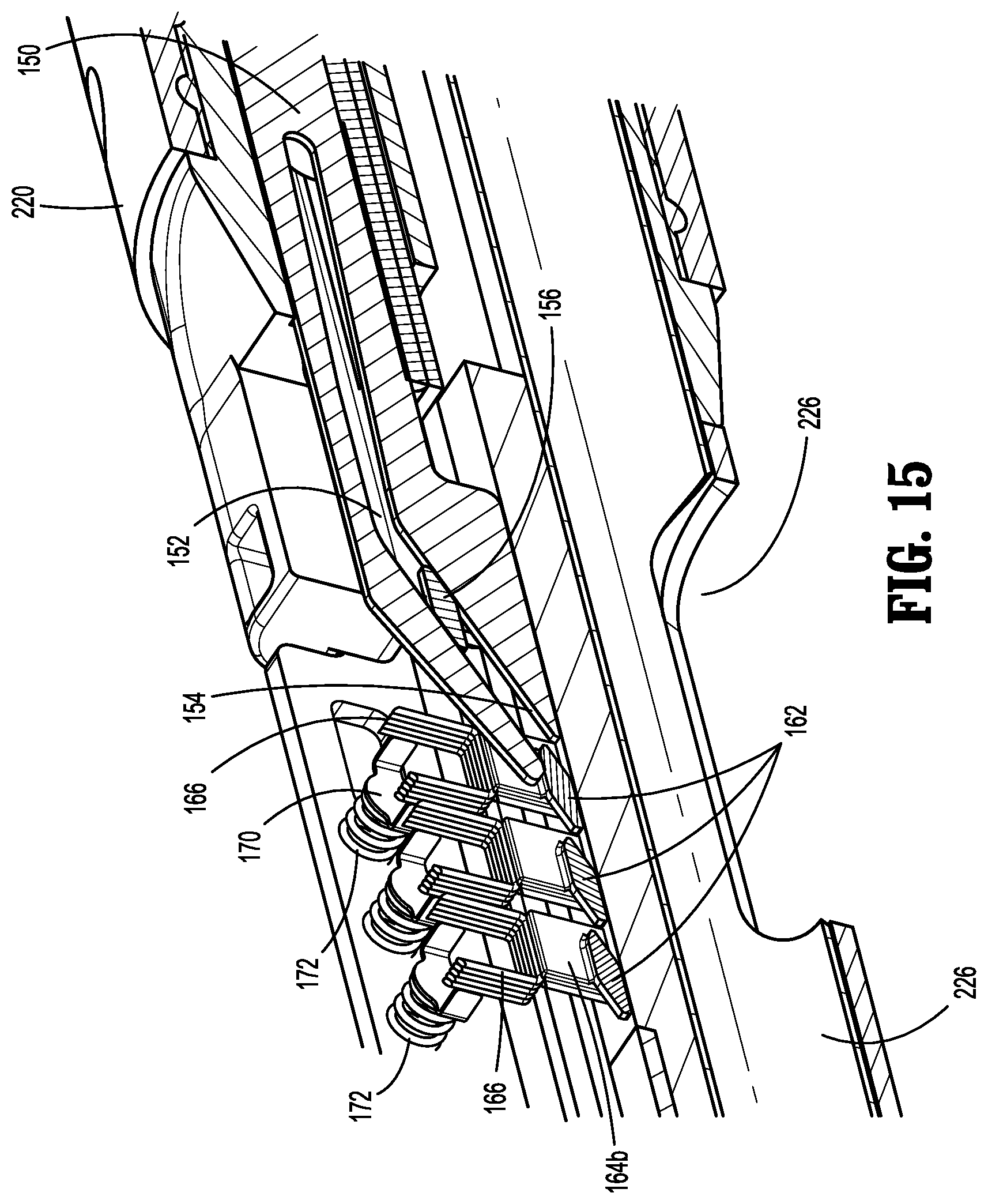
D00013
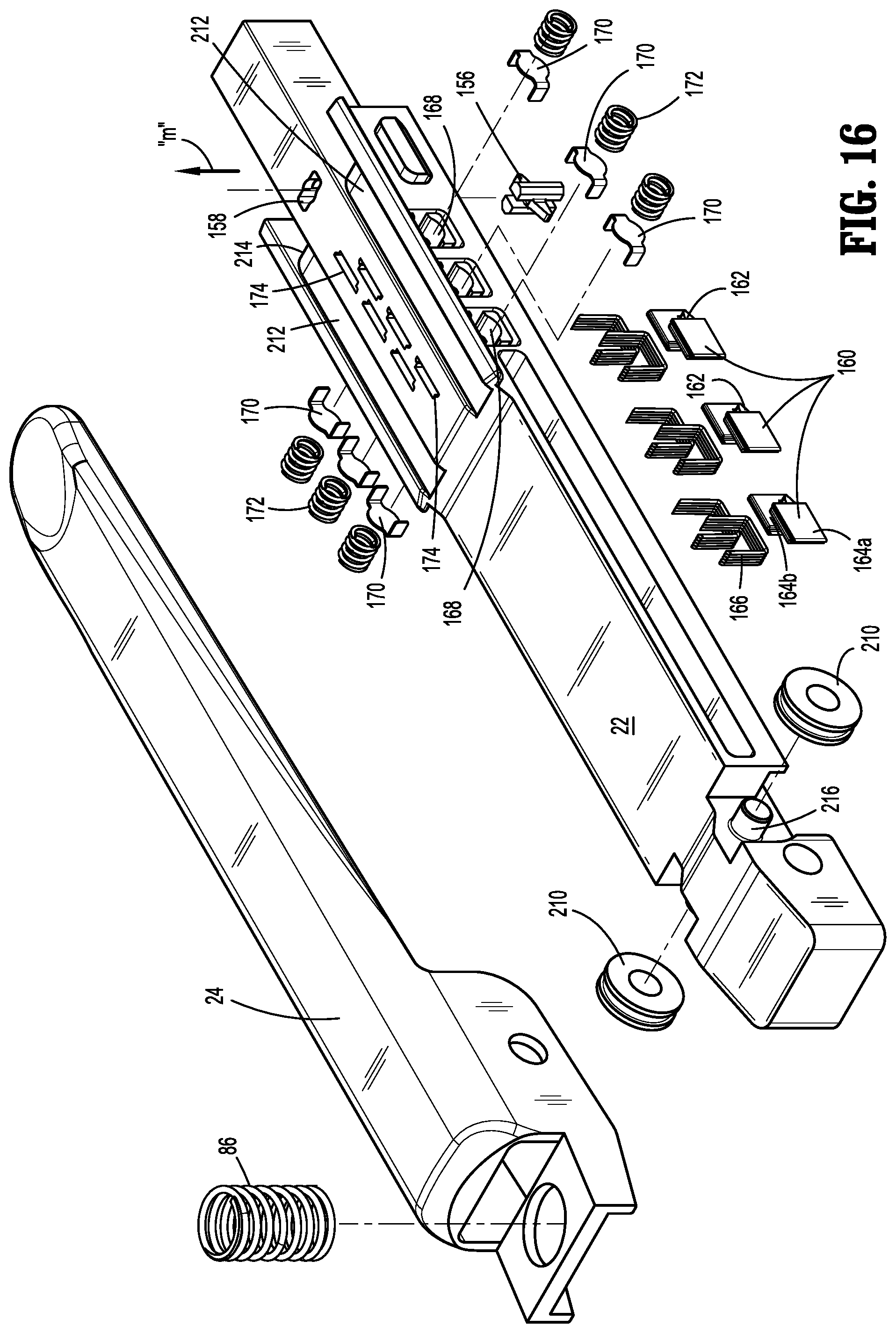
D00014
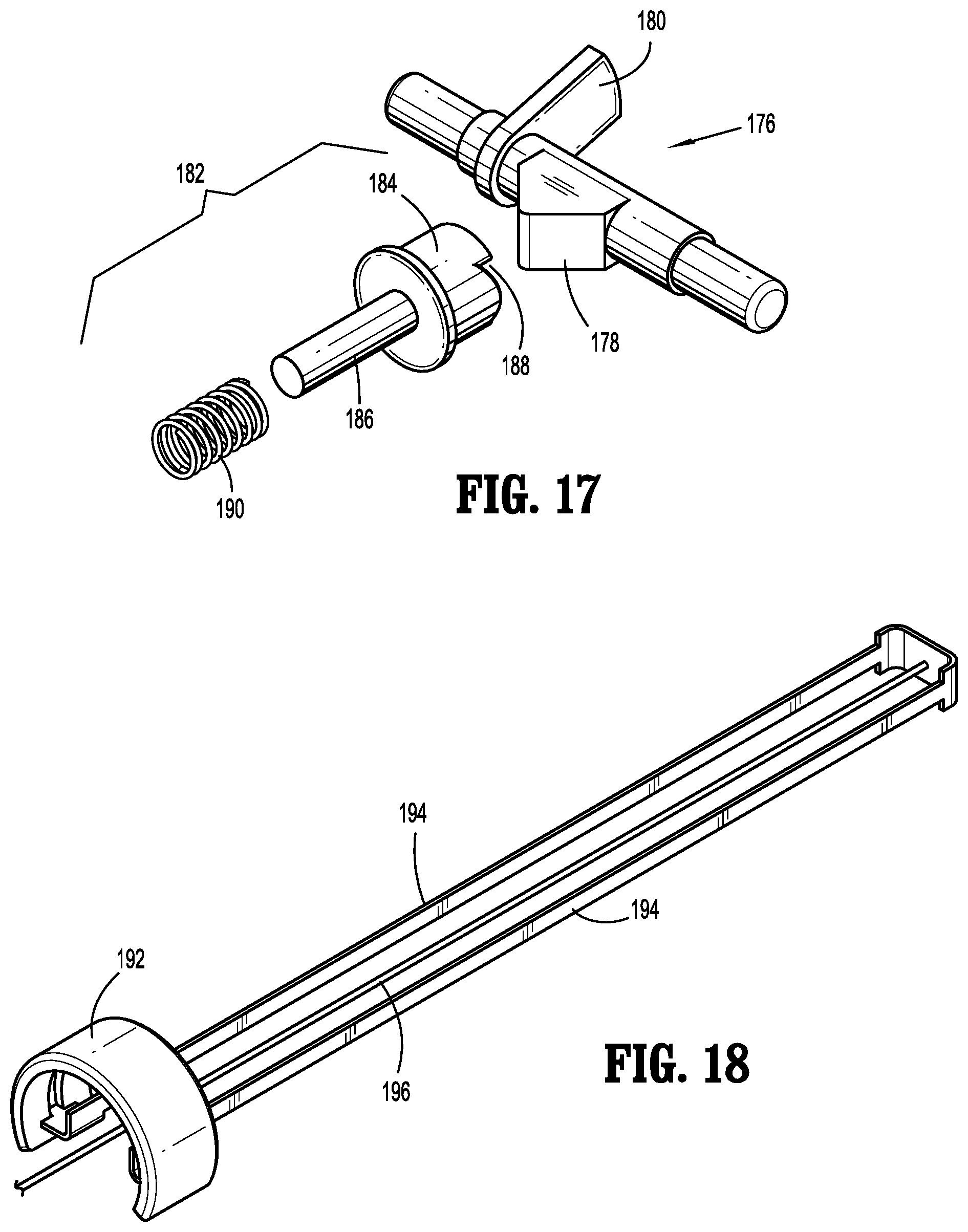
D00015
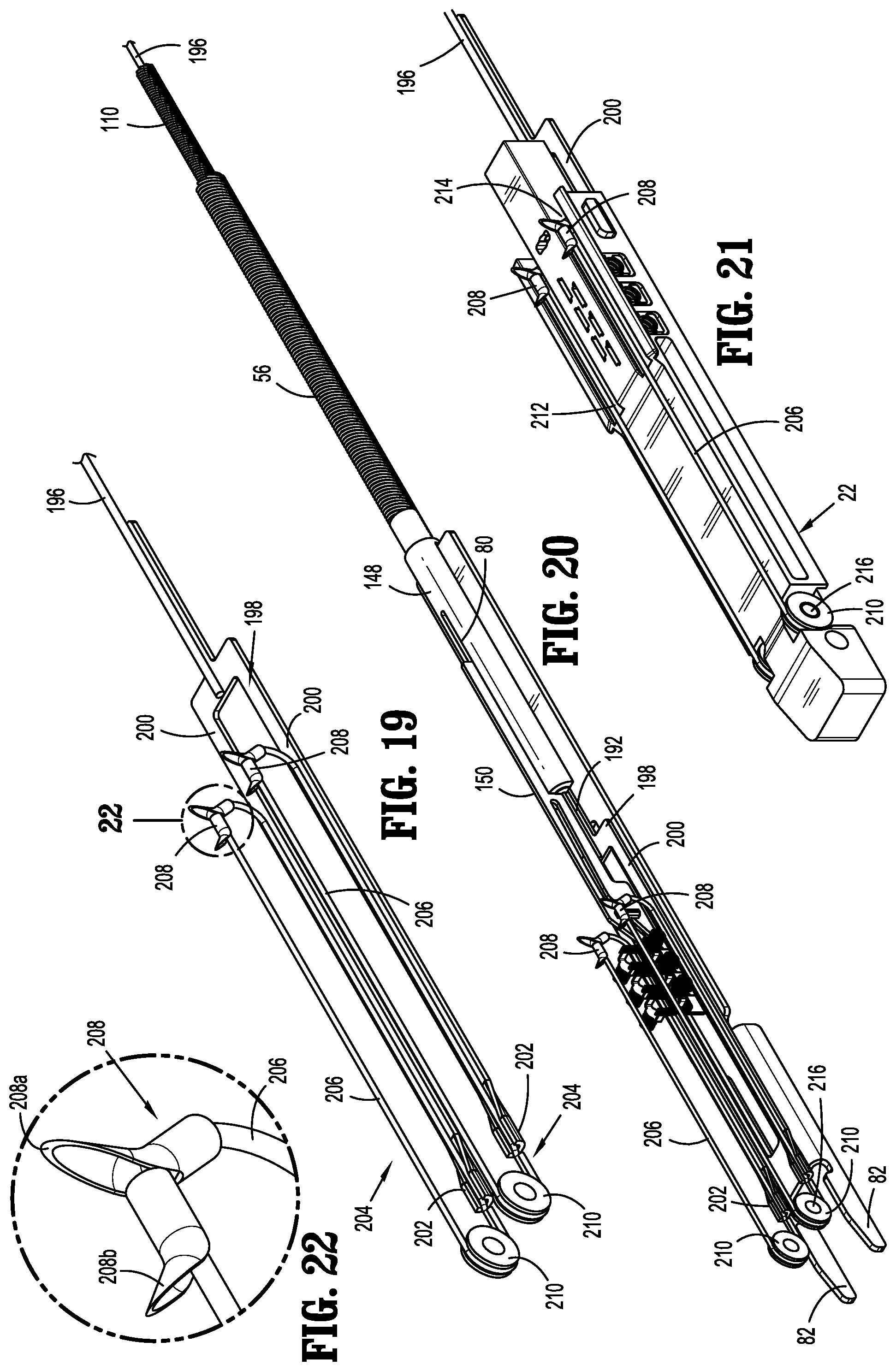
D00016
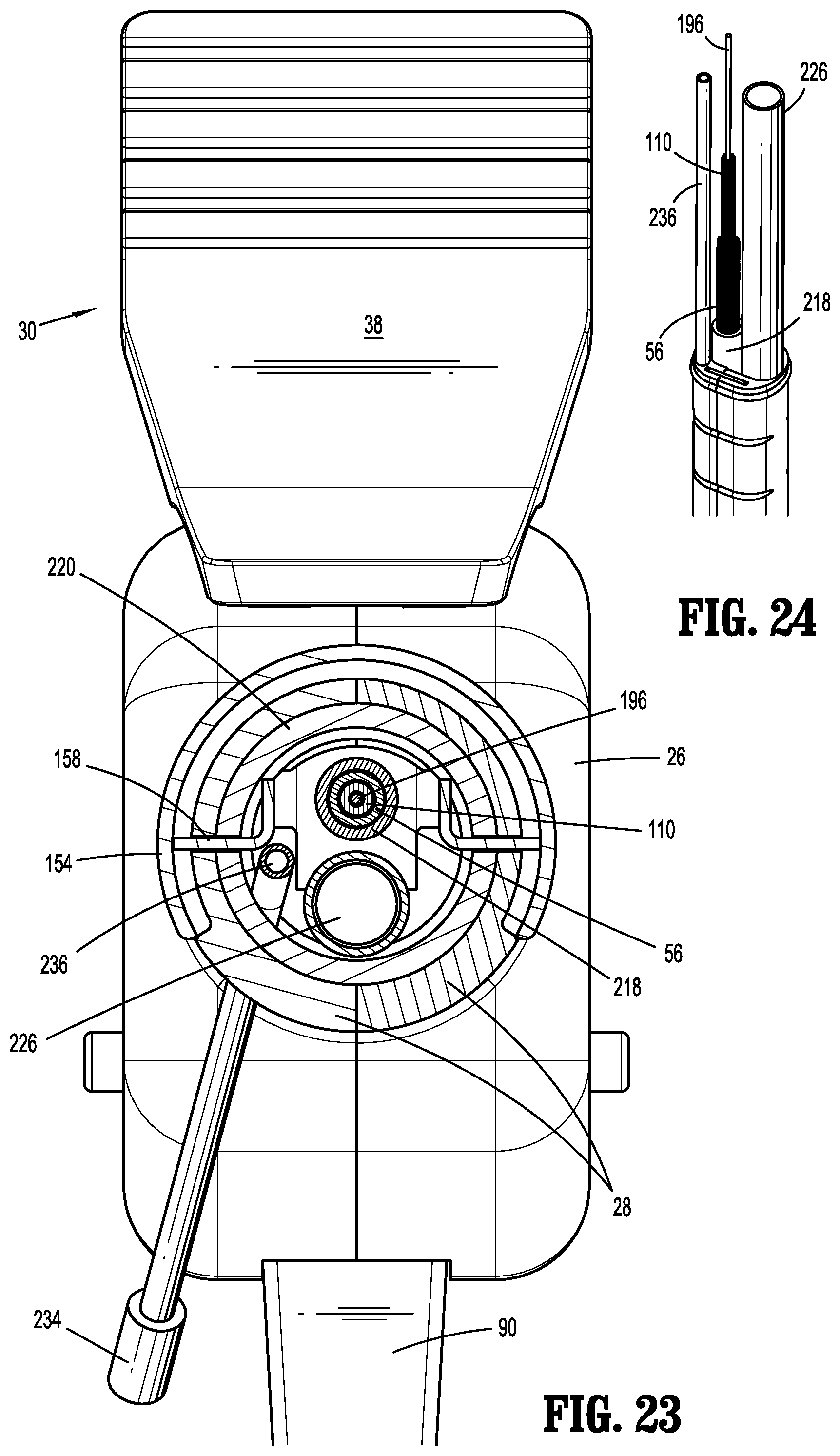
D00017
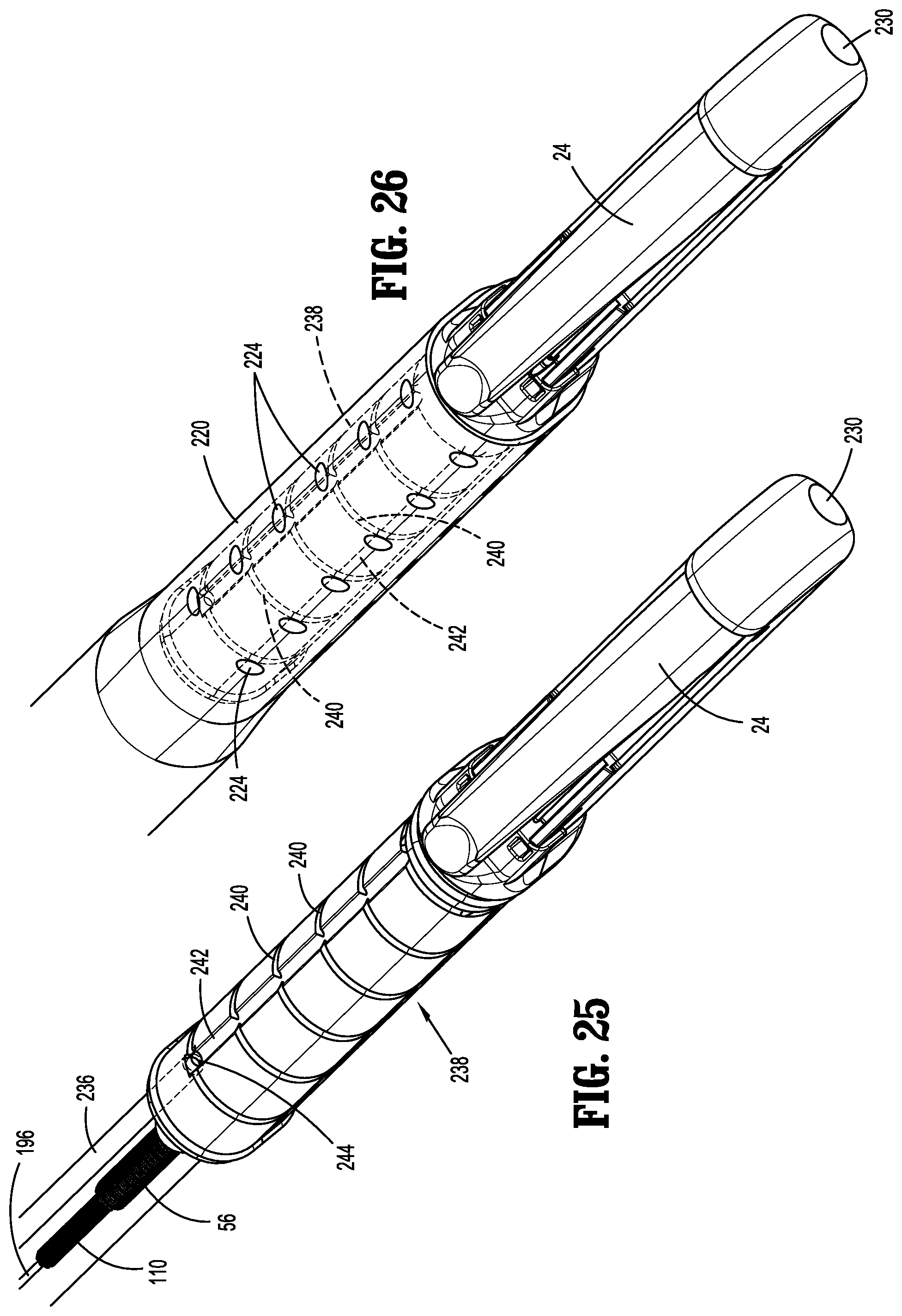
D00018
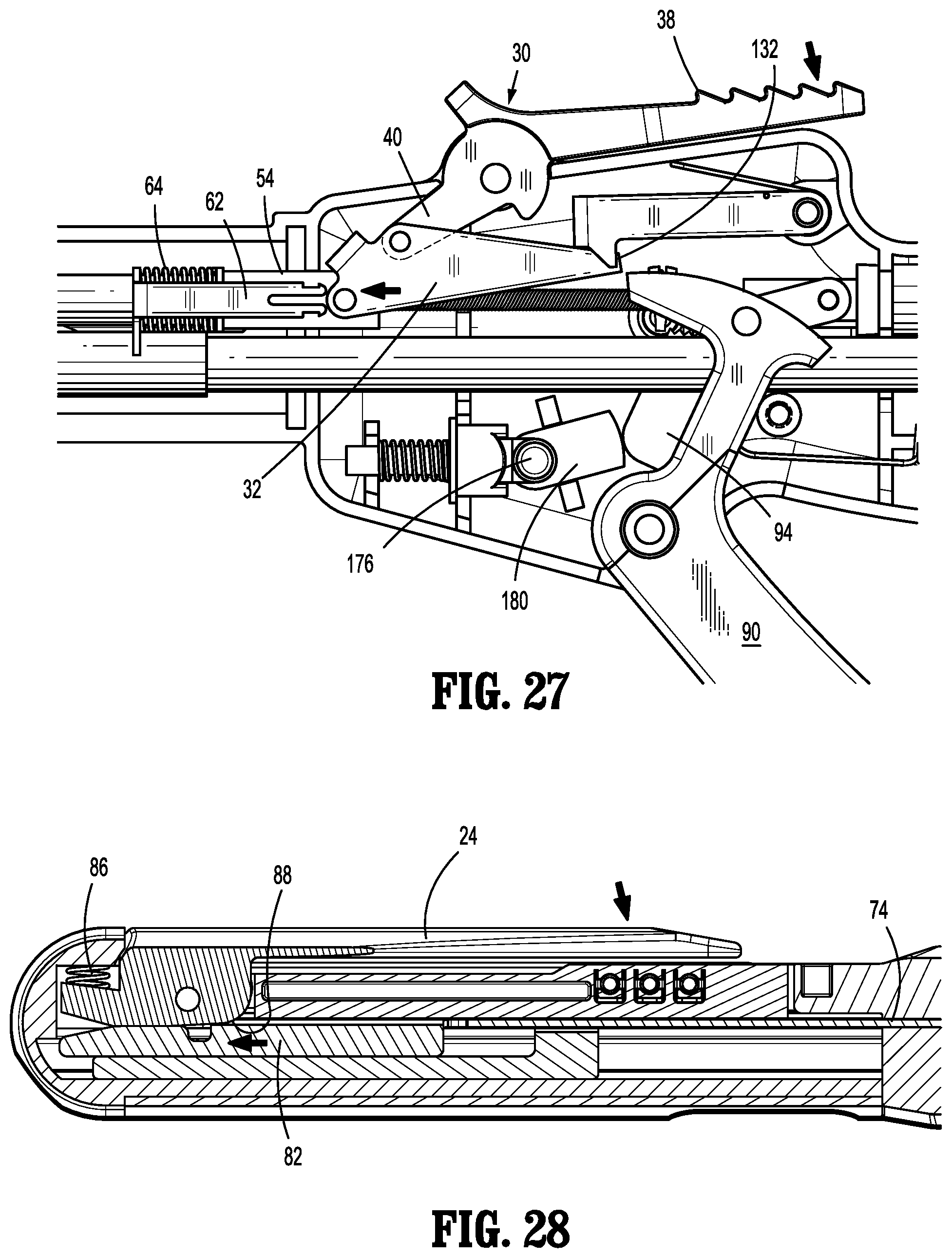
D00019
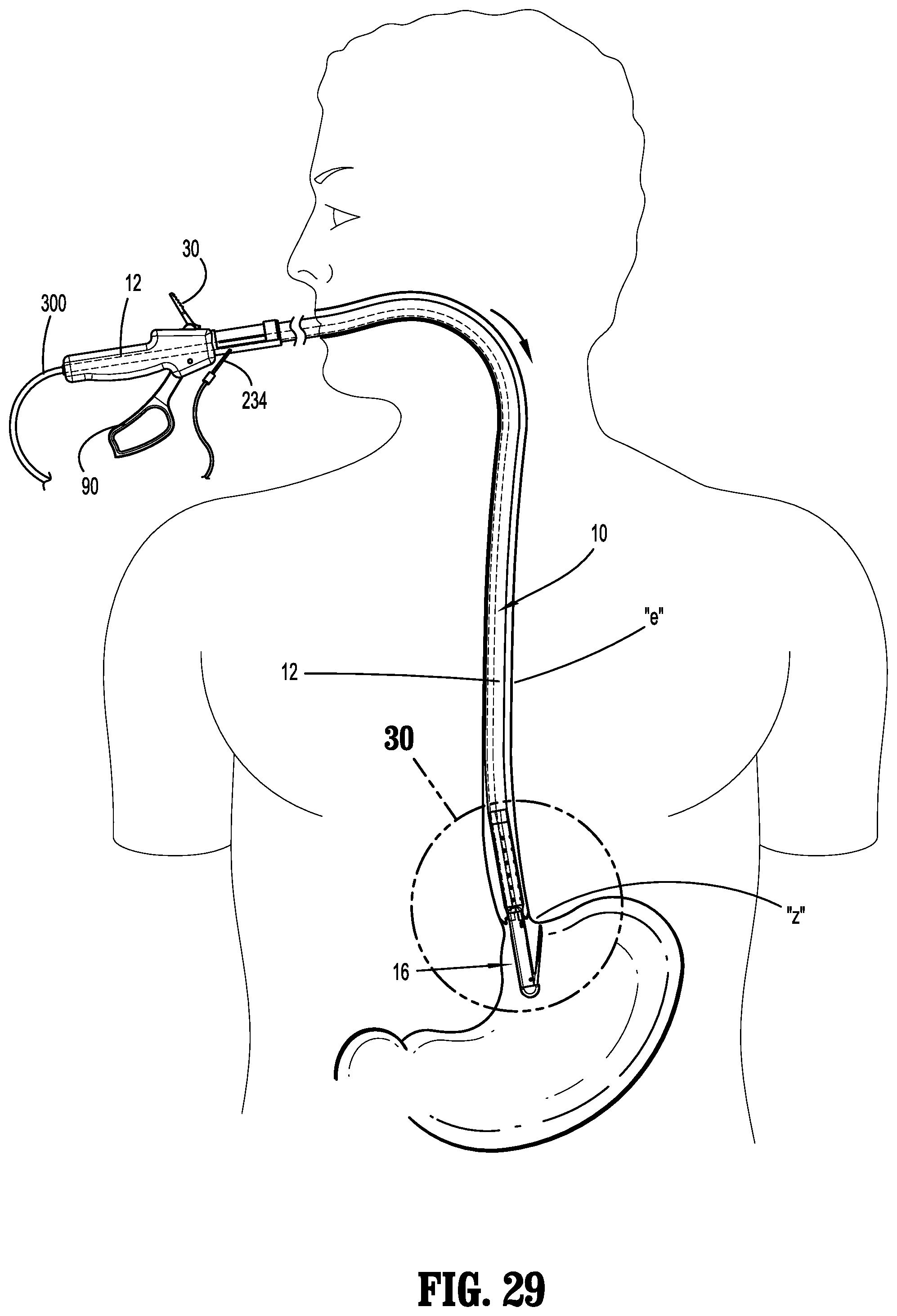
D00020
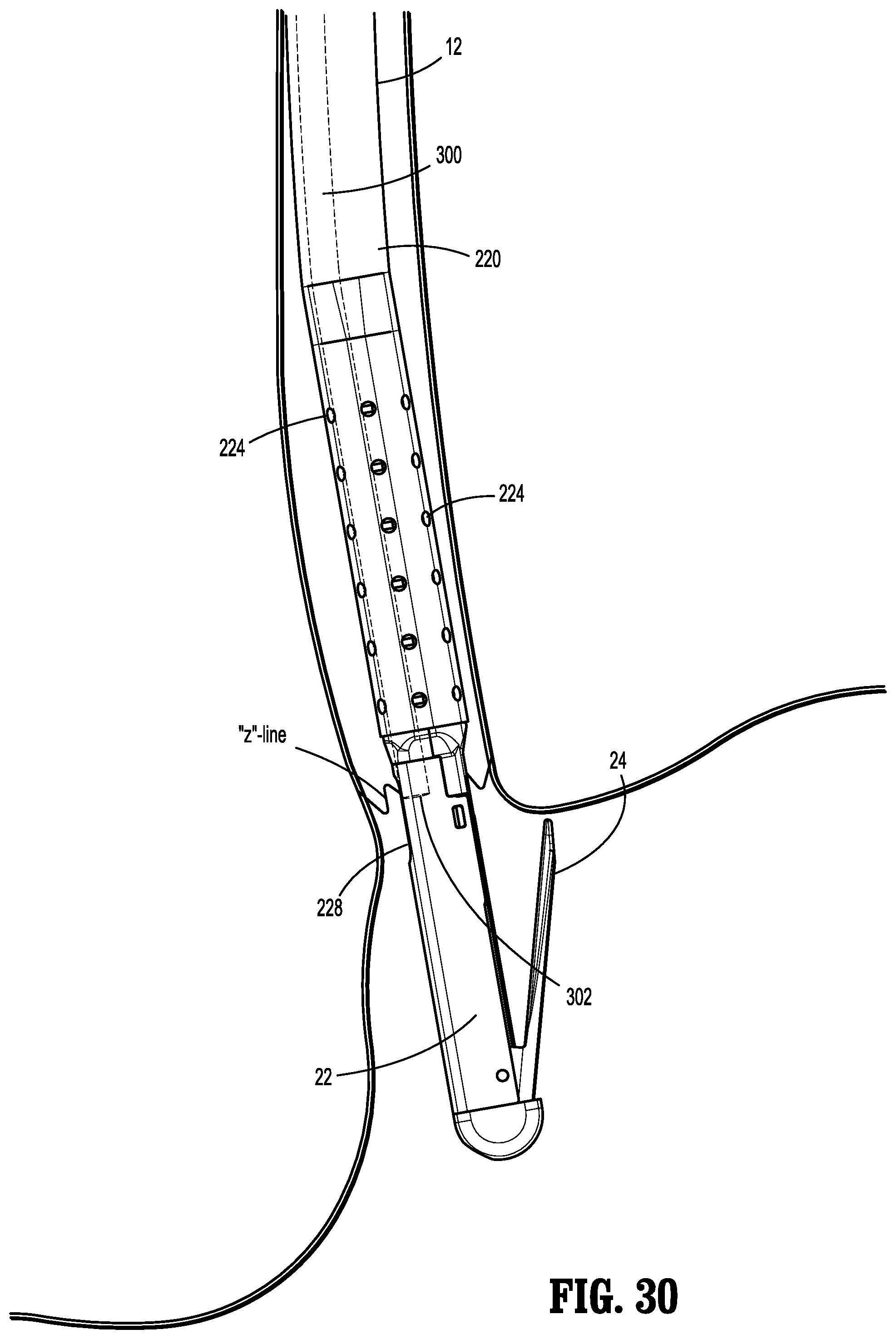
D00021
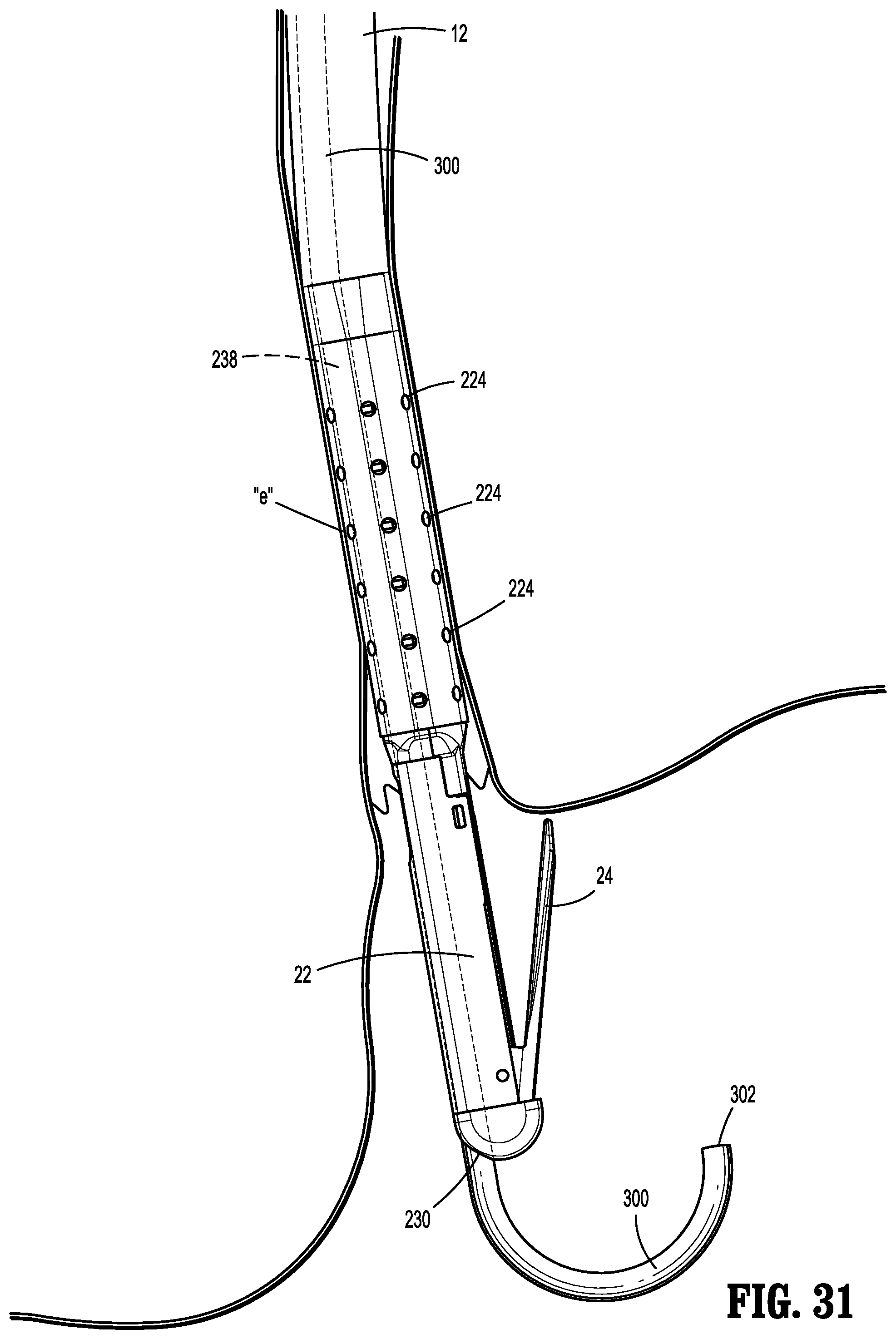
D00022
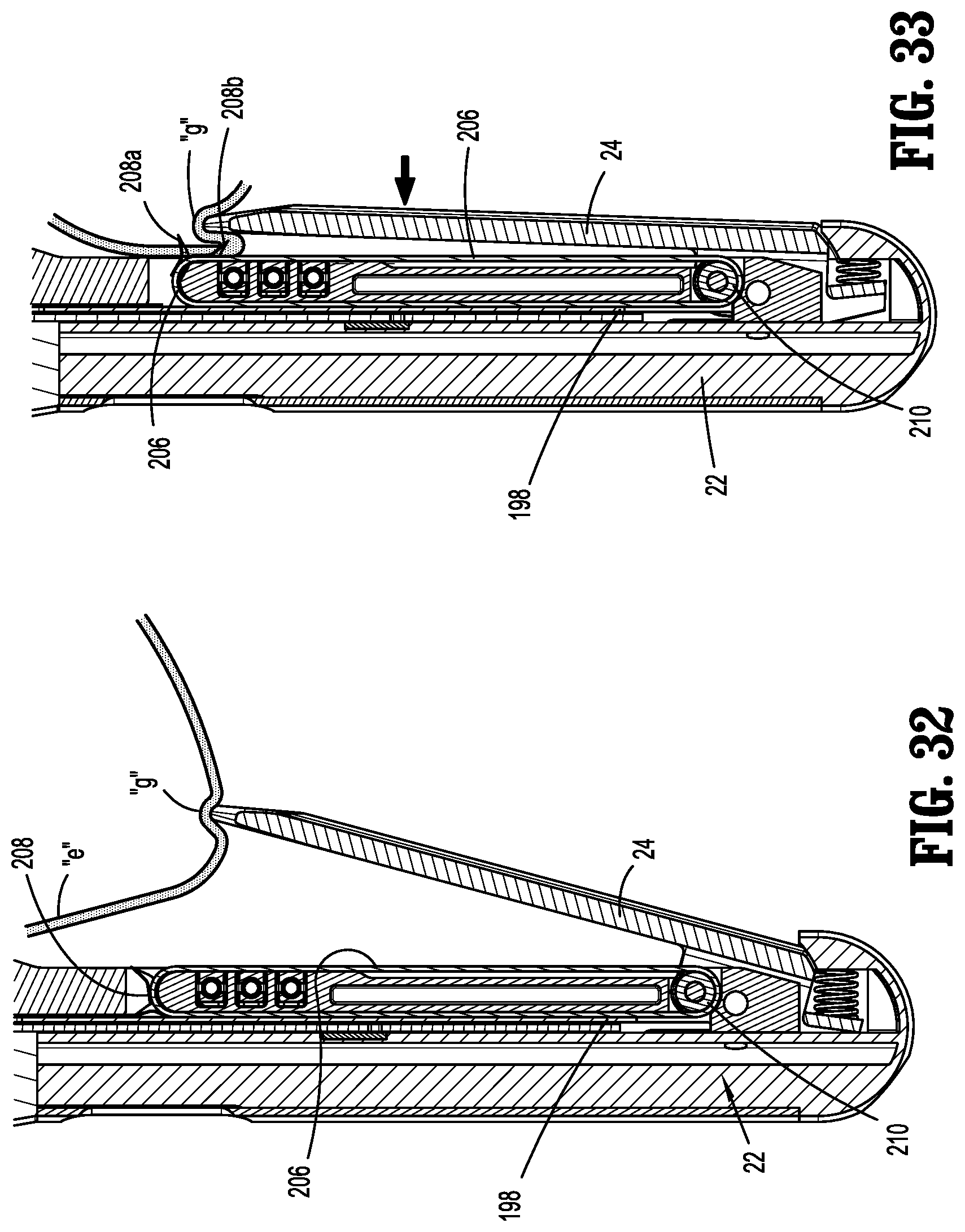
D00023
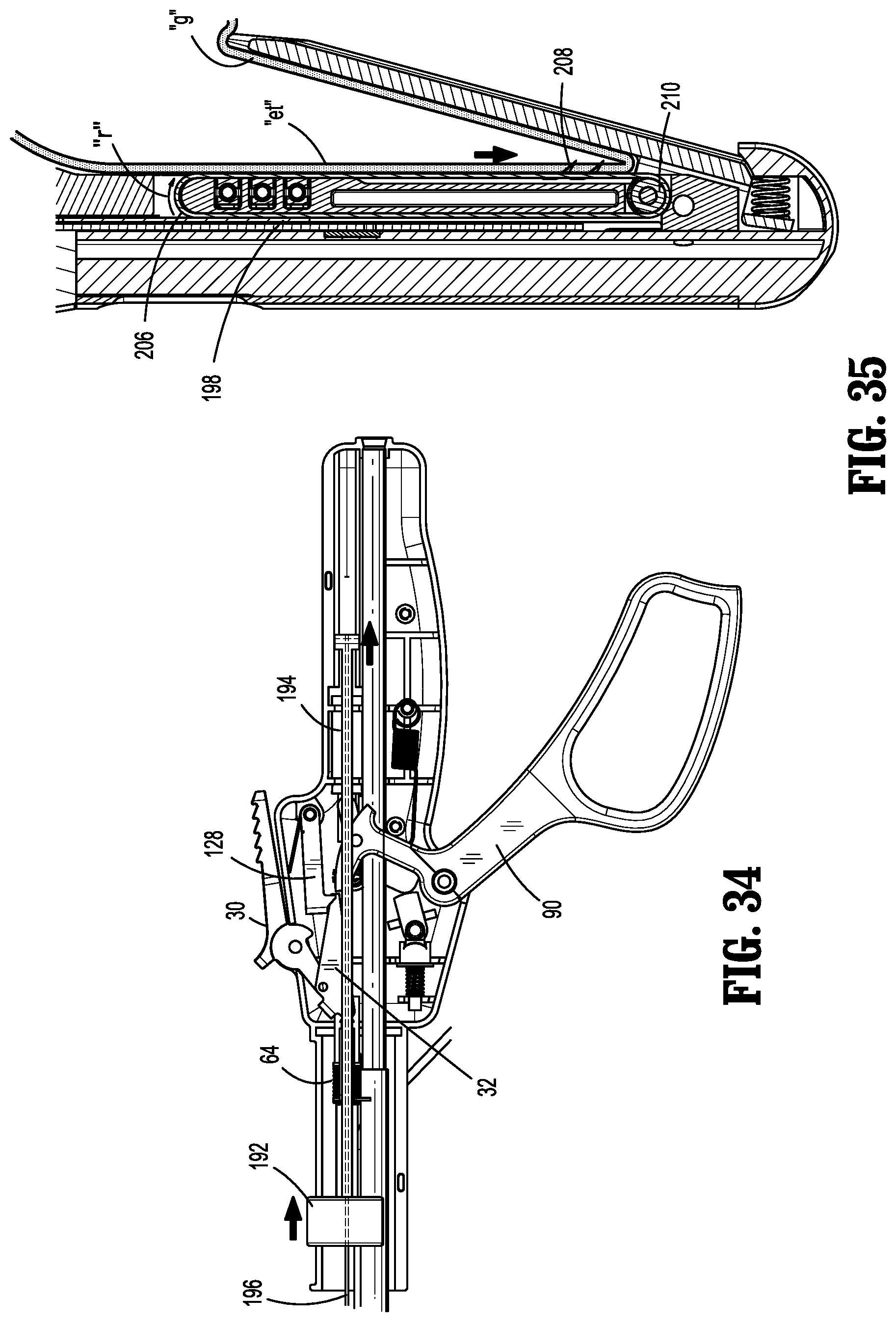
D00024
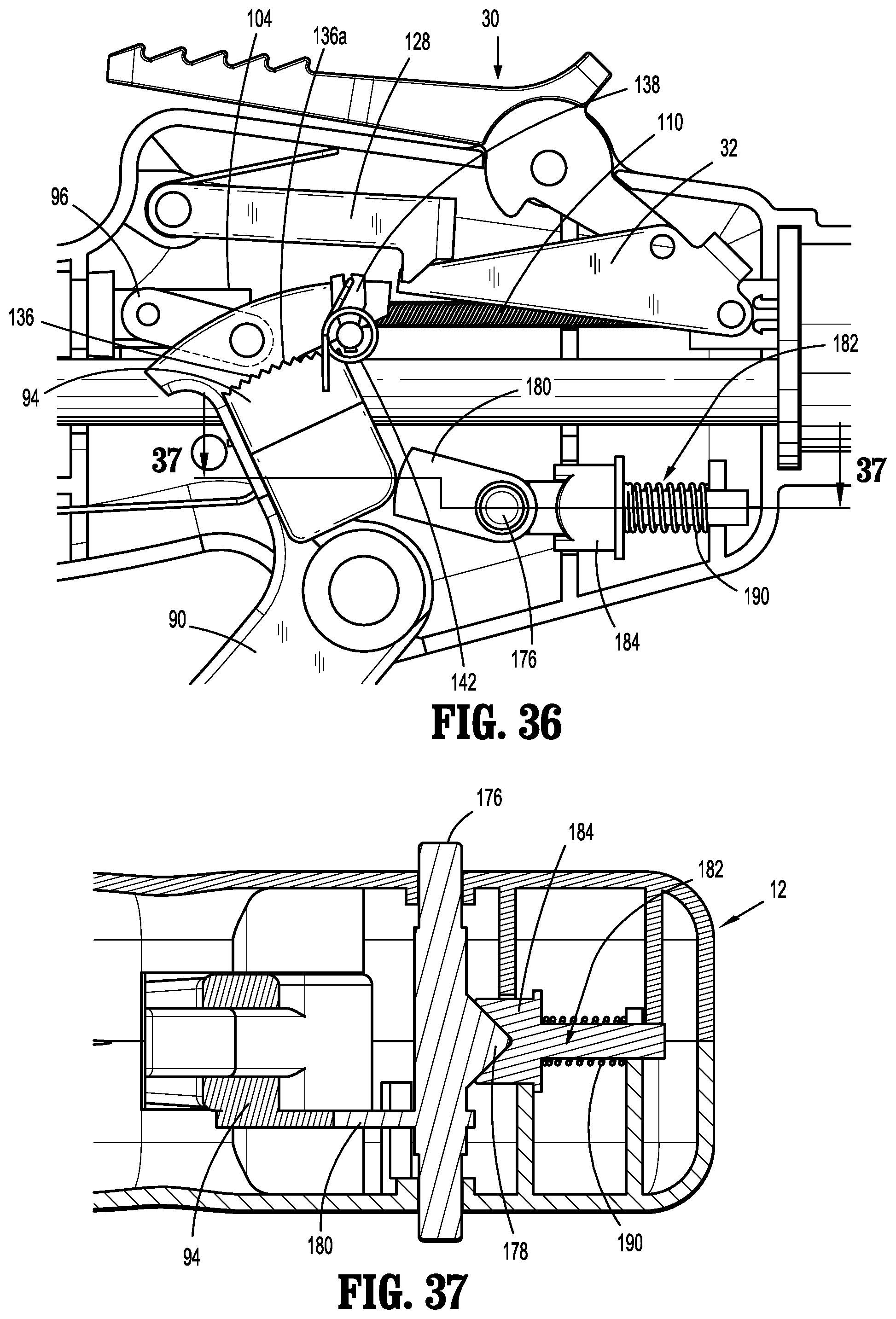
D00025
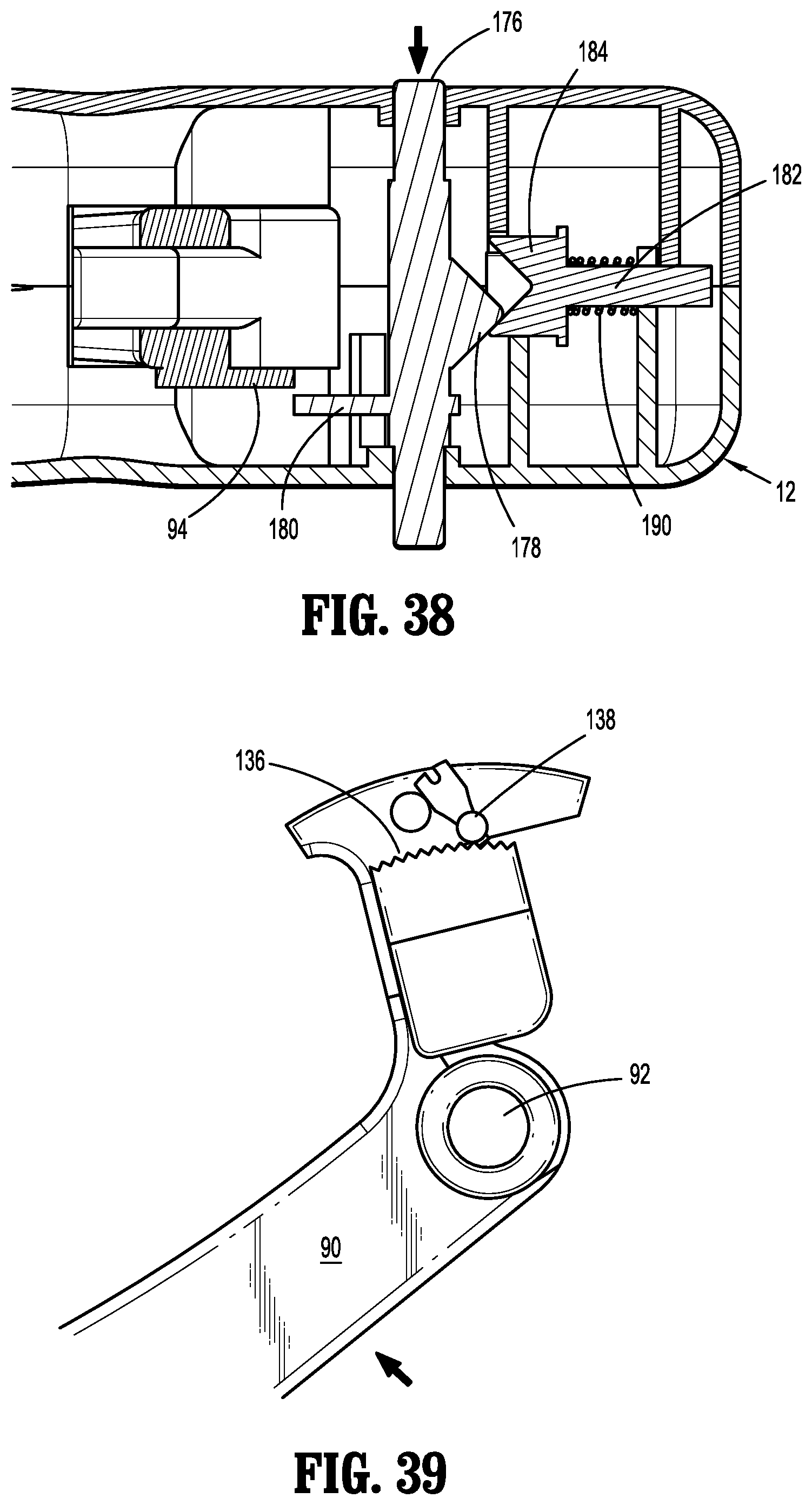
D00026
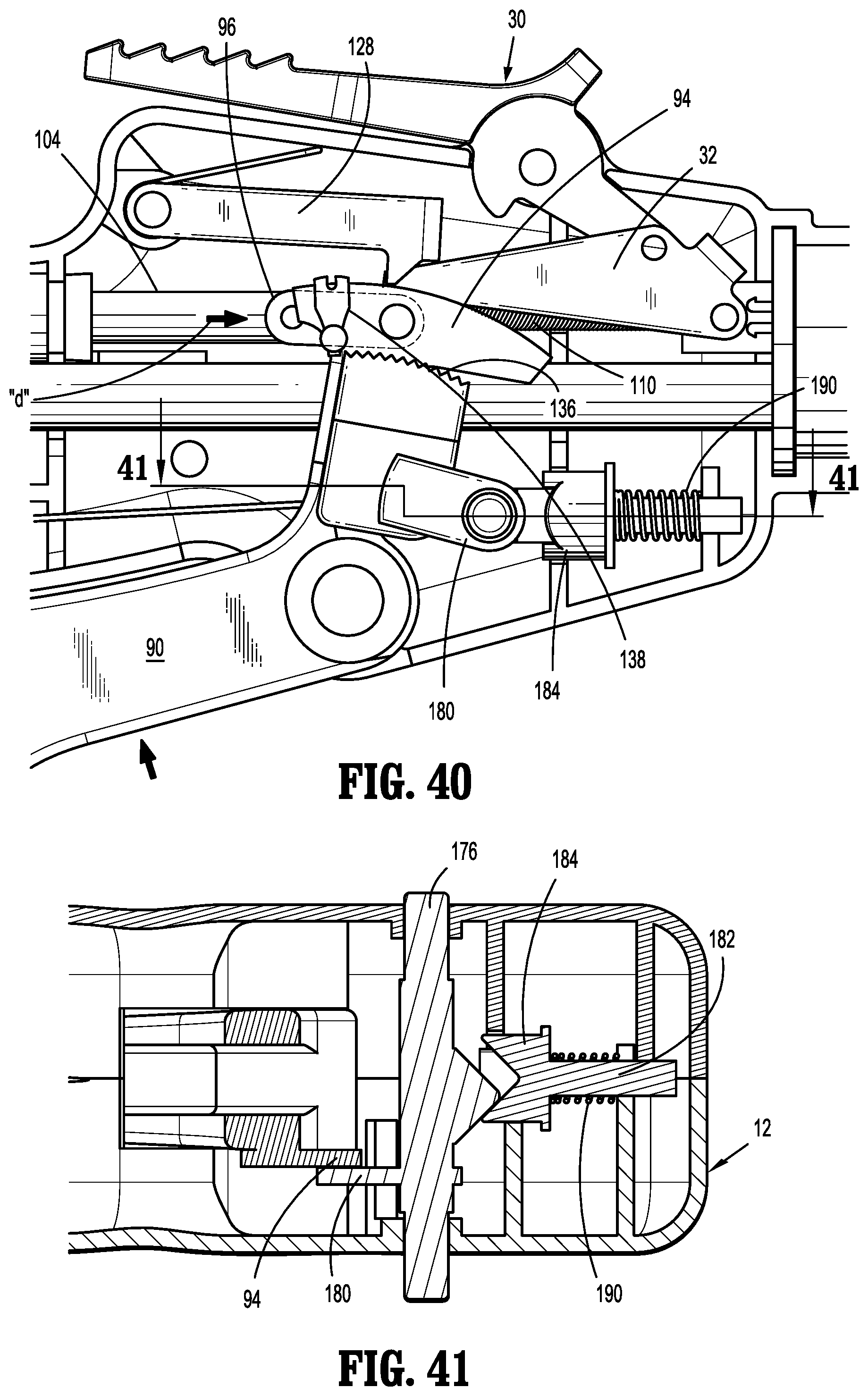
D00027
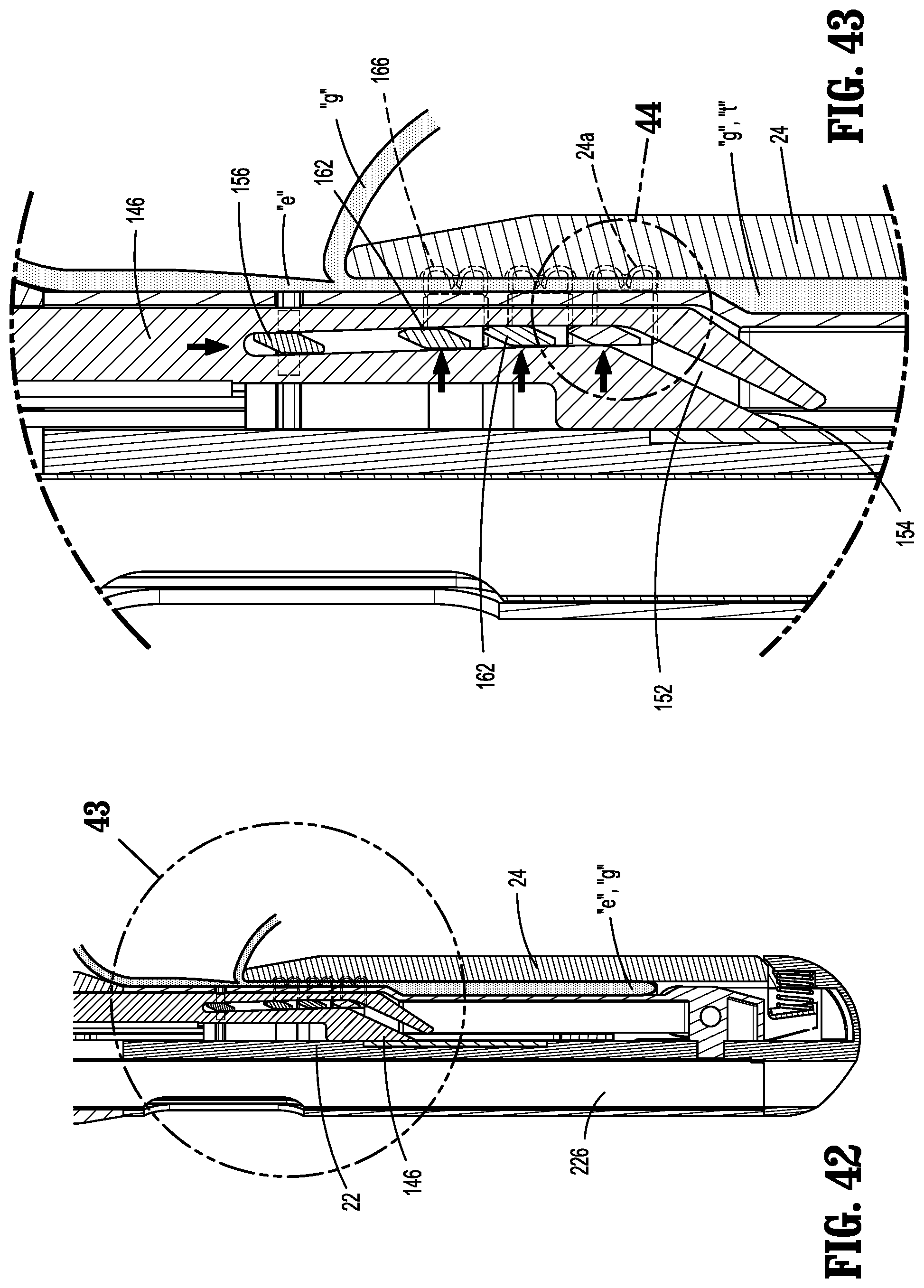
D00028
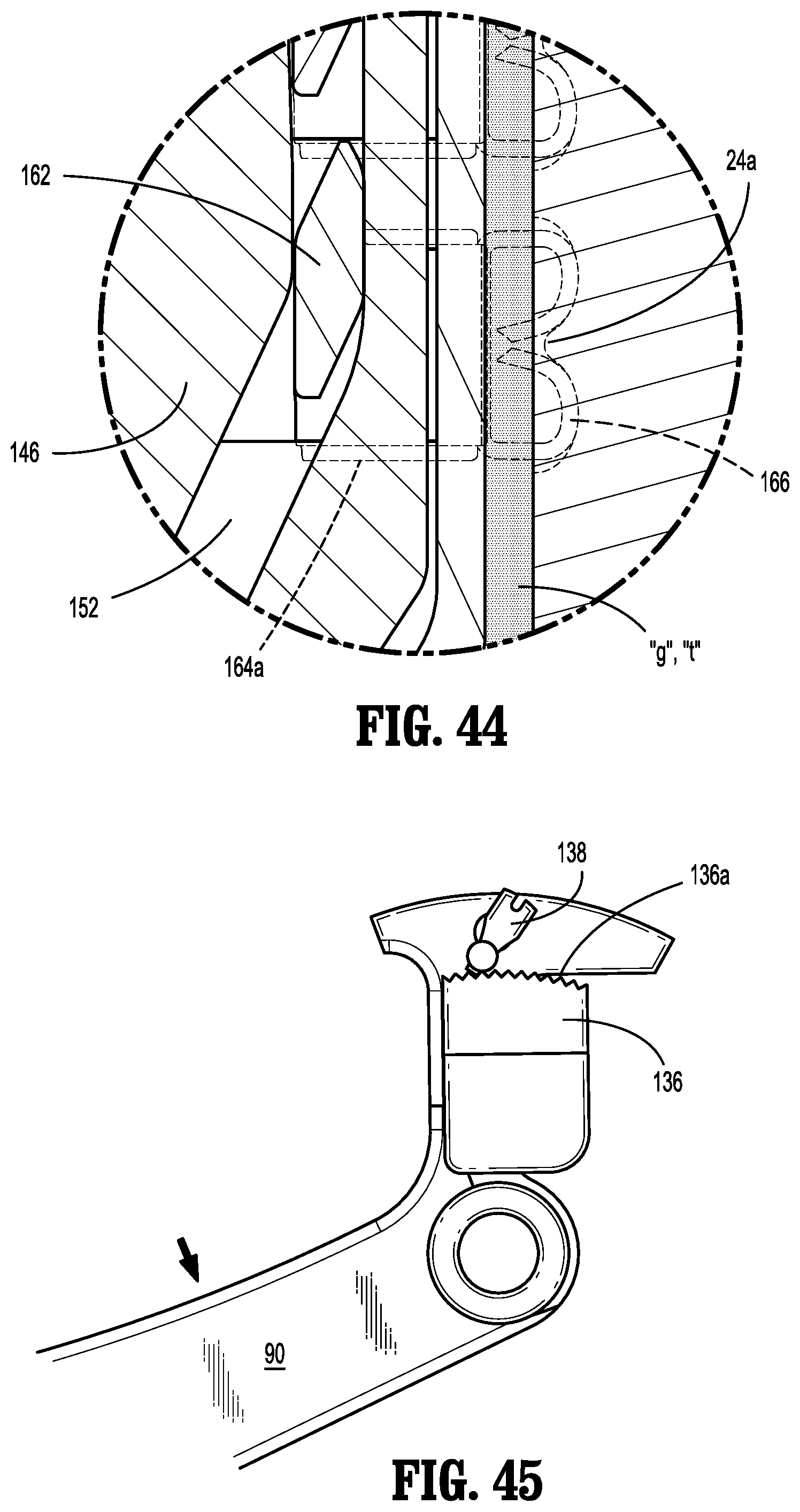
D00029
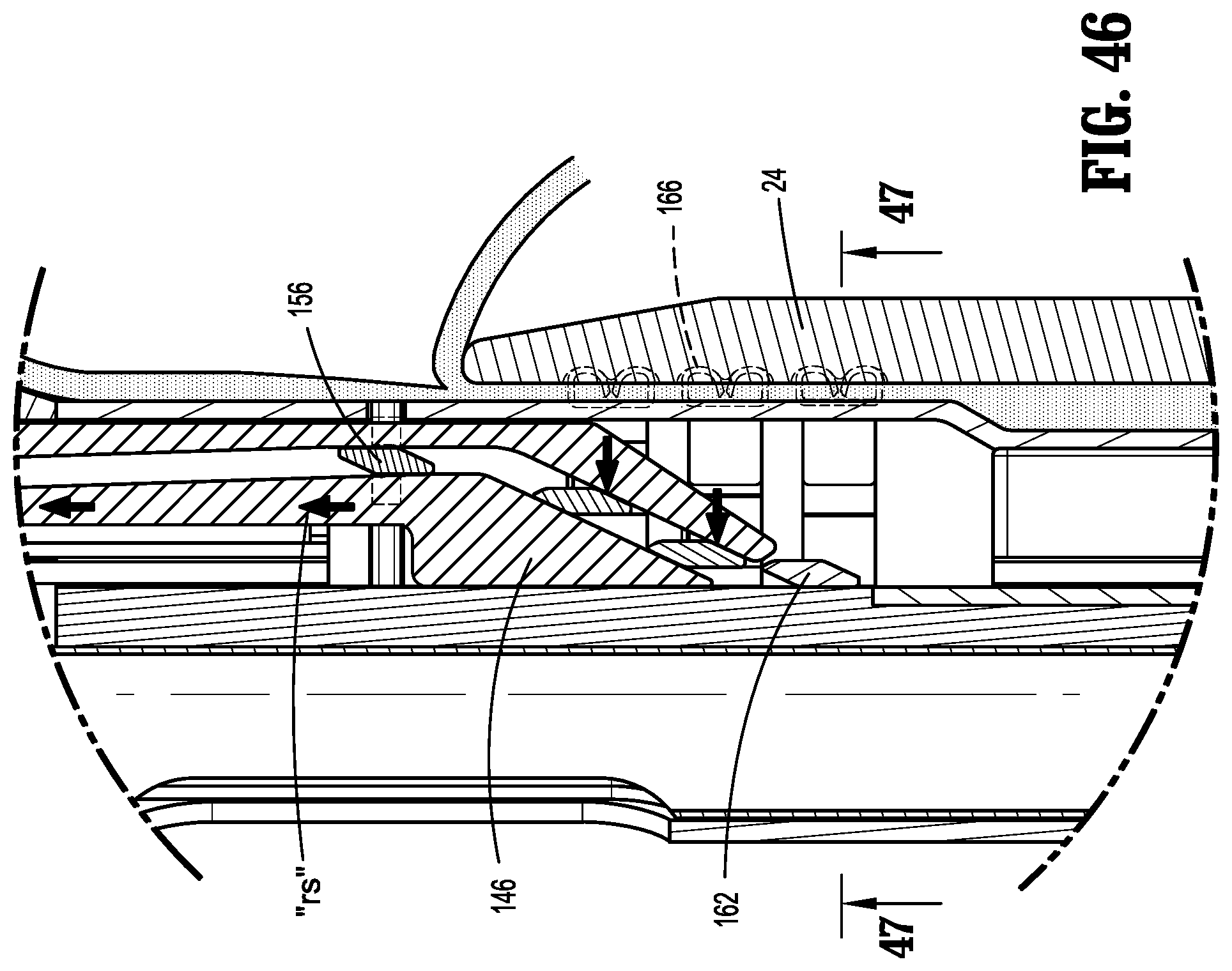
D00030
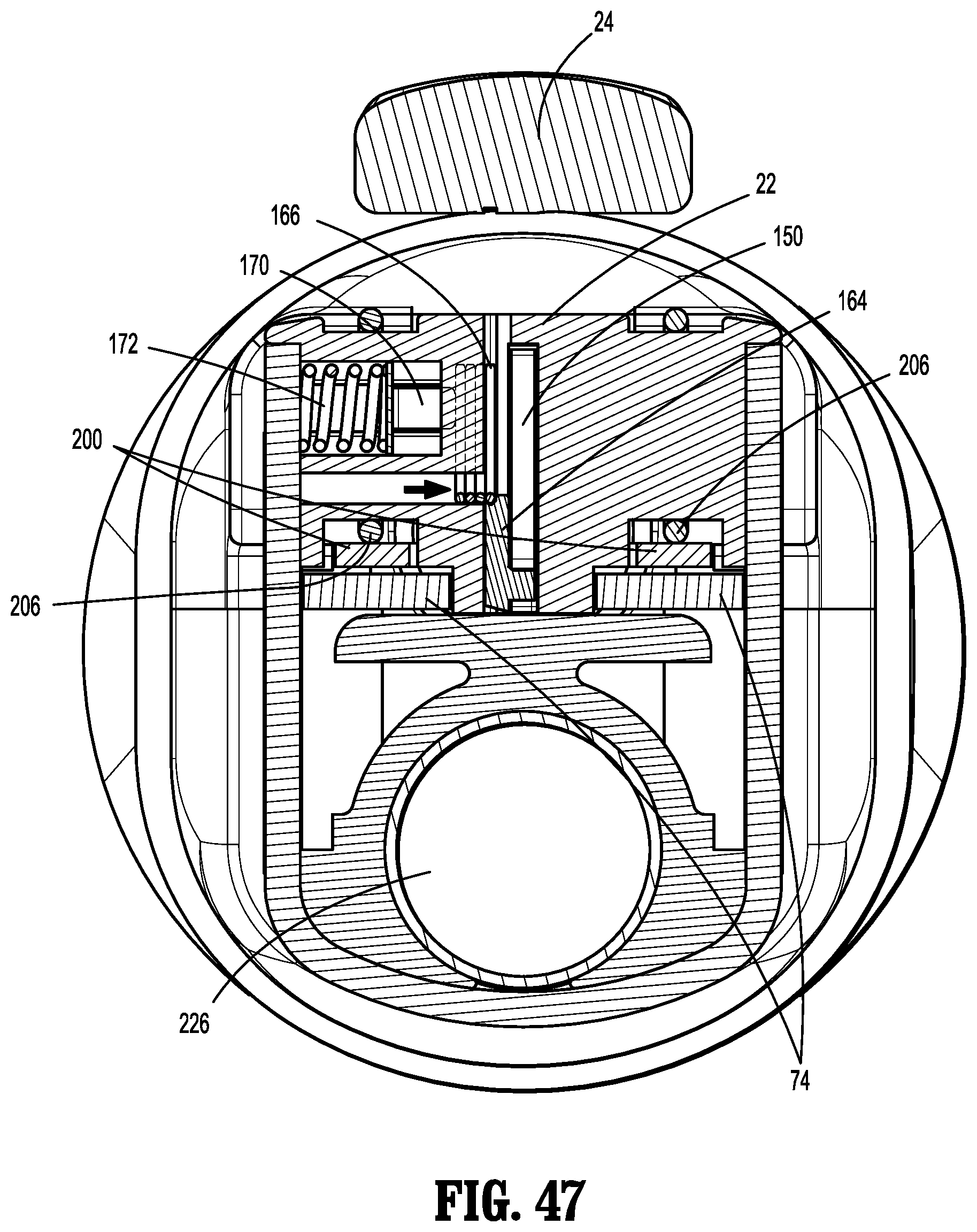
D00031
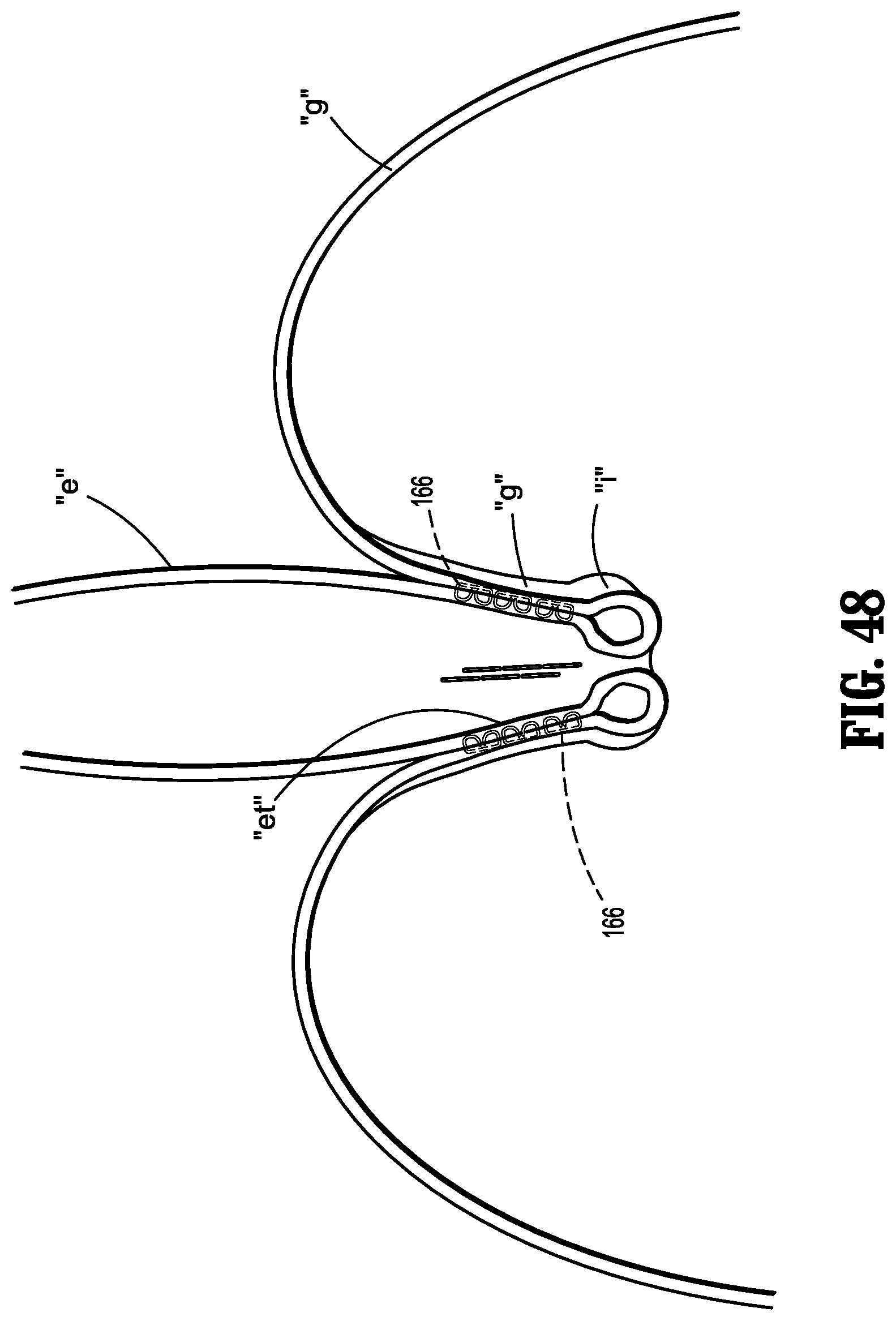
XML
uspto.report is an independent third-party trademark research tool that is not affiliated, endorsed, or sponsored by the United States Patent and Trademark Office (USPTO) or any other governmental organization. The information provided by uspto.report is based on publicly available data at the time of writing and is intended for informational purposes only.
While we strive to provide accurate and up-to-date information, we do not guarantee the accuracy, completeness, reliability, or suitability of the information displayed on this site. The use of this site is at your own risk. Any reliance you place on such information is therefore strictly at your own risk.
All official trademark data, including owner information, should be verified by visiting the official USPTO website at www.uspto.gov. This site is not intended to replace professional legal advice and should not be used as a substitute for consulting with a legal professional who is knowledgeable about trademark law.